How to Calculate Outboard Motor Size for Sailboats
It seems so complex to pick the right engine size for your sailboat. I was done with complex calculations and tried to make it easier here.
How to pick the right outboard motor size for your sailboat? To get the right amount of horsepower needed to efficiently propel a sailboat, divide the displacement of the boat (in lb) by 550. You need approximately 1 HP per 550 lb of displacement or 4 HP per 2200 lb. Most sailboats don't need a motor with more than 30 HP.
In this article, I'm talking about small outboard engines for sailboats. We're talking about displacement hulls here, so in other words: keel boats. They need more power than flat bottoms.
But they're not powerboats - so it's not our mission to go fast. It's our mission to get decent speed, good control over the boat, and the best possible fuel efficiency. Without breaking the bank of course.
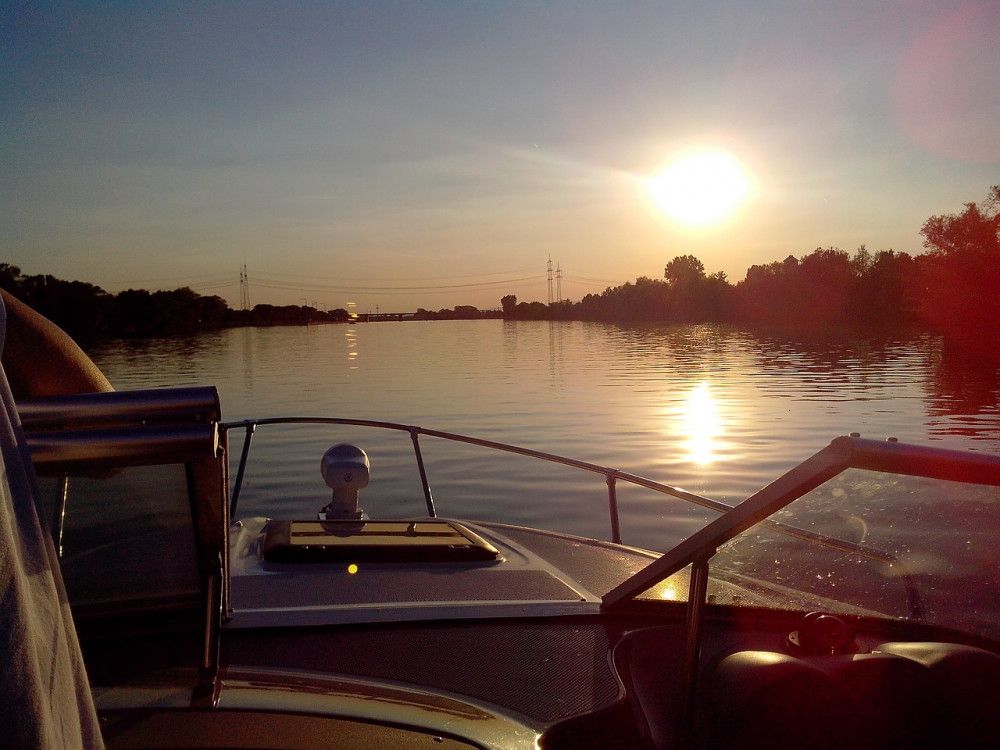

On this page:
How to pick the right motor size, other factors that are important for size, why is the right motor size important, is there a max hp for sailboats, in conclusion, related questions.
Sailboats need way smaller engines than powerboats. That's great news (unless your ultimate goal is speed), because it's cheaper to buy, cheaper to drive, and cheaper to maintain.
The amount of power you need is related to the hull displacement of your boat.
I like to use the simple formula:
HP = displacement (lb) / 550
So 1 HP for every 550 lb displacement, and 4 hp per 2200 lb.
Here, HP is the amount of horsepower you need to reach the maximum hull speed. This is in optimal conditions. So you have smooth water, no windage, a clean and polished hull, and so on.
If you want to get it absolutely right, you also need to correct for propellor size. And of course, a lot of other factors come into play (more on that later). But generally, these engine sizes will work with the following weights:
That sounds about right to me. But remember that these are all rough estimates: I just try to give you a ballpark figure. There is no one formula to get an exact number. The hull design, sailing conditions, and your personal preference are all very important.
If you're serious about getting a new engine, I definitely recommend to get advice from an expert . But you know, salespeople always recommend the Turbo version. Remember that you don't have to overpower a sailboat. Usually you don't need anything over 30 HP. So at least you now know what will work on average.
What is hull displacement?
- Hull displacement is the weight of the boat, or the amount of water the boat displaces.
- Maximum hull displacement is the weight of the boat when it's fully loaded, including crew.
The weight of the boat is the same as its displacement, because the weight of any object is exactly equal to the weight of the water it displaces (aka: pushes aside). This is called Archimedes Principle.
The weight slightly differs in saltwater from freshwater, because saltwater is heavier. In saltwater, the boat gets a bit lighter. So in theory you can use a smaller engine for a bluewater boat, but in practice this is offset by the stronger current and wind.
How to find the displacement of your boat?
Most manufacturers simply give you the displacement of your boat. If you can't find any data, because, for example, you own an old boat, you can weigh your boat on a truck scale. You can also haul it out and measure it (which is painstaking work).**
Tip: if you're gonna weigh your boat, simply drive it onto a truck scale, and retract the weight of the trailer from the total weight.
Of course, it's not so simple. This formula gives a rough estimate. But for me this was way clearer than all that black magic that I get when I ask people what size engine I should get.
Let's look at the things this formula doesn't take into account.
2-strokes are more powerful than 4-strokes. Two-stroke engines fire once every revolution and four-strokes fire once every other revolution. This makes the 2-stroke twice as powerful. They provide more torque at a higher RPM. But they also wear more quickly. The 4-stroke will last you a lot longer, and its also more fuel efficient.
The right propellor size is just as important as having enough horsepower. With a smaller prop diameter, it has to work harder to generate the same propulsion as a larger diameter. But you can't just go larger always. The prop affects the RPM of your engine, and you have to get in the right range (more on this later). You also have to check the maximum diameter that fits your boat.
Diesels have more torque, because the compression rate is higher than that of gasoline engines. So if you consider a diesel, you can do with less HPs.
High windage hulls (multihulls) need a bit more. A multihull (or larger hull in general) suffers from more friction because of the larger surface. So the engine needs to work a little harder.
If you sail longer distances under power , or against the wind it's a good idea to get a larger engine (but not too large). This helps you to save on fuel since you have lower RPM. Especially if you sail offshore or on open sea. The engine needs to work harder due to stronger wind and current.
If you're just sailing in and out of the marina under power, you may need less HP.
Smooth hull designs need less HPs than bulky hull designs, like the classic wooden clippers and crabbers for example.
It matters to get the right size outboard motor for a couple of reasons.
First of all: smaller engines are cheaper, so you save money on buying the engine.
Secondly: smaller engines use a lot less fuel, so you save money on using the engine.
Thirdly: smaller engines are cheaper to maintain: so you save money on maintenance.
So why not get the smallest engine and get the best fuel economy? There are a couple of advantages to getting a (slightly) bigger engine:
- More power means more control (easier to stop the boat, in case you need to)
- Finding the sweet spot might actually reduce fuel consumption
The sweet spot
To perform optimally, an engine should get up to speed. The problem with an overpowered boat is that the engine won't rev up to 80 - 90% of the RPM. This kills fuel efficiency and also the cooling system won't operate optimally.
- The optimal cruising RPM of the engine is about 85-95% of the maximal RPM
- You should reach cruising RPM at hull speed, so your engine should be at about 90% RPM
The propeller size is very important for the RPM. If your prop diameter is too wide, the engine can't get up to speed and struggles to build power. Bad for fuel economy, bad for the engine, and bad for performance.
On the other hand, if your prop is too small, you don't make use of the engine's full power.
If you struggle to get to high RPM, your prop is too large. If your engine is constantly in the red, you're underpropped.
So don't go too big on the prop, but also don't go too small. The easiest way to get it right is to check the engines manual and see what the manufacturer recommends.
You can definitely go too big on a sailboats engine. An overpowered yacht doesn't make any sense. True, it can look cool, but it can't feel cool. Every displacement hull has a maximum hull speed. That means that it cannot go any faster than the max speed. So if your engine can cruise at that speed, it's not getting any better.
The problem with displacement hulls is that they displace the water, or in other words: they push the water in front of them. They cannot move any faster than they can push away the water. And because the resistance increases as speed increases, there's an absolute, physical speed limit for each keelboat.
That's why powerboats have to get out of the water to reach top speed.
Fun fact: the longer your boat, the higher the hull speed. Want to know the maximum hull speed for your boat? You can find it in this article .
So, you can't go faster than your maximum hull speed, so a 50+HP engine is kind of ridiculous. Bear in mind that a large engine also has the following disadvantages:
First of all: larger engines are more expensive, so you spend more money when buying the engine.
Secondly: larger engines use a lot more fuel, so you spend more money when using the engine.
Thirdly: larger engines are more expensive to maintain: so you spend more money on maintenance.
Also, if your engine is too big, it doesn't reach the optimal cruising RPM, so your fuel economy also gets really bad FAST.
I suggest getting the smallest possible engine that gets you to maximum hull speed while it's at roughly 90% of the RPM. As long as it gives you enough control and good handling, it will get you there. If you give up on going fast, you can actually get really good fuel economy and your engine will last you probably 20 years.
If you want to go fast, a sailboat is not the right one for you. You should instead get a powerboat.
I'm just kidding. Read my 13 Reasons Why Sailing is Better Than Powerboating here .
Do sailboats have motors? Most sailboats are power assisted boats, which means they have a small auxiliary engine to cruise in light air. When a sailboat is sailing under engine power, it is considered a motorboat and it doesn't have right of way.
Thanks for answering my questions.
Taylor Bishop
Thanks for explaining how you can figure out what size you need for an outboard motor. You mentioned that you should find the displacement by weigh a boat on a truck scale. I’m interesting to learn if you need to regularly weigh it in case the hull displacement could change or if it will always be consistent.
Shawn Buckles
Hi MitI, you’re welcome, my pleasure.
Hi Taylor, my pleasure.
You don’t need to weigh your boat regularly, as the hull displacement will stay consistent. You could literally see the hull displacement as the amount of space your hull takes up in the water. So as long as you don’t make any major changes to the hull shape or ballast of your boat, you should see no differences in displacement.
Roger S Johnson
How do you measure for shaft size, most outboard motors are for flat bottom and say measure to the bottom of the boat, most sailboats tapper to the aft. Where do you measure for a tapered bottom sail boat?
Will a 5 horse Honda 4 stroke be ok for a 25 foot Pearson Commander sail boat. Thanks for your time Luke
I think it would be Luke.
Great post, thanks for the info. A naive question from a soon-to-be sailor: I’m considering buying a 28 ft sailboat, with 2500 kg (ca. 5500 lbs) displacement. The engine is in pretty good condition, but is old and the original one (from 1977!), so I am also thinking of an alternative scenario in which it fails. I know that in my area replacing an inboard engine will cost double the price I’m putting down for the boat, and since I’m on a budget, that simply won’t be an option and outboards seem to be cheaper. So the question is: is it possible to put an outboard engine on all boats? Is there some factor that would make it impossible to mount an outboard engine on the boat? Thanks!
Garth Powelson
What is minimum length that a sailboat can go without an outboard. Does a 29’ “require by law” to have engine?
Hello Mr. Buckles, Thanks for the informative article. I’m looking to get the smallest possible outboard for my 1.5 ton displacement fiberglass monohull Hood 23’ sloop. Can I get away with a 4HP?!? What size prop would I need?!? (I’m only going to use it when there is NO wind, and, if I can stay 4HP or below, I am not required to register my vessel—which is pretty cool, so here’s hoping!)
Thanks again, Ship
Hi, I’ve got a older Pearson 39’ . I’m looking to remove the old 40 ho westerbeke and go electric. Unsure of what hp is going to be needed?
emilio h javier
i am purchasing a catalina 22 ft. i have in mind a 4 HP motor. what would be the length of the shaft.
I am considering buying a 25 ft sailboat with a 7200 lb displacement. The boats top speed is listed at 7knots per hour but the diesel motor does not work. The owner has a 9.9hp outboard that can be purchased with the boat. Is 9.9hp enough to power the boat to at least 5 to 6 knots per hour? Thanks. Rick
What weight outboard would be too much for a 20’ Santana, displacement 1,350 lbs? I don’t want too much weight at the back. I want the boat to be seaworthy.
I have not seen this amount of BS in years :) I’m not a marine engineer, yet physicist & avation engineer. You even can’t tell the difference between mass of the vessel and diplacement :D Fcking genius.
Leave a comment
You may also like, life-expectancy-of-marine-diesel-engine.

How Much Fuel Does a Sailboat Use?
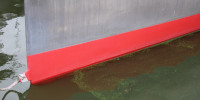
How Often Should You Antifoul a Boat?

3 Ways to Convert Your Winches to Self-Tailing
Own your first boat within a year on any budget.
A sailboat doesn't have to be expensive if you know what you're doing. If you want to learn how to make your sailing dream reality within a year, leave your email and I'll send you free updates . I don't like spam - I will only send helpful content.
Ready to Own Your First Boat?
Just tell us the best email address to send your tips to:
PowerFlow Marine
Experience the Power of Clean and Sustainable Propulsion
Upgrade your sailboat today and start enjoying the benefits of electric power on the water!
Electric Motors for Boats
Powerful Performance, Quiet operation, & Easy Installation

B15 (Liquid Cooled)
What our customers have to say about us.

Absolutely wonderful!
Error voluptate adipisci. Quas a delectus optio ut. Non consequatur voluptatem quia rerum cum similique enim.
Jack Nitzsche
Investor Group Coordinator
Electric Power Calculator
Simulate the performance of your vessel under electric propulsion

Don’t Miss Out
Get a free electrification report.
Our complimentary electrification report showcases the seamless integration of our electric motor system into your boat and outlines its impressive performance capabilities.
Passport 42
22kw direct-drive experience.
Sonya & Jack, a couple living on a boat in Mexico transform their Passport 42, Gemini into a fully electric vessel with the Powerflow Marine D22.
Frequently Asked Questions
- Quiet and vibration-free operation
- No exhaust fumes or fuel smell
- Seamless shifting between forwards and reverse
- Having only one moving part significantly reduces potential failure points compared to a diesel engine.
- Zero greenhouse emissions
- No pollution released into your local waterways
- Doesn’t scare away your local wildlife
- Option to be 100% renewable with solar and wind generation
- No more fuel and oil getting all over you and into your bilge
- No more need to carry combustible fuels on board
- Eliminate fuel costs
- Higher energy efficiency
- Charge from solar and wind
- Reduced maintenance cost
- Replacement components are relatively cheap
While sailing, our motor systems can harness wind power to recharge your batteries. Our display enables you to optimize energy capture by adjusting the braking level in real-time to match the sailing conditions. The amount of regeneration depends on various factors, with the propeller size being the primary determinant.
The motor size required for your boat depends on several factors, primarily the vessel’s size, weight, and operating conditions (such as currents, open sea, tides). User preference is also a consideration. As a rule of thumb, for displacement vessels, 1kW of electric power can replace approximately 3HP of diesel power. This may seem contradictory, but diesel motors are typically oversized to make up for their inefficiency and limited power delivery.
To assist you in motor sizing, we have developed an electric power calculator to simulate your vessel’s performance. Additionally, we provide a complimentary electrification report outlining the performance capabilities for your specific boat.
We have engineered our motor with retrofitting sailboats in mind, prioritizing ease of installation without compromising on durability or performance. Our free electrification report includes a 3D model illustrating how our motor system fits within the existing footprint of your diesel motor. We provide custom mounting brackets and shaft lengths to ensure a seamless installation.
Electric motors possess comparable power to diesel motors, while offering additional features that make them highly suitable for marine propulsion. They exhibit greater efficiency, typically 2 to 3 times more efficient than diesel motors, enabling an electric motor with one-third the size and weight to match the power output of a diesel motor. Moreover, electric motors can deliver torque across a broader range of speeds and provide full torque from 0 RPM.
Electric motors offer the advantage of seamless bidirectional operation, eliminating the need for a traditional gearbox with separate forward and reverse gears. While certain applications may still benefit from a gearbox, it would only require a single gear, effectively eliminating the inconvenient clunk often experienced when shifting between forward and reverse.
Customer Projects
July 9, 2023, june 15, 2023.

Everything electric boats and boating

Electric Saildrive and Pod Boat Motors
Plugboats Guides Motors News Motors For Sale
Welcome to what we believe is the most complete guide to electric saildrive and pod boat motors. It provides top line details for more than 150 individual motors sorted by power range, style and usage. It has been assembled to provide a single place where someone interested in electric marine propulsion can find comparative information for motors made all over the world.
You may also be interested in our other guides »» Guide to Electric Outboards Under 5kW »» Guide to Electric Outboards Over 5kW »» Guide to Electric Inboards »» Guide to Electric Trolling Motors »» Guide to Electric Boat Batteries
»» Plugboats also has the world’s largest and most complete Directories of over 600 elect ric boats, motors, batteries, accessories, solar panels and rental/charter companies
Information on using this Plugboats Guide
The top of this web page is the Illustrated Guide with photos of the motors and specifications to the right.
Sortable/Searchable Table
At the bottom of the page is a table that can be searched if you know you are looking for a certain type of motor (i.e. pod or saildrive), a certain power range, or for a specific weight/length of boat. If you are going to use the table, the page is best viewed on a computer rather than mobile or tablet.
Illustrated Guide
The motors are organized in alphabetical order by manufacturer, then by style of motor, i.e. fixed pod, steerable pod, saildrive and then by power of motor within those listing. For many styles there are multiple powers of motor available and where that is the case we have made it as easy as possible to line up the motor with its specifications. i.e. if there are three power of motor with different weights, it will be noted as kW: 2kw, 2kw, 3kw • Weight: 10kg, 12kg, 15kg. For some manufacturers the variations are more complicated and we have done our best to make it simple and understandable.
There is a lot of variety in the way manufacturers detail the technical attributes of their products. We have tried to take the most common measurements and assemble an ‘apples to apples’ comparison. See the notes below in ‘Measurements’
The photographs and drawings are from the manufacturers’ websites and are not shown in any consistent scale.
kW • Voltage • Current • HP: Not all manufacturers list all of these specifications. We have included the specifications available and where not available have used the notation N/A.
kW is the kW rating provided by the manufacturer. Most websites do not indicate whether it is input or output kW. When it is indicated, we took the output.
Voltage is most often referred on the sites as ‘Voltage’. Some indicate nominal or peak, we have used nominal and indicated if peak is also referenced.
Current Is noted when the manufacturer supplies the information. Generally it is measured in amperes: A. In some cases the manufacturer uses Amp Hours: Ah and we have noted it where that is used.
HP : is ‘HorsePower equivalent’ so that you can get an idea of the power of the motor in comparison to a HP rating you might be more familiar with. Where available, these measurements come from the manufacturer’s website, and different manufacturers measure the HP in different ways. Some even use metric horsepower, which is slightly different from imperial horsepower. Again, we have tried to make it as apples to apples as possible. (For general guidance, 1kW is round one and a third HP 1kW=1.3HP, or the reverse is that 1HP is around three quarters of a kW: 1 HP = .75kW).
Static Thrust. Torque, Efficiency: This is probably the specification that has the most variability. We have simply given whatever information the manufacturer has published on their website, when available.
Range and Running Time : We have not included estimates of range or running time because it depends on too many factors: battery size (sometimes type also), water conditions, speed, etc. The exceptions are for the ePropulsion and Torqeedo models which have batteries from the manufacturers specifically matched to the motors and therefore provide estimates on their websites.
General : If a manufacturer publishes a specification, we have tried to include it here, even tough other manufacturers may not include the same type of measurement.
Information on this page updated February 4, 2024
You may also want to check our Directory of Electric Boat Motor manufacturers, dealers and distributors around the world, or the Plugboats Marketplace of electric boat motors for sale.

Manufacturers in this Buying Guide: Aquamot • Bellmarine • Combi • Electric Yacht • ELECTRINE • EP Technologies • ePropulsion • E-TECH • Fischer Panda • Gardenergy • Kräutler • Navigaflex • Oceanvolt • Piktronik • Rim Drive Technology • Seadrive • TEMA • Torqeedo
Aquamot was founded in 2003 by engineer Siegmund Hammerstrom and has grown to be a leading manufacturer of electric motors and accessories, including outboards inboards, chargers and batteries. They have two lines of fixed pod motors: Trend and Professional, as well as a line of steerable pods that line up with the power ranges of the Professional line.
Aquamot Trend Fixed Pod 1.1FM and 1.6FM

- Recommended Boat Size: <1.8 tons
- kW : 1.1 / 1.6 • Voltage : N/A • Current : N/A • HP : 3.5 / 5 • Static thrust : 89lbs
- Motor Type : Brushless AC asynchronous • Passive water cooled (motor underwater)
- Weight (kg) : 10.2 / 11.3
- Propeller/RPM : 3 blade fixed, folding optional • RPM : N/A
- Other : Includes: Integrated/removable lithium battery (0.64kWh), charger, display, emergency kill switch. Optional: spare battery, customized compensation wedge, folding propeller ($US 835). Warranty: 2 year limited
- Country of Manufacture : Austria
- Price (MSRP) : $US 2,200 / $2,600
Aquamot Trend Fixed Pod 2.2FM and 4.3FM
- Recommended Boat Size: <4 tons kW : 2.2 / 4.3 • Voltage : 24 / 48 • Current : N/A • HP : 6.4 / 11 • Static thrust : 124 lbs / 197 lbs
- Motor Type : Brushless AC asynchronous• Passive water cooled (motor underwater) Weight (kg) : 12.2 / 13.9
- Other : Includes: Controller, display, basic cables, emergency kill switch. Optional: customized compensation wedge, folding propeller ($US 835). Two year limited warranty.
- Price (MSRP) : $US 3,300 / $3,750
Aquamot Trend Fixed Pod 11.0FM to 25.0FM
- Recommended Boat Size: N/A
- kW : 11 – 25 • Voltage : 48 – 96 • Current : N/A • HP : 28 – 45 • Static thrust : n/a
- Motor Type : Brushless AC asynchronous• Passive water cooled (motor underwater)
- Weight (kg) : 44.3 – 48.9
- Propeller/RPM : 3 blade fixed • RPM : N/A
- Other : Includes: Controller, display, basic cables, emergency kill switch. Optional: customized compensation wedge. Warranty: 2 year limited
- Price (MSRP) : $US 7,150 / $9,915
Aquamot Professional Fixed Pod F10e to F250e

- kW : 1 – 25 • Voltage : 24 – 96 • Current : N/A • HP : 45 – 339 • Static thrust : n/a
- Motor Type : Sensor-less AC asynchronous • Passive water cooled (motor underwater) • Efficiency : 92%
- Weight (kg) : 12 – 50
- Propeller/RPM : 2 blade fixed, folding/feathering optional • RPM : N/A
- Other : Integrated anode, permanently usable for salt or fresh water, maintenance free. Operating efficiency 92%, Included: Custom-made compensation wedge, Controller, throttle, battery monitor, cables, Optional: display, folding/feathering propeller. Warranty: 2 year limited
- Price : N/A
Aquamot Trend Steerable Pod UF10e to UF250e

- Other : Optimized cavitation plate. Permanently usable for salt or fresh water, maintenance free. Operating efficiency 92%, Included: Custom-made compensation wedge, Controller, throttle, battery monitor, cables, Optional: display. Warranty: 2 year limited
»» Bellmarine website
Bellmarine is a very well established electric boat motor company with a history going back to 1999. Along the way they merged with a battery accessory manufacturer and have now been purchased by Transfluid, a large scale industrial motor manufacturer. Bellmarine offers a wide range of electric boat motor configurations, with their saildrive system consisting of their own motor combined with Yanmar drive mechanics. They range from 2kW to 20kW in power with either air or liquid cooling. They also offer a regeneration option. You may want to download the full Bellmarine catalogue
Bellmarine SailMaster Air Cooled Models 2A, 5A, 7A, 10A, 15A, 20A Download .pdf brochure

- kW : Bellmarine uses Nominal and Intermittent kW measurements. These are the intermittent figures: 2, 5, 7, 8, 10, 15, 20 • Voltage : 48V except for the 8A, 15A and 20A models which are 96V • Current : N/A • HP : 2.5, 6.5, 9, 10.5, 13, 20, 25
- Motor Type : Permanent Magnet AC • Air cooled
- Weight (kg) : N/A
- Propeller/RPM : propeller not supplied • RPM : Motor: 1500, Propeller 750 except for 20kW which is Motor 3000, Propeller 1500
- Other : Includes Yanmar SD25 Sail drive leg with 2:1 reduction, motor, controller, , stainless steel motor support brackets.
- Country of Manufacture : Netherlands
Bellmarine SailMaster Liquid Cooled Models 3W, 7W, 10W, 15W, 20W Download .pdf brochure

- kW : Bellmarine uses Nominal and Intermittent kW measurements. These are the intermittent figures: 3, 7, 10, 15, 20 • Voltage : 48V: for all models except 8A, 15A and 20A – 96V: Models 8A, 15A, 20A • Current : N/A • HP : 4, 9, 13, 20, 25
- Motor Type : Permanent Magnet AC • Liquid cooled
- RPM : 1500: Models 2A, 5A, 7A, 8A, 10A, 15A – 3000: Model 20A
»» Combi website
Combi Outboards was founded in 1979 in Giethoorn (‘the Dutch Venice’) to supply rental boats with clean electric power. It is now a leading international supplier of electric propulsion solutions for the maritime market. Combi manufactures inboards, pods, hybrids and outboards. There are six pods ranging in power from 1kW to 3.5 kW: 1, 1.5, 2, 2.5, 3 and 3.5kW. They are available both as fixed pod or steerable pods.
Combi Nautic Fixed Pod/Saildrive Download .pdf brochure

- kW : 1.0 – 3.5 • Voltage : 24 (1.0kW + 1.5kW), 48 (2.0kW – 3.5kW) • Current : 42A – 73A • HP : 4 – 9
- Motor Type : Asynchronous AC • passive water cooled Weight (kg) : N/A
- Propeller/RPM : 3 blade fixed – 220mm or 230mm • RPM : 1050 (3.5kW 1300) Other : “Easy Connect” system delivered Plug & Play for owner installation.
Combi Nautic Steerable Pod Download .pdf brochure
The Steerable Pod Nautic models have the same specifications as the Saildrive models above.

- Motor Type : Asynchronous AC • passive water cooled
- Propeller/RPM : 3 blade fixed – 220mm or 230mm • RPM : 1050 (3.5kW 1300)
- Other : “Easy Connect” system delivered Plug & Play for owner installation.
Electric Yacht
Electric Yacht is one of the premier US suppliers of saildrives. They have developed a Plug-n-Play system that has been engineered for quick, simplified installation as well as long term durability. Their systems offer regenerative power while under the sail. 10 years of proven production with over 450 installs. 3 Year Warranty
Electric Yacht QuietTorque™ 10.0 Sail Drive

- Recommended Boat Size: <6 tons – 34’ (10m)
- kW : 10 • Voltage : 48 • Current : 200A • HP : 10.5
- Motor Type : Brushless PMAC
- Weight (kg) : 45
- Propeller/RPM : 2 or 3 blade, fixed or folding, 12” – 16” • RPM : N/A
- Other : Installs through 9” hole, Anodized aluminum frame and waterproof throttle,Digital Display of: State of Charge (SOC, Voltage, Current, Power, Motor RPM, time to discharge based on current power consumption, updated in real time, Programmable regeneration. 3 Year Warranty.
- Country of Manufacture : USA
- Price (MSRP): $US 11,995
Electric Yacht QuietTorque™ 20.0 Sail Drive
The Electric Yacht Quiet Torque 20 is essentially the 10.0 with twin motors

- Recommended Boat Size: <12 tons – 45’ (14m), catamarans 40’-46’ (12-15m)
- kW : 20 • Voltage : 48 • Current : 400A • HP : 21
- Motor Type : Brushless PMAC X 2
- Weight (kg) : 77 Propeller/RPM : 2 or 3 blade, fixed or folding, 12” – 18” • RPM : N/A
- Other : Installs through 9” hole, Anodized aluminum frame and waterproof throttle,Digital Display of: State of Charge (SOC, Voltage, Current, Power, Motor RPM, time to discharge based on current power consumption, updated in real time, Programmable regeneration. 3 Year
- Warranty.
- Price (MSRP): $US 14,695
Also: Electric Yacht QuietTorque™ 30.0 Sail Drive (boats <14 tons) Electric Yacht QuietTorque™ LC 45 Sail Drive (boats <17 tons) Electric Yacht QuietTorque™ LC 60.0 Sail Drive (boats <22 tons)

- Recommended Boat Size: 14 tons – 22 tons, 45’- 60′ (15-18m)
- kW : 30 – 60 • Voltage : 48 – 96 • Current : 300Ah – 600Ah • HP : 48 – 65
- Motor Type : Brushless PMAC X 2 • liquid cooled
- Weight (kg) : 100 – 106
- Propeller/RPM : N/A
- Other : Installs through 9” hole, Anodized aluminum frame and waterproof throttle, Digital Display of: State of Charge (SOC, Voltage, Current, Power, Motor RPM, time to discharge based on current power consumption, updated in real time, Programmable regeneration. 3 Year Warranty.
- Price (MSRP): $US 19,995 – 23,495
»» ELECTRINE website
ELECTRINE is a Korean manufacturer which has focused on maritime electrification since 2010, when the idea of electric mobility was still relatively uncommon. The company was known as LGM until 2020 and has had a consistent R&D effort for many years. They manufacture electric outboards, inboards and saildrives as well as accessories and Lithium-ion batteries using a Carbon Nano Tube heat exchanger technology. Ther are 6 motors in their eSaildrive line, ranging from 8 kW to 110 kW.
ELECTRINE eSaildrive line: S-8, S-16, S-25 (shown), S-40, S-80, S-110

- Recommended Boat Size: Daysailer / Racing / Monohull /Multihull
- kW : (Max) 8, 16, 25, 40, 90, 110 • Voltage (Vdc): 48, 48, 96, 96, 345.6, 345.6
- Motor Type : N/A
- Weight (kg) : 40.5, 46.5, 50.5, 172, 198, 218
- Other : Hydrogeneration on 8kW and 16kW models. ELECTRINE also makes batteries customized for the motors
- Country of Manufacture : Korea
- Price (MSRP): N/A
EP Technologies
»» ep technologies website.
EPTechnologies is a complete marine propulsion provider for electric and hybrid vessels. The company specializes in custom electric and hybrid systems, but also has ‘off the shelf’ motors, including a range of saildrives. Their Electric Turnable Saildrive offers 360-degree rotation, the key advantage being that no additional thruster is required behind the boat. Other saildrives (SD-25, SD-60, SD-15) have a fixed lower unit. All saildrives are include a complete system utilizing batteries designed and built by EP Technologies.
EP Technologies Turnable Saildrive

- kW : 25 – 60
- Voltage (VDC): 100 – 800
- RPM : 500 – 2000
- Other : 360° Rotatable, Electric servo motor, Joystick Control
- Country of Manufacture : Denmark
- Price : Contact EP Technologies
EP Technologies Saildrives: SD-25, SD-50, SD-15

- kW : SD-25: SD-60: 25, 39, 60, SD-15: 65, 95
- Voltage (VDC): SD-25: 48, SD-60: 100 – 800, SD-15: 400 – 800
- RPM : SD-25: 1000 – 2000, SD-60: 500 – 2000, SD-15: 500 – 2000
ePropulsion
»» epropulsion website.
ePropulsion was founded in 2012 by three engineers from the Hong Kong University of Science and Technology (HKUST). The company continues to have a strong engineering culture where each engineer is individually responsible for creating as much value for users as possible. ePropulsion offer two pod models based on their outboards: the 1kW Spirit and 3kW Navy.
Click here to view motors from ePropulsion dealers in the Plugboats Marketplace
ePropulsion Pod Drive Evo 1.0 , 3.0, 6.0

- kW : 1, 3, 6 • Voltage : 40.7, 48 • Current : 25A, 62.5A • HP : 3, 6, 9.9 Static Thrust : 71, 132.6
- Weight (kg) : (Including integrated battery) 14.1, 15.6
- Propeller/RPM : Spirit: 2 blade, 28 × 14.7 cm (11′ × 5.8″), Navy: 2 blade, 26 × 17.1 cm (10.2″ × 6.7″), RPM: Spirit 1200, Navy 2300
- Other : Hydrogeneration, Includes battery and wireless remote controller (cable option also), Spirit has 1.1 kWh lithium battery, Navy has 3.0 kWh
- Country of Manufacture : Hong Kong/China
»» E-TECH website
E-TECH is a subsidiary of boatbuilder Starboats that was started in 2008 because they were dissatisfied with other electric motor offerings in the market at the time. The company has developed fixed pods, steerable pods and outboard motors that all utilize an in-water BLDC (BrushLess DC permanent magnet) pod motor in a watertight aluminum casing. There are 5 pod models available in both fixed pod and steerable pod configuration. All of these are equipped with the ruddershaft, tube and steering lever. There are also 4 models of high torque pods available only in fixed pod format.
Click here to view motors from E-TECH dealers in the Plugboats Marketplace
E-TECH 4 POD, 7 POD, 10 POD, 15 POD, 20 POD Link to Fixed Pod Motors • Link to Steerable Pod Motors Download .pdf brochure

- kW : 4.3, 7.5, 10.9, 16.6, 19.5 • Voltage : 48, 48, 48, 72, 96 • HP : ≈ 6, 10, 15, 22, 27 • RPM : 1350, 1350, 1470, 2240, 2200
- Motor Type : Brushless PMDC • water cooled
- Other : Includes controller, display with battery monitor, joystick (side- or top mounting), 2m steering cable, 5m connecting cables between controller and steering position (standard 5 meter).
- Country of Manufacture : Poland
The four High Torque E-TECH PODH engines are designed for those applications where a very high torque is needed.
E-Tech High Torque PODH: 13 POD, 18 POD, 23 POD, 35 POD Download .pdf brochure

- kW : 11.9, 16.7, 21.5, 33.7 • Voltage : 48, 72, 96, 144 • HP : ≈ 16, 23, 29, 45 • RPM : 760, 1140, 1520, 2500
Fischer Panda
»» Fischer Panda
Fischer Panda is one of the world’s best known manufacturers of marine generators but are also manufacturers of high quality electric boat motors, sometimes marketed under the ‘Whisperprop’ name. They have an “EasyBox” system that is intended to take the guesswork and complication out of purchasing electric boat motors.
Fischer Panda 48V Underwater Drive System (Easybox) Download .pdf brochure

- kW : 3.8 – 20.0 • Voltage : 48 • Current : N/A • HP : 5 – 25
- Motor Type : Brushless Permanent Magnet (PMAC)
- Weight (kg) : 18.7 – 120
- Propeller/RPM/Torque : Propeller not included • RPM : 600 – 2500 Torque (nM) : 28 – 320
- Other : Includes: Fischer Panda EasyBox control unit, control panel, throttle Options: Propeller, propeller protector, battery bank, charger, shore power connection.
- Country of Manufacture : Germany
Fischer Panda EasyBox HV High Voltage System Fischer Panda Download Centre

- Recommended Boat Size: <40 tons
- kW : 50, 80, 100 • Voltage : 360 – 420 • Current : N/A • HP : 65 – 125
- Weight (kg) : 42
- Propeller/RPM/Torque : 5 blade fixed • RPM : 1200 / 1900 Torque (nM) : 398 – 400
- Other : These motors are generally designed for use by small public transportation ferries, commercial working vessels and privately owned leisure yachts. Systems should be customized.
»» Gardenergyy website
Gardenergy is an Italian company established to offer ‘a simple and reliable product featuring cutting-edge technology’. They use the same motors in a variety of ways, cleverly configuring them for outboard, inboard shaft drives, and either fixed pods or steerable pods.
Gardenergy Pod
To see options and download .pdf brochures, go the Gardenergy site and click on ‘Links’. A pop up will appear with options. There is also an option for price list and a Configurator which can help with system assembly and pricing.
There are five Gardenergy pods with power input of: 2kW, 4.3 kw, 6kW, 8kw, 10kW. They are available as fixed or steerable pods.

- kW : 2, 4.3, 6, 8, 10 • Voltage : 48 except for 2kW which is 24V • Current : N/A • HP : 2.5, 5.5, 7.5, 10, 13
- Motor Type : PMAC
- Propeller/RPM/Torque : 3 blade fixed, folding available • RPM : 2kW: N/A, 4.3kW: 1450, 6kw: 1600, 8kW: 1750, 10kW: 1950
- Country of Manufacture : Italy
- Price (MSRP): Download MSRP Price List $US 3,975 – 6,625
»» Kräutler website
Kräutler is a long-established Austrian manufacturer of industrial electric motors. They began construction of electric boat motors in the 80’s mainly because they could not find a product that would live up to the standards of founder Oswald Kräutler. They make motors for industrial and ship use as well as recreational boats and probably offer the widest range of sailpods and saildrives on this page with everything from small .5kW steerable pods to electrically rotatable saildrives with power up to 30kW.
An explanation about the Kräutler section of this guide: The Kräutler fixed pods are available with AC motors (ACV) or DC motors (GPV). The AC are for smaller boats. They also come in two different configurations: fixed propeller and folding propeller. In the interests of making this page shorter, we have divided them in to the motor types for the written descriptions but have shown you the fixed and folding options in the images. In the table each of the motors has a separate listing. NOTE: The GPV motors are only suitable for short use in salt water.
Krautler Submersible Flange Motor Pods with D C motors Download .pdf brochure

- MOTOR TYPE: GPV
- Recommended Boat Size: <1.9 tons
- kW : 0.5, 0.8, 1.6, 2.2 • Voltage : 24 except for 2.2kW which is 36V • Current : 21, 34, 67, 61 • HP : 0.5, 1.0, 1.8, 2.5
- Motor Type : GPV: DC motor with permanent magnets, continuous control
- Weight (kg) : 14, 15, 20, 20
- Propeller/RPM/Torque : 3 blade fixed or folding (see intro note above) • RPM : N/A • Torque : N/A
- Other : ATTENTION: GP motors are only suitable for short use in salt water. Includes: Motor, bracket, electric regulation system, throttle, status display monitor, battery monitor, cables, battery master switcher & fuse, propeller, anode. Operating efficiency 85%
- Price (MSRP):
Krautler Submersible Flange Motor Pods with AC Motors Download .pdf brochure

- MOTOR TYPE: ACV
- Recommended Boat Size: <10 tons
- kW : 1.8, 2.0, 4, 8, 10 • Voltage : 24 (1.8, 2.0kW) 48 (4, 8, 10kw) • Current : 100, 107, 104, 202, 250 • HP : 2.3, 2.5, 5, 10, 13
- Motor Type : ACV: AC brushless three phase asynchronous motor
- Weight (kg) : 21, 29, 29, 40, 50
- Other : Includes: Motor, bracket, electric regulation system, throttle, status display monitor, battery monitor, cables, battery master switcher & fuse, propeller, anode. Operating efficiency 75% – 83%
Krautler Submersible Pod with Tiller Handle Download .pdf brochure

- MOTOR TYPE: ACV or GP
- Recommended Boat Size: Sailboat: <10 tons, Powerboat: <6 tons
- kW : 0.5 – 10 • Voltage : 24, 48 • Current : 21 – 250 • HP : 0.5 – 13
- Motor Type : ACV: AC brushless three phase asynchronous motor • GP: permanent magnet with continuous control
- Weight (kg) : 15 – 54
- Propeller/RPM/Torque : 3 blade fixed • RPM : N/A • Torque : N/A
- Other : Includes: Motor, bracket, electric regulation system, throttle, status display monitor, battery monitor, cables, battery master switcher & fuse, propeller, anode. Tubes/diaphragms available for installation. Standard shaft length: 450mm. Operating efficiency 75% – 85%
Krautler Saildrive Compact Download .pdf brochure

- Recommended Boat Size: <4 tons
- kW : 2.0, 3.0, 4.0 • Voltage : 24, 36, 48 • Current : 104, 100, 99 – 250 • HP : 0.5 – 13
- Motor Type : AC brushless three phase asynchronous motor with continuous control
- Weight (kg) : 42, 42, 42,
- Propeller/RPM/Torque : Propeller not included • RPM : N/A • Torque : N/A
- Other : ATTENTION: SDK drives are only suitable for short use in salt water. Includes: Motor, saildrive gear, base plate for lamination (depending on motor size), electric regulation system, throttle, status display monitor, battery monitor, cables, battery master switcher & fuse. Operating efficiency 80%, 83%, 84%
Krautler Saildrive Fixed Download .pdf brochure

- Recommended Boat Size: Sailboat: <30 tons, Powerboat <12 tons
- kW : 2.5 – 30.0 • Voltage : 24 – 144 • Current : 104 – 370 • HP : 3.5 – 40
- Motor Type : AC brushless three phase asynchronous motor with continuous control. MOTORS 15.0 – 30.0kW are water cooled.
- Weight (kg) : 45 – 91
- Other : ATTENTION: Water cooled drives are only useable in seawater with 2-circle water cooling. ATTENTION: SDK drives are only suitable for short use in salt water. Includes: Motor, saildrive gear, base plate for lamination (depending on motor size), electric regulation system, throttle, status display monitor, battery monitor, cables, battery master switcher & fuse. Operating efficiency 85% – 88%
Krautler Saildrive Mechanical Rotatable: 2 x 45° Download .pdf brochure

All of the Krautler motors with specs shown in the fixed saildrives above can be installed with a mechanical rotatable option shown here or electric rotatable option shown below. The Sail-Drive is supplied with a fiberglass foundation base, which can be laminated to the hull (depending on motor size). For existing Volvo and Yanmar foundations the Sail-Drive is equipped with an adapter plate and can be screwed directly on the existing foundation.
Krautler Saildrive Electric Rotable: 2 x 90° or 360° Download .pdf brochure

All of the Krautler motors with specs shown in the fixed saildrives above can be installed with an electric rotatable option shown here. The Sail-Drive is supplied with a fiberglass foundation base, which can be laminated to the hull (depending on motor size). For existing Volvo and Yanmar foundations the Sail-Drive is equipped with an adapter plate and can be screwed directly on the existing foundation. The electrical rotating mechanism includes an actuating drive with gearbox, electric regulation system for the drive, a steering lever and display.monitor indicating propeller position
»» Navigaflex website
The innovative Navigaflex motor has a Patent Pending design in which the motor itself retracts and pivots and can attached to the boat as an outboard or inboard motor. The motor is made with a minimum of parts, a light construction and is adaptable to all boat hulls. The standard motor can also be ordered with a “booster” to double the power for up to 2 minutes.
Navigaflex Motor

- Recommended Boat Size: 2 tons / 8m – 16 tons / 18m kW : 6kW, 8kW, 10kw, 15KW • Voltage : 48 (nominal) • HP : 8, 11, 13.5, 20
- Motor Type : Brushless Permanent Magnet (PMAC) • Water cooled (10kW and 15KW)
- Weight (kg) : 54 (4KW) – 68 (15KW)
- Propeller/RPM : 2 blade fixed • RPM : N/A
- Other : Retractable motor, Option to regenerate the current under sails, Digital motor controller with touch screen and mobile phone connected remotely.
- Country of Manufacture : Switzerland
- Price : $US 8,000 – 16,000
»» Oceanvolt website
Oceanvolt is one of the best known names in saildrives and its ServoProp regenerating system is regarded as one of the first and best. It is difficult to provide full information about their systems because their website encourages customers to provide information for customized solutions. These are some basics
Click »» here to see Oceanvolt motors for sale from vendors in the Plugboats Market
Oceanvolt SD Saildrive See more detailed information

- Recommended Boat Size: < 80 ft / 25m
- kW : 6, 8, 10, 15 • Voltage : 48 • HP : 8, 11, 13.5, 20
- Motor Type : Synchronous permanent magnet • Closed circulation liquid cooling provides cooling and lubrication
- Weight (kg) : 42.5, 42., 46.5, 46.5
- Propeller/RPM : Propeller not included • RPM : 2200 • Gear Reduction Ratio : 1.93: 1
- Other : Includes: Battery communication kit, hydrogeneration feature • Sold separately: Batteries, Charger, Propeller • Sail Drive with 1.93:1 reduction. Closed circulation liquid cooling provides cooling and lubrication. 10kW and 15kW systems include 15.2kWh Li-ion battery bank, charger
- Country of Manufacture : Finland
- Price : $US 13,500 – 45,000
Oceanvolt Servoprop Saildrive

The Oceanvolt ServoProp is a patented variable pitch sail drive that ‘combines a high efficiency sail drive with the most powerful hydro generator on the market’. Unique feature is the possibility to turn the propeller blades more than 180 degrees. The software controlled variable pitch sail drive adjusts the pitch of the propeller blades automatically so that the power generation and power output are optimal. The blades are designed to give the system maximum efficiency in forward, reverse and regeneration. With the blades set to the neutral sailing position, the propeller creates extremely low drag similar to the drag of a feathering propeller. ServoProp is capable of generating more than 1 kW at 7-8 knots & 3 kW at 11-12 knots.
»» Piktronik website
Piktronik is an Austrian-Slovenian company working on the research, development and production of components for electrical vehicles (EV) and boats. Their pods are available in a variety of configurations that vary by the power output. We have noted that below. They also sell motors as complete systems with batteries and chargers.
Piktronik UWM1 – UMW10 On arriving at the linked page, there are links for each motor to download more information

- kW : 1, 2, 5, 6.5, 10 • Voltage : 16, 17, 30, 30, 30 • Current : 50, 92, 120, 150, 200 • HP : 1.4, 2.7, 6.8, 8.8, 13.6
- Motor Type : PMSM (permanent-magnet synchronous)
- Weight (kg) : 18, 23, 25, 51, 95
- Propeller/RPM/Torque : 2 blade fixed – 4 blade fixed • RPM : 1100, 1200, 1850, 1200, 1000 • Torque (nM) : 7, 14, 27, 51, 95
- Other : Aside from the complete system detailed below the motors alone come in different configurations: 1kW and 2kW: steerable pod or fixed pod, 5kW: steerable pod, fixed pod, transom mount, 6.5kW: steerable pod or transom mount, 10kW: steerable pod or transom mount
- Country of Manufacture : Slovenia
Piktronik SYS Systems 1kW – 10kW On arriving at the linked page, there are links for each motor to download more information

Piktronic sells their motors in complete system kits for each of the motor sizes detailed above. Complete system includes: motor, motor controller, display monitor, cables, siwthces, fuses, battery charger, remote comtrol, steering arm, installation tube, tiller handle, propeller
Rim Drive Technology
Click here to view RIM Drive Technology motors for sale in the Plugboats Marketplace
»» Rim Drive Technology website
Rim Drive technology is a Netherlands company with a line of rim motors in which the propeller blades are affixed to a rim rather than a central hub. There are no wearing parts within the motor and much reduced chance of weeds or other debris snagging or clogging. The motors are available as outboards, pods, azimuths and thrusters. The company offers complete systems or standalone batteries, controllers, monitors and other accessories. The pods in the Guide are sorted as 24V, 48V and 48V+. All pods are available with extended shaft options to reduce hull effects on the rim drive water flow for quieter and smoother operation.
24V Pods POD 3.0, POD 5.0

- kW : 3.0, 5.0 • Voltage : 24 • HP : 6.5, 11.0 • Thrust (kg) : – 31, 62
- Battery : Sold separately, recommended LiFePO4 available from Rim Drive
- Running Time : Suggested 4-5 hours with recommended Rim Drive battery pack
- Shaft Length (cm) : N/A extended shaft length available
- Propeller Diameter (mm) : 86, 133
- Weight (motor only) (kg) : 3.5, 5.0
- Other : One year warranty for non-commercial use, Completely waterproof (IP68), Efficiency 90+, Includes 2m cable set
- Price : €3,340, €4,000
48V Pods: 5 motors POD 0.5, POD 3.0, POD 5.0, POD 11.0, POD 15.0
- kW : 0.5, 3.0, 5.0, 9, 11, 16 • Voltage : 48 • HP : 1, 6.5, 10, 20, 28 • Thrust (kg) : – 7, 31, 62, 156, 250
- Running Time : Up to 7 hours with suggested Rim Drive battery pack
- Propeller Diameter (mm) : 65, 86, 133, 212, 341
- Weight (motor only) (kg) : 2.5, 3.5, 5.0, 14.0, 70.0
- Price : €3,300, €3,400, €4,000, €6,850, €18,000
96V, 110V, 400V Pods POD 25.0, POD 30.0, POD 50.0

- kW : 25, 30, 50 • Voltage : 96, 110, 400 • HP : 42, 52, 74 • Thrust (kg) : – 380, 400, 750
- Running Time : Average 3 hours with suggested Rim Drive battery pack
- Propeller Diameter (mm) : 341, 341, 341
- Weight (motor only) (kg) : 70, 70, 75
- Price : €25,000, €25,000, €48,000
Steerable Pods (8 models) Steerable POD 3.0, 5.0, 8.0, 11.0, 15.0, 25.0, 30.0, 50.0
- kW : 3, 5, 8, 11, 15, 25, 30, 50 • Voltage : 48, 48, 48, 48, 48, 96, 110, 400-550 • HP : 42, 52 • Thrust (kg) : 31, 62, 120, 156, 195, 350, 400, 750
- Weight (kg) : 21.5, 23, 32, 32, 37, 110, 110, 110
- Other : Rotatable up to 200 degrees, Waterproof hull passthrough, Stainless steel or glass fibre seal available, Salt water resistant (IP68), Motor controller included, Joystick, steering wheel or CAN controlled
- Price : €7,350, €8,225, €12,075, €12,375, €14,900, €31,995, €31,995, €55,500
»» SeaDrive website
SeaDrive is a Norwegian manufacturer that has an innovative approach to pods, saildrives and all electric boat motors for which they received a nomination for a 2019 DAME Award. The concept is that the basic motors can be configured: fixed pods, steerable pod, a saildrive or lift-up azimuth side pod – also with the ability to have the propellers arranged for push propulsion or pull propulsion. There are also regenerative versions available. The pod motor systems come in three power ratings: 7.5, 15 and 30.
SeaDrive Modular Pods/Saildrives/Lift-Up Azimuths

- kW : 5-7.5, 10-15, 20-30 • Voltage : 48, 96, 144 • Current : NA • HP : 7.5, 15, 32 • Static Thrust: 90, 160, 300
- Weight (kg) : Motor Weight: Aluminum: 20, Bronze 23. Total Weight differs by configuration
- Propeller/RPM/Torque : Fixed or folding • RPM : N/A • Torque N/A
- Other : re-generative versions and TABLET/PC control.
- Country of Manufacture : Norway
»» TEMA website
TEMA is a Croatian company that makes highly regarded electric motors that can be purchased alone or in systems for marine, industrial and power generation applications. Their saildrive system uses their SPM132 series of very efficient compact permanent magnet motors. The motors operate on either DC or AC voltages and can be powered from battery systems (48 96Vdc) or generators.
TEMA SYS Systems 1kW – 10kW Download .pdf of Systems configuration Download .pdf of SPM Motors

- kW : For each of their models TEMA has dual figures – kW output at 1800/3600 RPM. The 5 models range in listed power from 12/19kW to 35/57kW • Voltage : There 48 and 96 Voltage availble for all models. • Current : 50, 92, 120, 150, 200 • HP : At 1800/3600 RPM they range from 25/39 to 47/76
- Motor Type : PMAC (Permanent Magnet AC), PMS (Permanent Magnet Synchronous) • Air cooled
- Weight (kg) : 73, 93, 110, 130, 148
- Propeller/RPM/Torque : Propeller not supplied • RPM : 1800/3600 across all motors • Torque (nM) : Maximum: 70, 111, 145, 178, 205
- Other : Includes all components: e-motor, motor controller, saildrive, marine throttle, display, plug and play wiring. Efficiency: 95%.
- Country of Manufacture : Croatia
»» Torqeedo website
Torqeedo is the world’s leading manufacturer of electric outboards. The company was founded in 2004 by Dr Christoph Ballin and Dr Friedrich Böbel when they decided they could build a better electric motor than the one on the boat Dr. Ballin had just purchased. The company offers trolling motors, inboards, outboards and pod motors and works with BMW’s battery division as well as partnering with many of the world’s premier boat designers and manufacturers. It may be useful to download the full Torqeedo Catalogue
Torqeedo Cruze FP Pod 2.0 – 4.0 Operating instruction .pdfs can be downloaded from link above

- kW : 2, 4 • Voltage : 2kW: 24, 4kW: 48 • Current : N/A • HP : 6, 9.9 • Static Thrust 155 lbs, 189 lbs
- Motor Type : Brushless External Rotor Motors with Rare-earth Magnets • Operating efficiency 56%.
- Weight (kg) : 15.4, 15.8 Propeller/RPM/Torque : 3 blade fixed or folding • RPM : 1300
- Other : GPS on-board computer & display: Real-time speed, input power. Operates with lithium or AGM/lead-gel batteries, exact battery status and remaining range available when using Torqeedo battery. Emergency magnetic kill switch.
- Price (MSRP): $US 4,549, 4,999
Torqeedo Cruze FP Pod 10.0 Operating instruction .pdfs can be downloaded from link above

- Recommended Boat Size: <10 tons kW : 10 • Voltage : 48 • Current : N/A • HP : 20 • Static Thrust ≤ 405 lbs
- Weight (kg) : 33.5
- Propeller/RPM/Torque : 5 blade fixed or folding • RPM : 1400
- Other : Includes: Remote throttle, integrated on-board computer with GPS-based range calculation, 70 mm² cable set (3 m) including fuse and main switch, plug connector. 2 year warranty.
- Price (MSRP): $8,999
Torqeedo Cruze FP Saildrive 10.0 Operating instruction .pdfs can be downloaded from link above

- kW : 10 • Voltage : 48 • Current : N/A • HP : 20 • Static Thrust ≤ 405 lbs
- Weight (kg) : 37
Torqeedo Deep Blue 25 Saildrive

- Recommended Boat Size: <50 tons
- kW : 25 continuous, 33 peak • Voltage : 345 • Current : N/A • HP : 40 • Static Thrust ≤ 405 lbs
- Motor Type : Brushless External Rotor Motors with Rare-earth Magnets • Operating efficiency 55%.
- Weight (kg) : 125, 314 total system including 1 battery
- Propeller/RPM : Propeller : not included • RPM : 1200
- Price (MSRP): On Request with requirements input
Table: Searchable and Sortable

Get all the latest electric boats and boating news delivered to your mailbox!
Sign up here for the plugboats newsletter..
IT’S FREE!
Email address:
No, thanks.
Terms and Conditions - Privacy Policy
- <img title="Elan Yachts - Elan E4 - sideview" alt="Elan Yachts - Elan E4" src="https://media.elan-yachts.com/img/YACHTS-Sideview-E4.png"><h3><strong>E4</strong> - 34' 9" ft</h3>
- <img title="Elan Yachts - Elan E5 - sideview" alt="Elan Yachts - Elan E5" src="https://media.elan-yachts.com/img/YACHTS-Sideview-E5.png"><h3><strong>E5</strong> - 39'3" ft</h3>
- <img title="Elan Yachts - Elan E6 - sideview" alt="Elan Yachts - Elan E6" src="https://media.elan-yachts.com/img/YACHTS-Sideview-E5.png"><h3><strong>E6</strong> - 50'2" ft</h3>
- <img title="Elan Yachts - Elan i43 - sideview" alt="Elan Yachts - Elan i43" src="https://media.elan-yachts.com/img/I43-YACHTS-Sideview.png"><h3><strong>IMPRESSION 43</strong> - 43'8" ft</h3>
- <img title="Elan Yachts - Elan i50.1 - sideview" alt="Elan Yachts - Elan i50.1" src="https://media.elan-yachts.com/img/YACHTS-Sideview-i501.png"><h3><strong>IMPRESSION 50.1</strong> - 49'10" ft</h3>
- <img title="Elan Yachts - Elan GT5 - sideview" alt="Elan Yachts - Elan GT5" src="https://media.elan-yachts.com/img/YACHTS-Sideview-GT5.png"><h3><strong>GT5</strong> - 43'4' ft</h3>
- <img title="Elan Yachts - Elan GT6 - sideview" alt="Elan Yachts - Elan GT6" src="https://media.elan-yachts.com/img/YACHTS-Sideview-GT6.png"><h3><strong>GT6</strong> - 49'9" ft</h3>
- <img title="Elan Yachts - Elan GT6 X - sideview" alt="Elan Yachts - Elan GT6" src="https://media.elan-yachts.com/img/GT6X-YACHTS-Sideview.png"><h3><strong>GT6 X</strong> - 49'8" ft</h3>
- <img title="Elan Yachts - Elan i40.1 - sideview" alt="Elan Yachts - Elan i40.1" src="https://media.elan-yachts.com/img/YACHTS-Sideview-i401.png"><h3><strong>IMPRESSION 40.1</strong> - 39'4" ft</h3>
- <img title="Elan Yachts - Elan i45.1 - sideview" alt="Elan Yachts - Elan i45.1" src="https://media.elan-yachts.com/img/YACHTS-Sideview-i451.png"><h3><strong>IMPRESSION 45.1</strong> - 45'5" ft</h3>
- Elan Yachting Experience
- Distributors
- Elan Technology
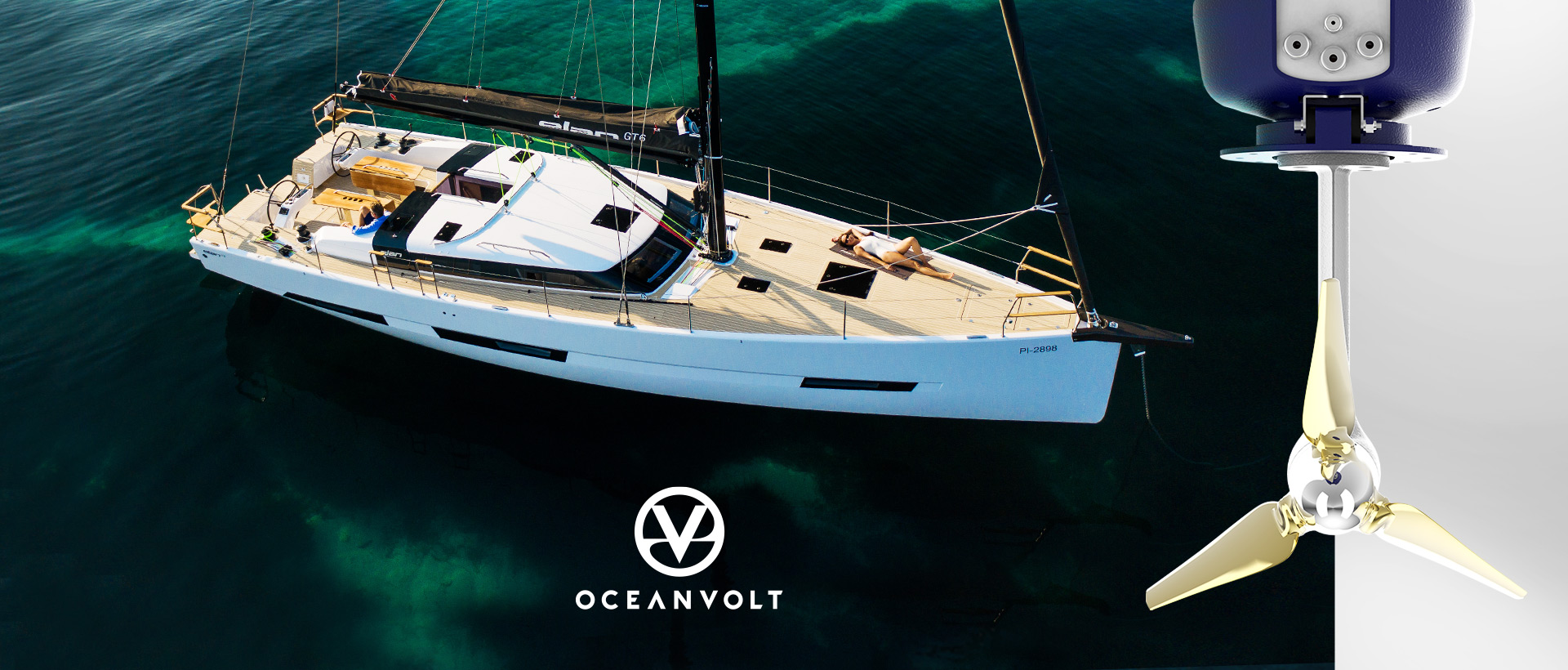
What You Need to Know Before Buying an Electric Sailing Yacht or Sailboat
It’s no secret that we’re approaching, or have maybe even passed the moment in history where most buyers are considering buying an electric vehicle. The awkward early adopter phase is long gone, doubters few and far between, and every car manufacturer has at least some EV options, while others focus exclusively on electric and are experiencing massive growth. Mass adoption is here, the prices are falling, and infrastructure and legislature are hurrying to catch up.
All of this has left many people wondering why not bring sailing boats into the electric world? Sailing was never about motoring, never about engine speed – it is about that connection to nature, the serenity of the sea and the challenge. So why not get rid of the “dirty and loud” diesel engine, and simply exchange it for “clean and quiet” electric propulsion? Motor out of the marina or bay in silence, then use the sun, wind and waves to continue your journey.
Well – it turns out that like all good things in life, it’s not that simple, but it can be completely viable if approached correctly, and Elan and Oceanvolt have partnered-up to offer just that.
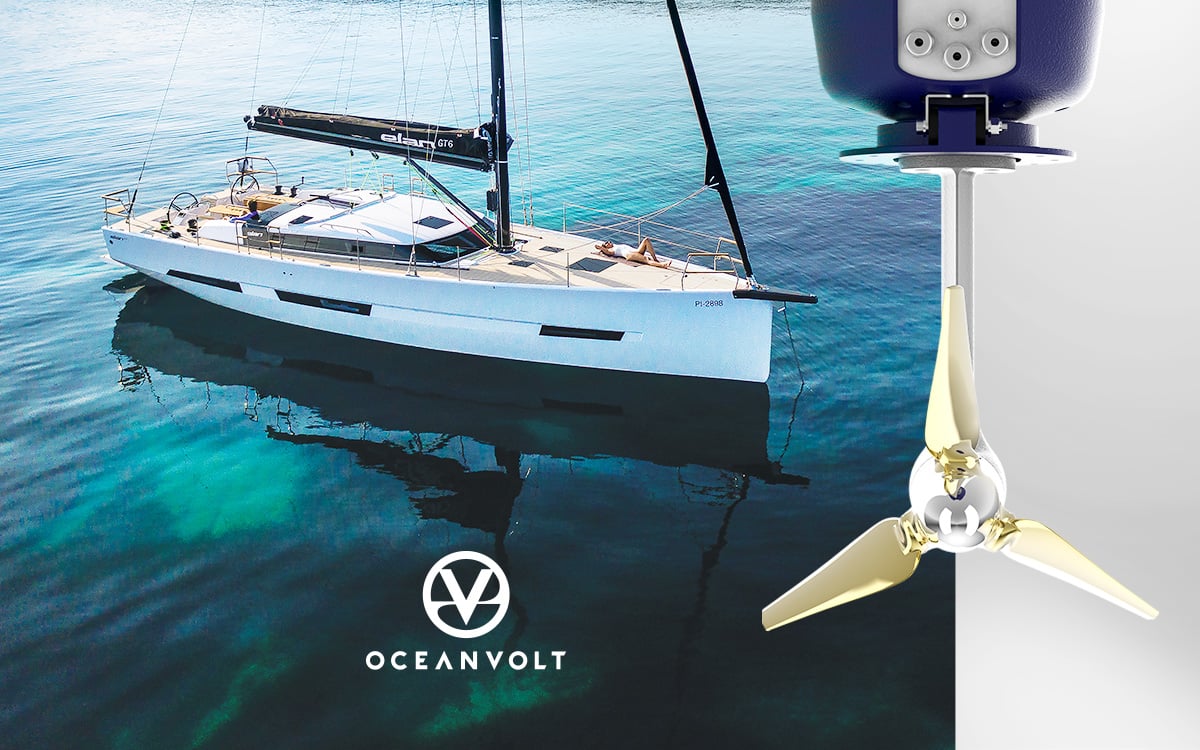
EARLY ADOPTER PHASE
Unlike the automobile industry, electric-powered yachting is still in the early adopter phase. That is why picking experienced manufacturers is crucial. Elan Yachts, for instance, had built various highly successful projects with Oceanvolt in the past and were part of the pioneering few boatbuilders to take on the challenge. The partnership flourished and matured so that Elan is now working exclusively with Oceanvolt and has extended the offer to their whole range of yachts. But what does being an early adopter mean for the buyer? Mostly that the technology is here, but the price is high. For a well-rounded, high-quality and reliable system, you can expect to pay 20-30% more than a comparable diesel-powered sailing yacht. And since a large part of that cost is for the batteries, do not expect that to change very soon as the demand for Lithium-ion batteries is only increasing.
FOR SERIOUS SAILORS
However, let’s assume that the price is not a problem. You want to be among the first few with a zero-emissions yacht – no noise, no exhaust, no smell and no environmental restrictions. You want to sail without the use of fossil fuels. You want the famous instant power output benefits of electricity in emergency situations, no engine rev settling, no pre-start waiting and low maintenance costs. You want to use the wind and the sun to re-charge. All of these are actual benefits of electric yacht propulsion, but what are the downsides? For committed sailors, there are not many. The operating range of high-end electric propulsion systems like the one from Oceanvolt is from 25 to 70 miles at 5 knots (and more, depending on the battery pack options and power generation), which is more than enough to get you in and out of marinas and bays and still have plenty left over to get you out of a bind. The rest, you sail. And if the yacht is fast, the winds are fair and you achieve 5 knots or more, Oceanvolt’s hydrogeneration kicks in and generates power for recharging the battery bank. Hydrogeneration creates drag of only 0.1 knot at a boat speed of 7.0 knots – so it is barely noticeable. If you can go even faster, the power generation increases exponentially (see GRAPH 1).
GRAPH 1: Elan E4 Power generation prediction

(Source: Oceanvolt)
LIVING ABOARD
Buying an electric-powered yacht is still far from an off-the-shelf experience. You need a trusted team of specialists who will guide you through the process and make sure they create a custom solution according to your needs and a good partnership between the shipyard and the electric propulsion provider is crucial. Why is this so different from a car? A yacht is an independent element on the sea and, unlike a car, it will need to provide its owner with much more than just propulsion. It is imperative therefore to consider everything, from the way the yacht is built to the equipment on board. Since you will spend most of your time sailing, you need a yacht that performs well and is easy to sail. A good, reliable sail plan and rig, like the one on Elan yachts, will give you enough options to substitute the practicality of a diesel engine. Elan’s VAIL technology keeps the weight down, its short-handed sailing approach and comfort-centric design will keep you comfortable even when sailing for longer periods, and the high-end electronics are designed to keep consumption low. That is crucial because you will need to bear in mind cooking, refrigeration, water and cabin heating and entertainment, as well as the availability of ports/marinas with good electrical infrastructure. Of course, there are fossil fuel solutions for all these challenges, and Elan’s and Oceanvolt’s partnership offers a hybrid option with a 48V DC generator, which is very practical, if on the pricier side. Purists, however, will want to go full electric. And for them, more renewable power generation options like photovoltaics, a wind generator or a humbler approach to on-board living will be crucial, especially in colder climates. Bear in mind that experienced shipyards like Elan Yachts will be able to provide a complete solution, including solar panel procurement and installation.
POWER OPTIONS
How powerful are electric motors on sailboats? Well, Oceanvolt offers two different propulsion systems. The Finland-based company has developed a 6, 8, 10 and 15kW SD saildrive, as well as a special 10 and 15kW ServoProp with even better hydrogeneration, thanks to its patented and DAME-awarded software-controlled propeller blades, which change pitch to generate as much power as possible. Depending on the yacht, the entry-level SD saildrive enables 5 knots of cruising speed and a top speed of 7 knots on the 30 ft Elan E3. Bear in mind that power consumption and speed is inverse in relation to power generation – as you go faster, you consume exponentially more power (see GRAPH 2) The good part is that the motor and the saildrive weigh only 42.5 kg, which offsets some of the battery weight. In addition, all of the motors are all closed-circuit liquid-cooled, so there is no annoying spluttering.
GRAPH 2 : Elan E3 RANGE PREDICTION
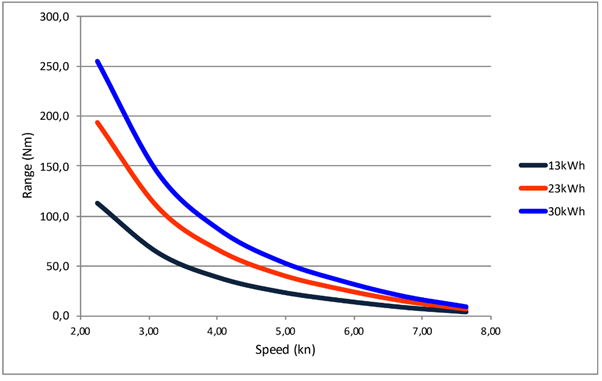
Source: (Oceanvolt)
Want to go electric?
Get in touch with Elan Yachts, and request the configuration of your ideal electric-powered sailboat. Elan is the only yacht manufacturer offering complete electric propulsion solution for the whole range of yachts. Contact our experts, build an energy balance sheet for your needs and your new Elan, taking into account the type of sailing, the environment, living habits and other possible criteria, to create the optimal setup.
E Line Crossover

IMPRESSION Cruising
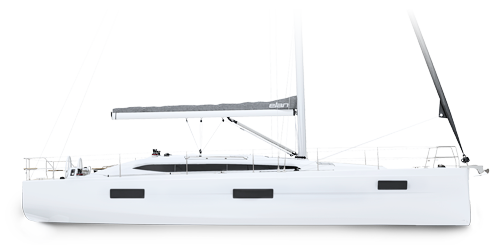
IMPRESSION 43 - 43'8"
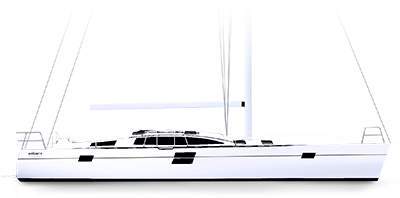
IMPRESSION 50.1 - 48'8"
Gt line luxury performance.
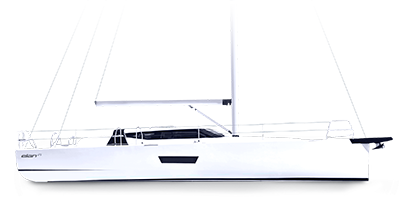
GT5 - 40'9"
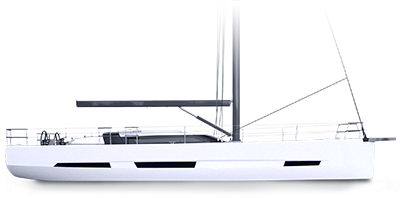
GT6 X - 49'8"
Get in touch.

Electric Motor Calculator Try our NEW Calculator to find the right electric motor for your boat
Quick shopping links.
- Electric Outboard Motors
- Electric Outboard Motor 5 HP
- Electric Outboard Motor 9.9 HP
- Electric Outboard Motor 14 HP
- Electric Outboard Motor 20 HP
- Electric Outboard Motor 30 HP
- Electric Outboard Motor 50 HP
- Electric Inboard Motors
- Electric Inboard Motor 6 HP
- Electric Inboard Motor 12 HP
- Electric Inboard Motor 20 HP
- Electric Inboard Motor 40 HP
- Electric Inboard Motor 70 HP
- Electric Inboard Motor 100 HP
- Electric Inboard Motor 200 HP
Battery Chargers
- NOCO GEN 2 Deep Cycle Battery Charger
- NOCO GEN 3 Deep Cycle Battery Charger
- NOCO GEN 4 Deep Cycle Battery Charger
- NOCO GX2440 Lithium Battery Charger
- NOCO GX4820 Lithium Battery Charger
- EV- AGM / Lithium Battery Charger
- Electric Boat Motor Batteries & Accessories
- Elco Classic Launches
- Elco in the News
- Customer Stories
- Press Releases
- Get Updates
- Benefits of Going Green
- Our Technology
- Frequently Asked Questions
- Honoring Heroes
- Tell us about your boat
- Dealer Application
- Dealer Log-In
- Return Policy
© 2024 Elco Motor Yachts. All Rights Reserved. Sitemap.
- Privacy Overview
- Strictly Necessary Cookies
This website uses cookies so that we can provide you with the best user experience possible. Cookie information is stored in your browser and performs functions such as recognising you when you return to our website and helping our team to understand which sections of the website you find most interesting and useful.
Strictly Necessary Cookie should be enabled at all times so that we can save your preferences for cookie settings.
If you disable this cookie, we will not be able to save your preferences. This means that every time you visit this website you will need to enable or disable cookies again.

Choosing the power needed to motorize my boat
Choosing the power of your electric motor is something important. It must be enough to be able to get out of a bad situation in case of heavy seas or a gust of wind, but not too much as it will determine the size of the battery pack and therefore the final cost.
The power necessary to move a boat at a desired speed or to with headwinds depends on many factors :
- Size and shape of the hull(s) and annexes,
- theoretical calculations can give you an estimate of resistance/speed.
Other factors can significantly influence consumption :
- Propeller efficiency: 50/55% if you have a good propeller
- Mechanical losses (friction): 95% if you have good material
- The efficiency of the motor controller: 90/95% for a synchronous motor with permanent magnet and electronic commutation … Much less with asynchronous or brush-excited motors More information in our article Not all motors are the same Tous les moteurs ne sont pas équivalents ?
In total, less than 50% of the power consumed will be used for propulsion. The loss can be much greater with the wrong choice of propeller, motor or equipment. Savings can sometimes become expensive when you have to increase the size of the battery pack to compensate for low overall efficiency.
Other factors can cause 2 identical boats to have very different performance :
- weight distribution
- the condition of the hull …
So how do you estimate the power required for your boat ?
There are different ways :
- Compare with the power of its existing thermal engine in CV or kW (1 kW = 1.4 CV) but beware that the comparison is limited because the powers are not calculated in the same way. A good basis could be to convert 1 KW to 2 HP concerning power, and therefore maximum speed, and 1 kW for 3 HP concerning torque, which allows the boat to move forward in difficult conditions. We explain why in our article How to compare thermal and electrical power? Comment comparer puissance thermique et puissance électrique ?
- Ask the boat manufacturer or architect for the boat’s resistance curve in water and against the wind . It will allow you to determine the power necessary to get out of a bad situation with the sea and the wind and to estimate the boat’s KW consumption in normal weather. You should leave a margin because the curves are theoretical with a boat that is often lightly loaded whose weight is ideally distributed and with a clean hull and propellers.
- To help you, we have developed a tool based on a theoretical calculation and on the feedback from sea trials. By giving us some information, we can provide you with a theoretical power curve in calm seas and with wind depending on the speed. This would of course be only a theoretical calculation that would take into account efficient inboard engines and these calculations must be interpreted in the light of experience, the state of the sea and the boat. The tool would show you how additional nodes are sometimes very expensive in terms of consumption.
Example of a power calculation
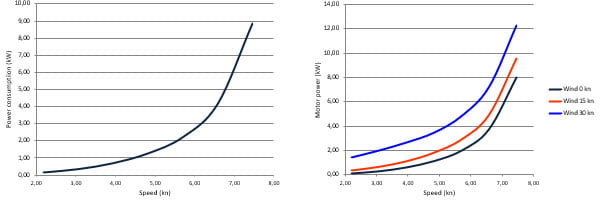
This tool could help you make a decision, but it is in no way a recommendation. Our experience shows that the loaded weight is often underestimated, we recommend you to leave a margin.
@ Send a request to estimate the power needed to motorize your boat
How to assess autonomy ?
A 1 kW motor will consume 1 kWh at full power over a period of 1 hour. We will double or triple the range by reducing the speed very little .
It is good practice to start with a ratio of 1 between kW (engine power) and kWh (battery pack capacity), even if it means leaving room for future expansion. Please note that this rule applies with LIFEPO batteries. Other chemicals require a larger pack. As for AGMs, it will be necessary to foresee that they should not be discharged more than 50%.
It is possible for a small boat to bring a small portable generator of 1 or 2 KW as a precaution. Connected to the charger, it will allow you to return to port at low speed even if the batteries are empty.

Electric Motor
Please note:.
The following information is in regards to our initial set up. It has been almost 5 years since we wrote this. Many upgrades and improvements have been made since then. All can bee seen on our Youtube Channel. Updated wiring diagrams, specs and photos will be coming soon. In the meantime, much of the below information is still accurate and I’m sure you will find it useful. And the answer to our most asked question is YES, we still love our electric motor!
WHY ELECTRIC?

An electric motor . . .
Is not for everyone..
Lets first take a look back in time when “production” boats became popular in the late 60s early 70s, the intent was to make an inexpensive boat the average family could afford and handle with limited sailing experience and knowledge. As a result, one of their requirements was the ability to move the boat in difficult situations. This is where the “auxiliary engine” was coined. But, for many, it has become the primary means of maneuvering their boat. Yes, there are places in the world you can’t sail, like the Panama Canal. But, there are often alternatives where you CAN sail.
“We have yet to use our motor for more than 30 minutes at a time.”
As of today, November 2016, we have sailed over 3000 miles up the east coast of the United States and through the Bahamas to Haiti. We have yet to use our motor for more than 30 minutes at a time. The majority of use comes when we drop the mainsail and back down on our anchor to set it. Most of our sailing has been offshore. But, we have also sailed on the ICW and recently sailed 25 miles up the Cape Fear River to Wilmington, NC. We have sailed under many bridges, some on set schedules, others open on demand. In all cases, we sailed under. We have found that having a solid plan and the patience to wait for the right weather and tide is the key.After all, we own a sailboat. They are inherently slow. We are not in a rush. We love the idea of being self-sufficient. But, for those who sail with schedules, are short on time, lack the patience to sit out a wind hole, feel the need to power their boat to hull speed, enjoy maintaining a diesel engine, or are just set in their ways, then an electric motor probably isn’t the right choice.
Want to learn even MORE…?
Of course we would love for you to stick around and read this page all the way to the bottom, but, we have tucked in many distractions (i.e. links) along the way. Don’t feel bad if you digress, we know you’ll be back. If you want to just jump feet first into all things “electric sailboat” Electric Seas is a good place to start. It’s a great resources community and features several other electric sailboat stories for you to enjoy.

ANOTHER POTENTIALLY GREAT RESOURCES….
“My Electric Boats” by: Charles Mathys.
Although this book is currently on our Amazon wish list, we have not read it yet. But, it is the only one we could find on the subject and, for only $15, it looks promising. If you read it before we do, let us know what you think!

You don’t need a diesel . . .
For ocean passages..
Many people have written in and commented that an electric motor is only good for day sailors who weren’t going very far each day, and that you need a reliable diesel engine for long distance cruising. But we feel like the opposite is true. Since we don’t have a dock to tie up to and charge our batteries each night, we rely on sailing to recharge our system. The longer we sail and the more sun we get, the more power we make. Because we don’t have a 9-5 to return to at the end of a fun weekend out on the boat, we have no schedules requiring that we make it back to the dock on time, no matter what the wind is doing. So, we feel that an electric motor, depending on your sailing style, can be adapted to any boat. But, you have to be willing to work around the one major draw back, range.
“We have no schedules requiring that we make it back to the dock on time.”
Range is the one major downside to an electric motor. But, with a sailboat, and some adequate sailing skills, we have found we really don’t need a motor as much as we originally thought. For those who do have schedules, the possibility of a hybrid system may work well. It encompasses all the benefits of an electric system with the added back up of a diesel or gas genset rated to supply adequate power for extended motoring. Some companies even offer an electric motor, like this one, that can be installed in parallel to an existing diesel motor. So the majority of motoring is done with the traditional diesel, however for short periods of time, like moving around the marina, the electric drive can be used instead. This also incorporates the added benefit of capturing power from the spinning prop while sailing, often referred to as “regeneration” or “regen”.
Our conversion to electric . . .
Started with our motor..
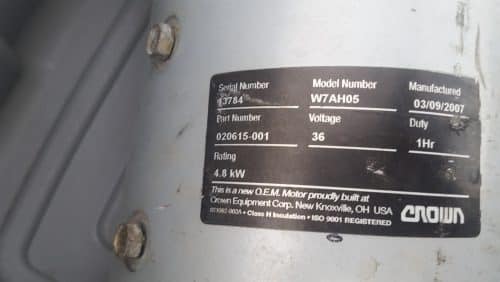
We found the motor on ebay.com, knew it worked and that was about it. We chose this specific motor for three reasons:
- It was rated at 4.8kW at 36v which was adequate for our needs.
- It was overbuilt for an industrial application. This meant it had robust parts and easy to source replacement brushes.
- The motor cost us $125! Since this entire “Electro-Beke” project is just one big experiment, we tried at every corner to keep our expenses minimal.
Our motor weighs 110 pounds, which is quite a bit more than its brushless DC siblings like those used in the existing electric boat market. Although it is probably a little less efficient, its components are much more robust and durable. It is heavy duty, low cost and provides adequate power, with the added bonus of being simple and easy to find parts for. The only parts we will likely ever have to replace are the 8 carbon brushes that transfer electricity to the motor armature (the part that spins on the inside). Depending on use, they can last for many years without wearing out, and for about $80 we can buy a complete replacement set to have onboard. That’s it, virtually maintenance free, with only 1 moving part, the motor itself is relatively simple. On our boat, simplicity is often the defining factor for equipment selection.
This motor happens to be wired with separately excited field and armature (or SEPEX). It just means that we have a lot more control over the motors power output. We can tune it down to have more low end torque, or up to gain high end speed. This will allow us to customize the power output we need for our specific boat. A few other types of motors out there include, Series , and Permanent Magnet that only have one set of coils. Each type has its own benefits and drawbacks. But we won’t get into any of that here. If you would like to know even more about DC motors, click HERE .
we didn’t buy new . . .
Because we received quotes from three different companies:.
- Here’s our quote from OceanVolt for their AX8 motor.
- Here’s our quote from Annapolis Hybrid Marine for a Thoosa 7000HT motor. Read their prediction for power consumption and battery drain.
- Click here to see some data and predictions from Electric Yacht for their Quite Torque 20 motor.
Our entire set up . . .
Cost us just $1,400..
As you can see by the above quotes, The motors and supplementary wiring are all in the $10,000 price range. That doesn’t include a battery bank. Our motor and wiring cost us just under $500. Many of our components were refurbished, used or salvaged from boats being demolished, including some of the wiring. The battery bank and additional tools, like wire crimpers and cutters were another $500. So, for about $1000, we installed our Electro-Beke system. Our charging system ended up costing us only $400 thanks to a few amazing companies who joined our Uma Angels Family and supplied the major components. Find out more about our charging system in the “Charging” section below.
That Breaks down to:
$500 _ for the motor, controller and supplementary wiring. $500 _ for the batteries. $400 _ for the solar charger, panels and bimini modifications.
Power required . . .
To push our boat and yours..
Our motor has an 8hp rating. For those accustomed to gas or diesel engines, this may not seem like much power. But, the rating systems used for gas engines and electric motors are so different that comparing the numbers is almost meaningless. It comes down to the way the two types of motors use their energy and torque curves, which is quite different. According to the research we have done, a 1 hp gas (or diesel) engine can push 500 pounds of displacement to hull speed in calm conditions. Now, the sources disagree a little here, but as a rule of thumb a 1hp electric motor can push about 3 to 3.5 times more displacement than its petrol equivalent. So a 1hp electric motor, drawing 750W, can push about 1500 pounds of displacement.
“Hull speed’ and ‘redundant power’ weren’t something we worried about in our system.”
Our boat displaces 13,500 pounds. so, 13,500 / 1500 = 9hp electric motor., now 1hp (of electric) draws about 750 watts. so, 9hp x 750w = 6.75kw electric motor..
At 48V, our motor should give us 6.3kW, which is slightly less than what we would need to push our boat to hull speed in calm conditions. But that is something we never intend to do. It takes a lot of power to push a displacement boat to hull speed. So the slower you go, the greater your range will be. However, it takes a long time to cover that distance. So, there is a sweet spot right around 4 kts (see graph to the right) where you make good headway, while being conservative with your power consumption. Of course, these are merely suggestions. Real world conditions are rarely perfect and adding 30% redundancy is often recommended by many motor companies.
We only use our motor for close quarter maneuvering where sailing isn’t an option, like a marina, or tight anchorage, so “hull speed” and “redundant power” weren’t something we worried about when designing our system. We often sail on and off the hook and choose places to anchor with few boats around.
Power | Speed | Range
Hover over any point to see exact data. For example, it is estimated that at 2.7 kts our motor will draw 600 watts (blue), giving us a range of 65 nautical miles (grey). This graph is based on a 14kW Lithium battery bank and a high end motor/controller combo.
Here are some great companies . . .
That install, sell, or can help answer your questions..
Thunderstruck-EV and EV-West are staffed by great people who would love to hear from you and help answer any questions you may have. They both offer DIY kits that will suit the needs of any boat. They can also help source adequate battery banks, help with solar and even find local experts to assist with installations as well.
If you’re looking for a more “plug and play” set up, check out the companies below. They represent the best in the industry and will gladly customize a set up for your specific needs and provide a detailed quote.

Elco Motors
elcomotoryachts.com
1 (877) 411-3526
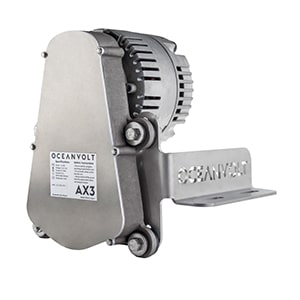
Oceanvolt SEA
oceanvolt.com
+358 10 325 5281
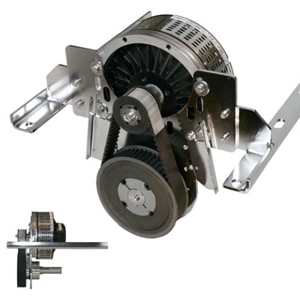
clean-e-marine.com
+1 (410) 353-4348
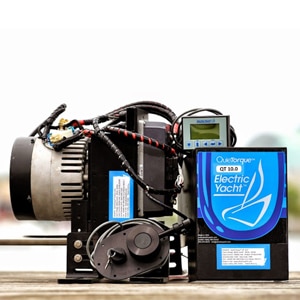
Electric Yacht
electricyachtsocal.com
1 (855) 339-2248
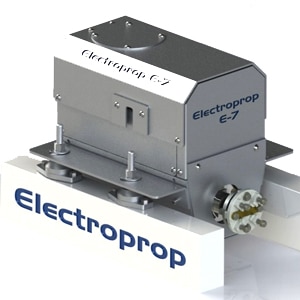
Electroprop
electroprop.com
+1 (805) 455-8444
WANT TO LEARN EVEN MORE…?
Here is another great article about “How much electric power do you really need? !!! !!!
INSTALLATION

Getting down to the Nuts and Bolts
For the complete parts list and wiring diagram, scroll down..
There is a lot to talk about here. Hopefully you can follow along and not fall asleep. Like…I …….am…….right….nowwwww(yawn)www… SLAP !!! Ok! I’m awake. Where was I. Right, wiring.
With no degrees or formal training in electrical engineering (and no, they didn’t teach us this stuff in architecture school), we had a lot of learning to do. Here we were, with a big heavy electric motor we knew nothing about, a boat it could theoretically push and the dream it would all work in the end. Now all we had to do was figure out how to get the motor to spin the prop. Sounded simple enough…right?
“…all we had to do was figure out how to get the motor to spin the prop.”
This step, of course took the longest. Since all our components were used, refurbished or salvaged, we had to test everything. We then started wiring the system in pieces in the salon and testing those. We then modified, adjusted, replaced and fabricated new systems and tested those. In all, it took us 9 months from motor purchase, to moving boat. Granted, not all of that time was devoted to installing the motor. We did have a few other projects on the side.
There are four main sections to our electric motor installation:
- The motor controller
- The batteries
- The wires that connect it all together

The motor we talked about previously. In all honesty, the main concern when sourcing a motor, is that it has enough power (watts) to push your boat to the speed you would like. The second concern is that it will work with the voltage of the components you choose. 12/24/36/48/72/96V are all common. The general rule, is that the higher the voltage, the fewer amps need to be pushed through the system to attain the same wattage. With this in mind, we have found that 72/96V systems tend to be more expensive than similar 48V set ups and, pushing a boat requires much less power that pushing a car. So, we’re not worried about running hundreds of amps through the system. Although rated at 36V, we run our motor at 48V so we can utilize available golf cart components for the rest of our systems, which are also inexpensive and abundantly available. For our boat, we designed the system to handle 150 amps. This would give us a theoretical output of just over 7kW (48V x 150A = 7.2 kW). If you were paying attention earlier, you might notice that our motor is rated for only 4.8kW at 36V. That is a continuous rating however. It can handle more, but cannot sustain it for long periods of time without some external cooling system. But, because there are times when we need all the power we can get, like stopping or backing down on the anchor, we decided to run our system with a higher amperage rating to accommodate that need.
CHECK OUT THESE PHOTOS OF OUR FINAL INSTALLATION.
(As usual, click to enlarge)
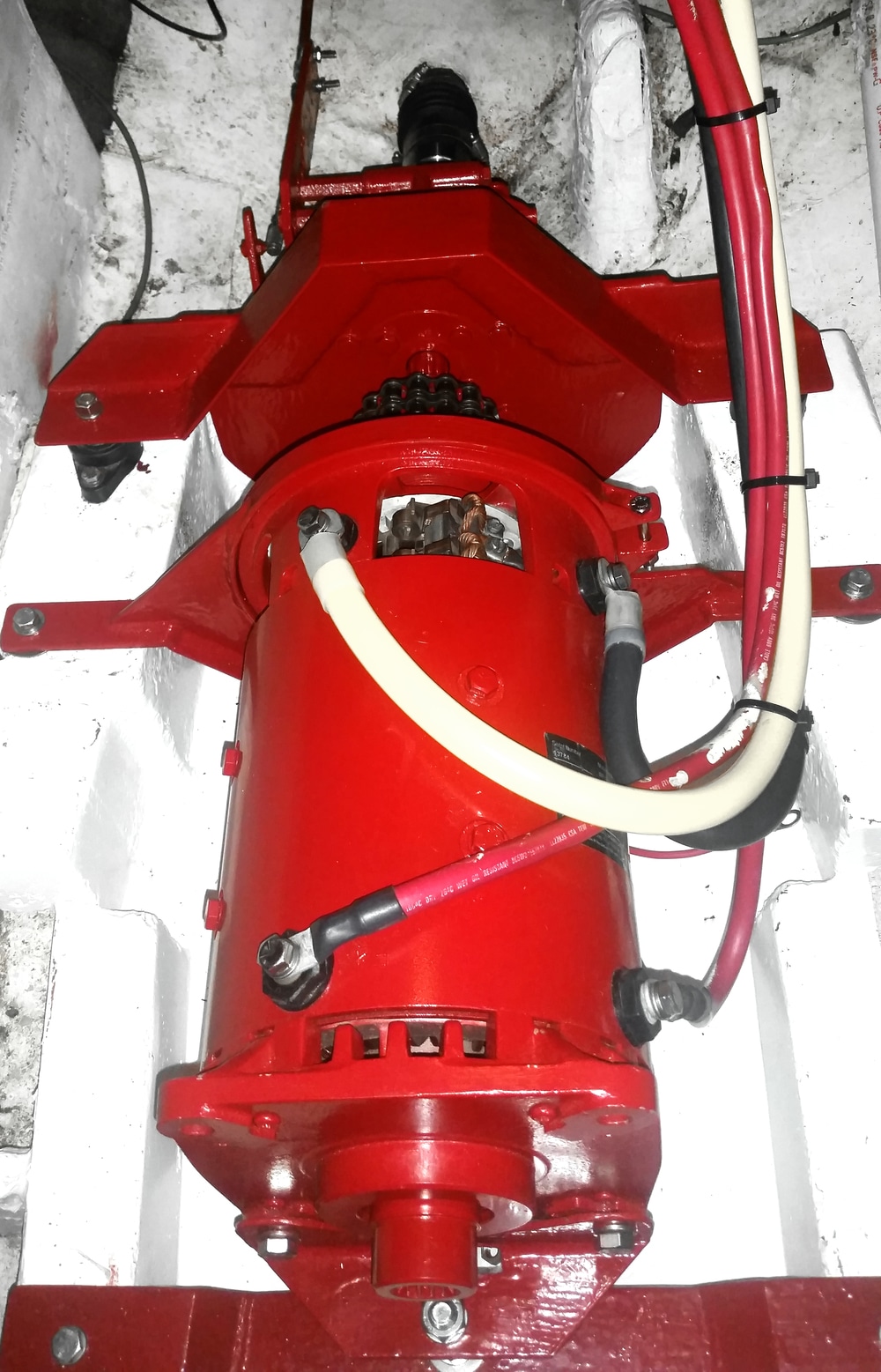
The Motor Controller
This little box is the heart of an electrical conversion. Similar to the head of an ICE (internal combustion engine), it controls the speed at which the electric motor spins. It does this by breaking up the power stream coming in from the batteries into tiny little pulses. This is called Pulse Width Modulation or PWM. There are many different types of controllers out there. In general, if you found a motor with standard voltage range, there is a controller on the market that will work for it. Some are more complex than others. Some offer built in regen capabilities, while other require computer programing and digital displays.
Our controller is a Curtis 1209B. It is designed to run a series motor, but since we got it for such a good deal, we made it work with ours by only using it to power the armature. See the wiring diagram below for more details. This controller is not fancy. It is weather proof, simple and robust. If you haven’t figured it out by now, we love simple and robust.
The Batteries
We will explain more below in the “BATTERIES” section. But for now, as long as you can create a battery bank that can be wired to produce the required voltage for the rest of your system, then you’ll be fine. Also keep in mind how much space and weight the bank will require. Ours fit perfectly where our old fuel tank used to be and helped offset all the weight we lost by removing the tank and the old diesel motor. For typical lead acid banks, at 36V you will need 3 -12v or 6-6V batteries. A 48V bank will require 4 or 8 respectively and so on. Although you can purchase massive deep cycle batteries with equally large aH ratings, we don’t see the value of them since it is very difficult to maneuver them into tight spaces on a boat. Ideally, if you can afford them, a lithium bank would be the best for an electric motor conversion. We’ll talk more about them in the “WHAT”S NEXT” section below.
All our wires our tinned copper or “Marine Grade”, although, we despise that term since it often just means “more expensive.” The majority of which, we scrapped off of boats that were being demolished at the boatyard. What we couldn’t find for free, we purchased from a local discount marine store that sold surplus marine components. This allowed us to spend very little for all the wiring.
For the most part it is all oversized, but when it comes to wire, the bigger the better. There are many useful online calculators that can help give an idea of what size wire will be appropriate for a given application. If your wiring is undersized, the system will lose some efficiency. For the most part this is of no concern. However, in extreme circumstances it will heat the wire to the point of melting things. For example, we undersized the cables connecting the motor controller to the armature, after a 15min full power test at the dock, we melted off the heat shrink tubing on the terminal lugs. It was quickly replaced by something much more beefy and hasn’t been a problem since.
O yeah, One More Thing . . .
The motor mount. .
Oops, almost forgot. Somehow we had to keep the motor inline with the transmission and securely mounted to the boat. We built and re-built 6 different mounting brackets prior to the one we have now. Each being fabricated after hours of sketches and models were developed. We didn’t have to modify the motor any or the transmission itself. However, we did modify the original transmission adapter plate that was used to attach it to the back of our Westerbeke. We then securely attached the transmission to the hull of our boat. This allowed the motor to float in front of it, leaving the transmission to absorb any thrust from the prop.
We fabricated the brackets out of steal since it is easy to work with and weld. Once we settled on a final design, we epoxied and painted the brackets and motor with engine enamel. We’re quite pleased with the final outcome. All the exposed metal is protected from corrosion and it is very securely mounted to the old engine pan.
In tandem to our bracket iterations, were several attempts to connect the motor to the transmission. Our early versions were poorly aligned causing horrible vibrations that in turn produced noise. Noise was something we were trying to avoid by going electric. The final design paired two identical sprockets, connected inline by a #50 double roller chain. This seems to work quite well. It allows for small misalignments and produces the least amount of noise. There are of course many other options out there, and someday we may experiment with them. But, for now, this set up works for us.
Take a look through our Electro-Beke playlist on Youtube for video of the installation process.

WIRING DIAGRAM
Including complete parts list..
Here it is. The schematic you’ve all been requesting. You may notice that it is drawn for a direct drive system, where the motor is used to electronically shift from forward to reverse. We have since installed our motor in front of our old transmission and no longer need the Fwd/Rev circuit. However, since the majority of set ups out there use the motor to achieve Fwd/Rev, we wanted to show our diagram depicting a similar set up. If you end up with a Series or PM motor, you should be able to modify this diagram by excluding the 12V bank to motor connections. However, many of the components, like the contactors, require a 12V supply to operate their solenoids. So you will still need a 12V accessory bank. This is often the house bank of a boat, since many smaller boats run 12V house banks anyway.
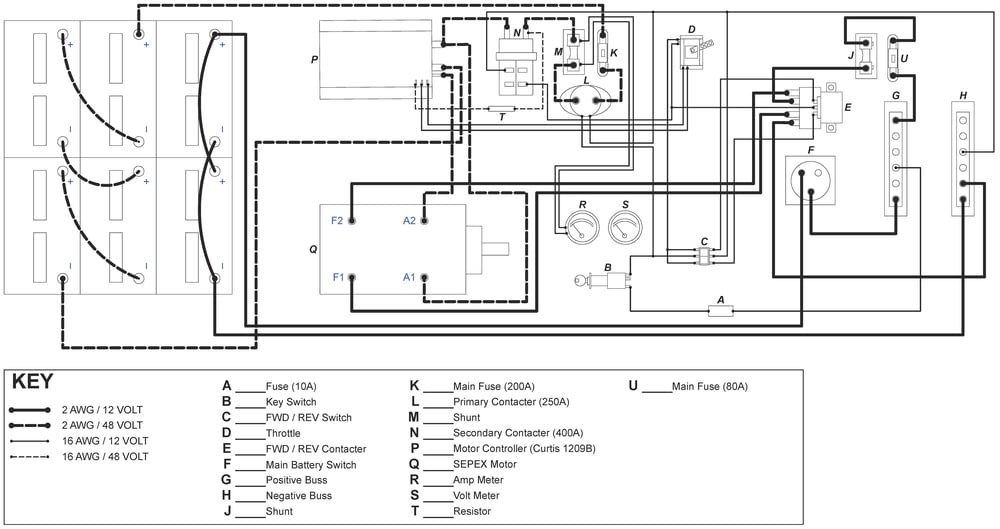
Below are the components we used, why we chose them, where to buy them and pictures of them installed in our boat. If you didn’t figure it out already, their letters correspond to the diagram above.
(A) – 10A FUSE
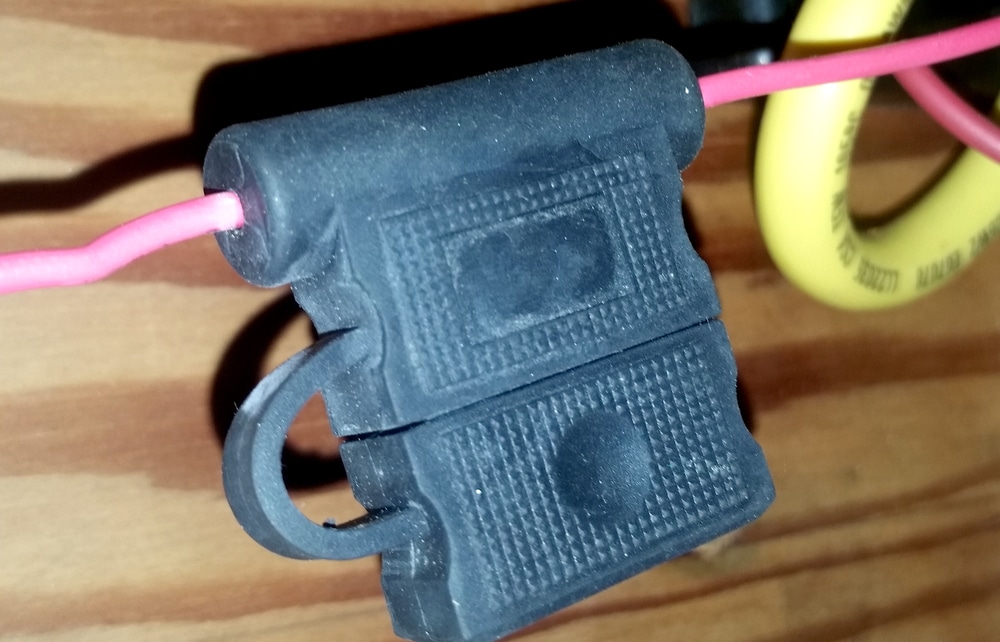
Buy one HERE .
This is a simple automotive fuse held in an inline fuse holder. It protects the ignition circuit wiring from drawing too much amperage in the event of a short.
(B) – Key Switch
Buy one here . .
The key switch is mainly for security. It can be replaced by a simple on/off switch, but taking the key out will slow down someone trying to leave with your boat, without your permission.

(C) – FWD/REV Switch
This switch is only needed if you are planning a direct drive system. We no longer have need for it, but also have yet to rewire our system after we installed the transmission. It is a basic rocker switch with an on/off/on rocker and 6 pins on the back. This allows both positive and negative wires to be switched. We also wired ours so that it will shut off the contactors if switched accidentally while the throttle was engaged. That way it wouldn’t cause any damage to the motor.
(D) – Throttle
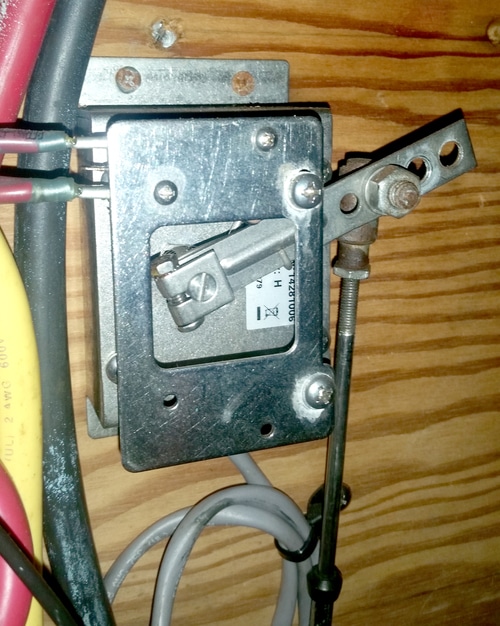
The throttle tells the motor controller how much power to send the motor. We chose this one because it allowed us to keep our existing throttle lever and cable mounted on the steering pedestal. It also has a micro switch that we use to close the secondary contactor (N) on the 48V side and the Fwd/Rev contactor (E) on the 12V side when the throttle is pushed forward. This ensures no voltage is going through the system until the throttle is actually engaged.
(E) – FWD/REV Contactor
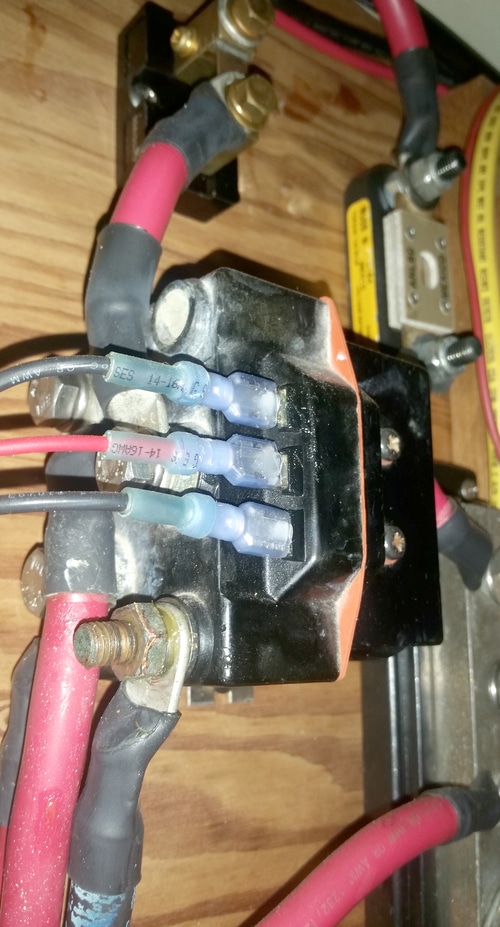
This, again, is not needed if you, like us, install the motor with a transmission that handles Fwd/Rev. However, if you are planning a direct drive set up, and the controller you chose doesn’t have a Fwd/Rev circuit, then this is a necessary evil. The one we used, we scrapped off an dead windlass. It works great for the 12V circuit and are easy to find.
(F) – Main Battery Switch
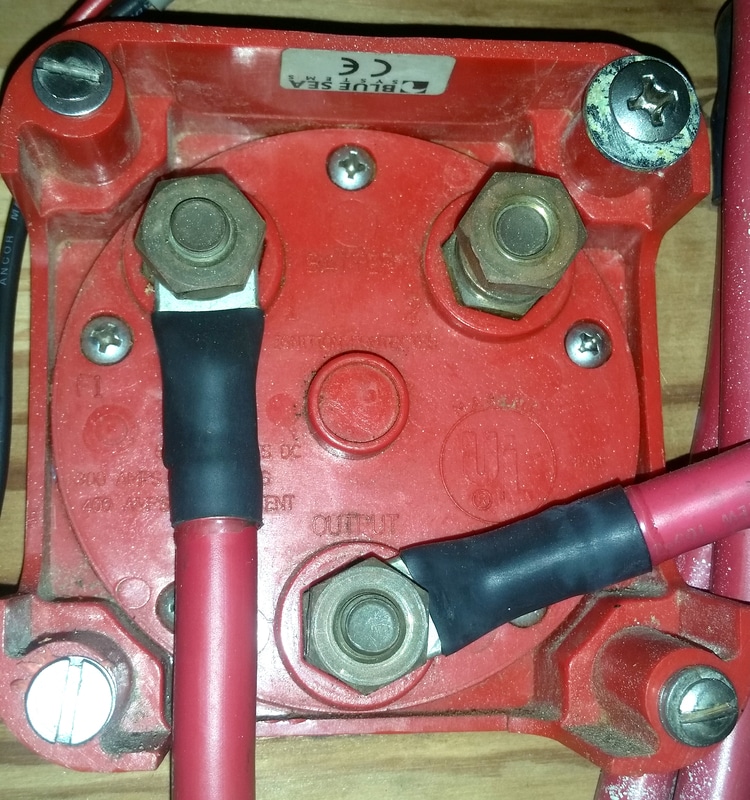
Our boat came with this switch installed already. We simply rewired it slightly to accommodate our systems. For now we only use the “Battery 1” and “off” settings. However, if we eventually install a DC-DC converter to bring our 48V bank down to 12V we could wire it to the “battery 2” position as a back up battery bank.
(G) – Positive Buss Bar
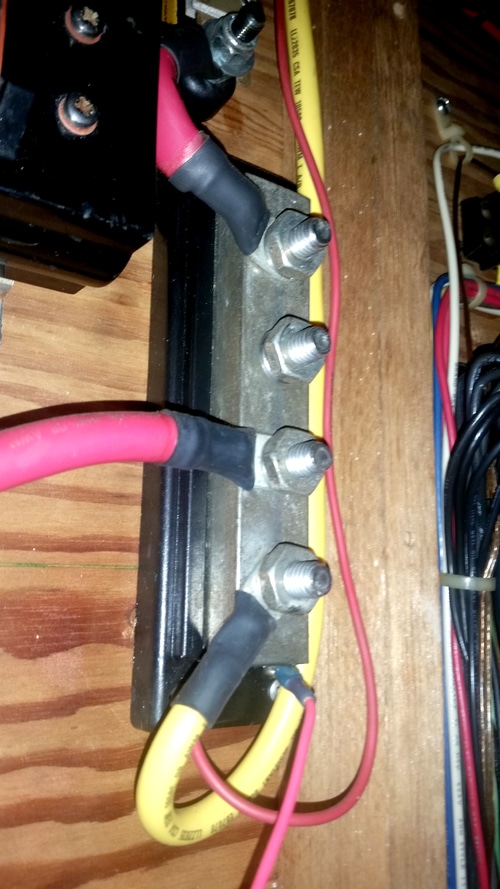
Pretty basic here. A buss bar is used to connect multiple leads to the same source. This one is beefy to handle high amperage on the positive side of the 12V circuit.
(H) – Negative Buss Bar
Same as the Positive buss bar above. However this one is tied into the 48V circuit.
(J & M) – Shunt
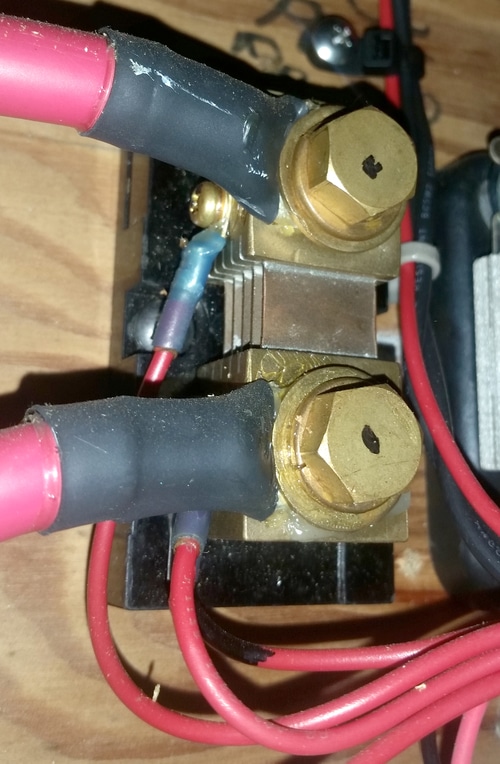
These are pretty standard. They are required to hook up an amp meter and measure how much amperage is running through your system. Often an amp meter will come with its own shunt. They sample the current so that not all 100+ amps are running through a meter. That would be very dangerous. Just make sure the shunt and meter are rated for the same mV, usually 50mV or 100mV.
(K & U) – Main Fuse
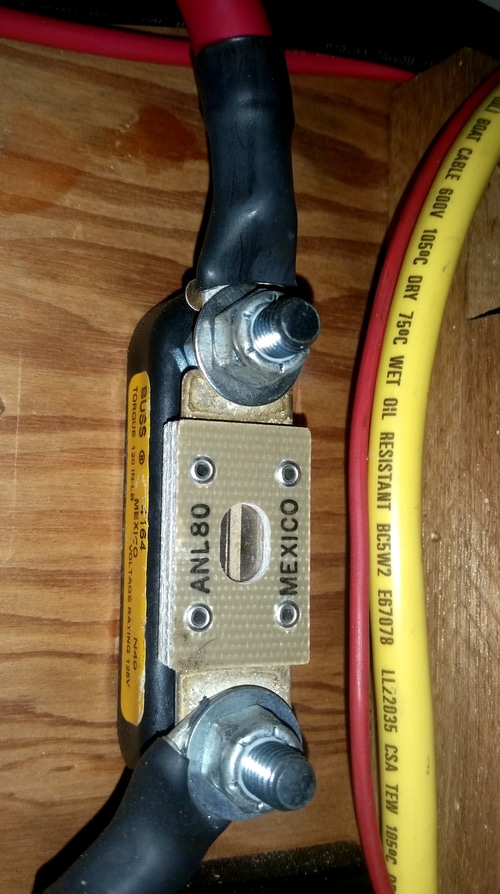
These fuses protect the wiring in the system. The closer to the battery bank the better. The fuse on the 48V side is rated for 200A and the 12V fuse is rated for 80A. These are rated for amperage only and can usually take a variety of voltages. Both fuses and holders are identical. They just have different ratings.
(L) – Primary Contactor
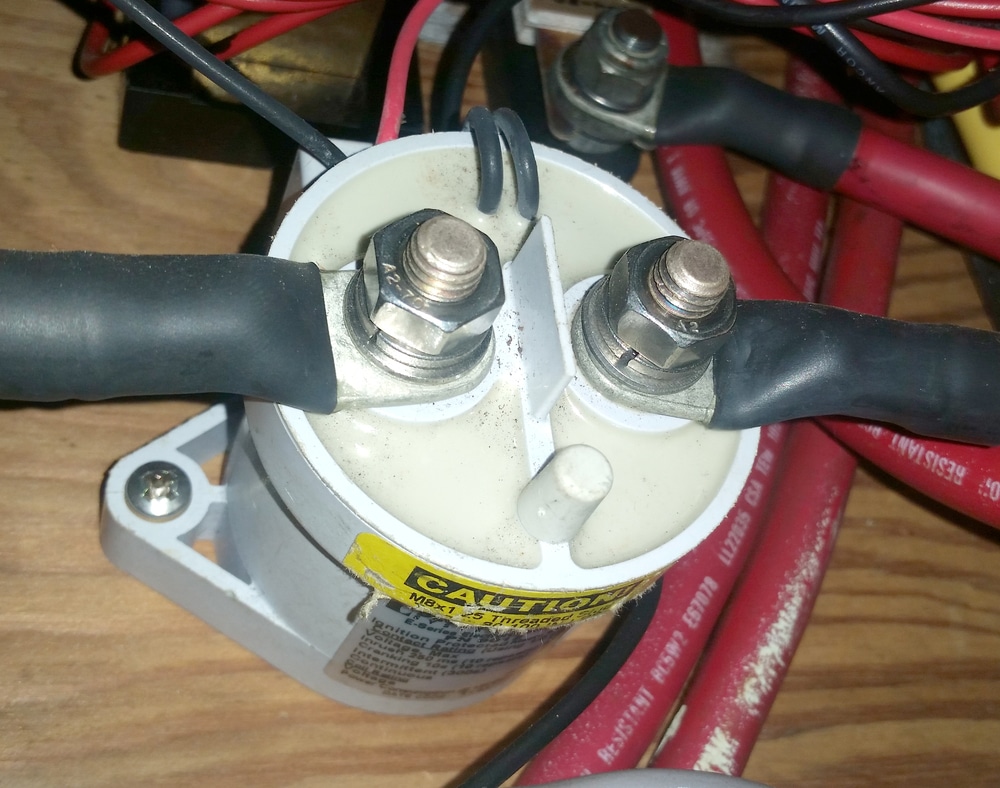
This contactor is wired to the main key switch. It is a bit redundant but shuts off any power from the controller, motor and gauges. It acts more like a battery shut off.
(N) – Secondary Contactor
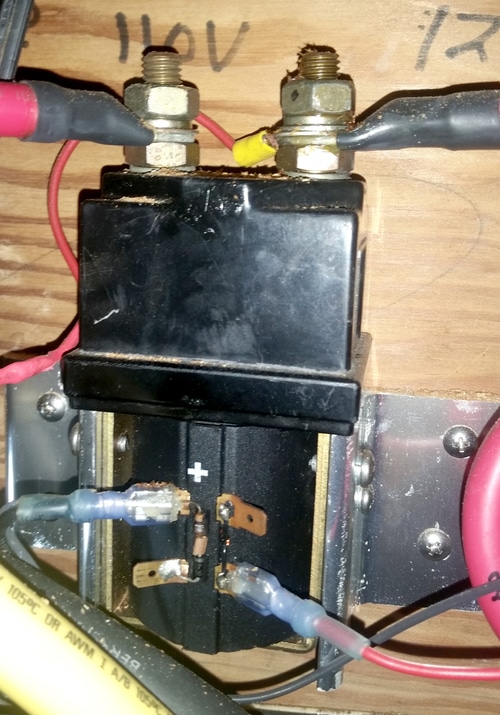
This contactor supplies the motor controller with the power it needs to run the motor. It is also the one that is bypassed by (T) the pre-charge resistor. Contactors are just big remote activated switches. Like breakers, they activate very fast to eliminate high amperage arching.
(P) – Motor Controller
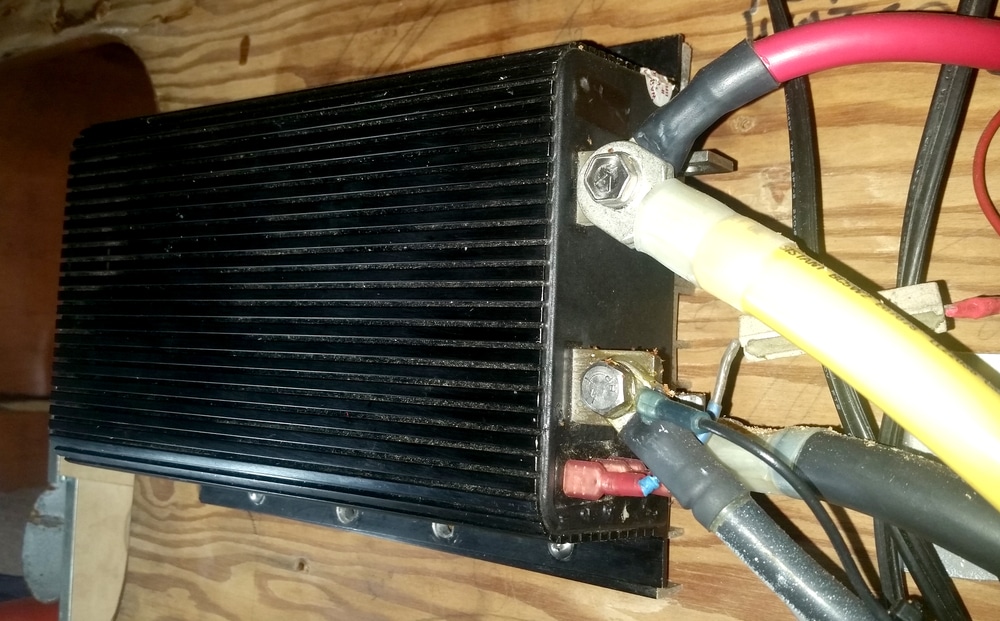
The motor controller we chose works for our application, but there are many out there to choose from. Do your own research here before deciding on what motor you will use. We happened to get a sweet deal on ours so we made it work with our motor. Our system would be less complicated if we used a controller designed for a SEPEX motor. The Curtis 1209B that we have is designed for a Series motor, but we make it work.
(Q) – DC Motor (SEPEX)
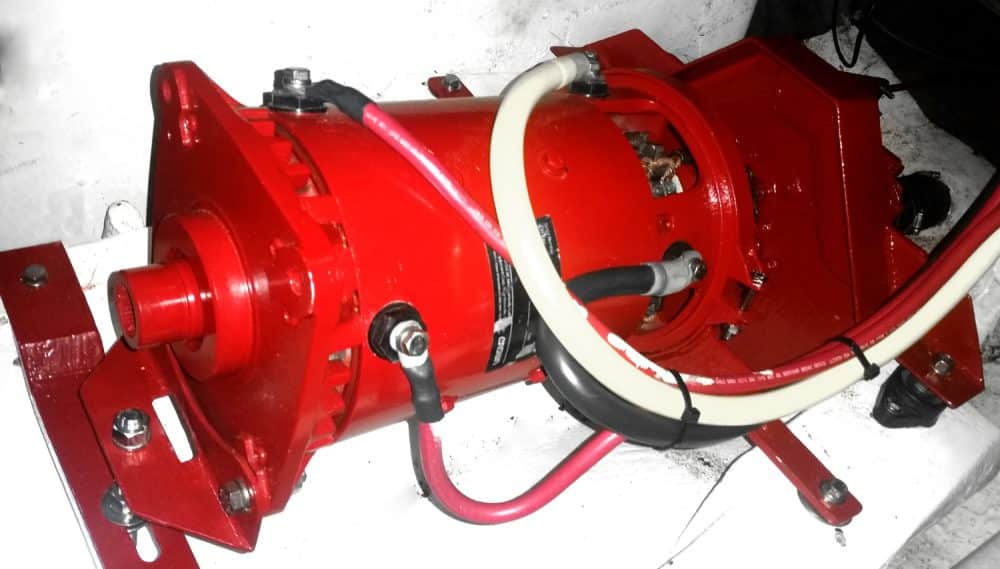
Sorry, you’ll have to find this one on your own.
Since another motor like ours has yet to show up again for sale online, we can’t really recommend the same one. However, the basic idea is finding a motor with the appropriate wattage to push your boat. Refer to our “Power Requirements” section to get an idea of what that might be. Then just make sure it will produce the desired power at a voltage that you would like to work with. We recommend 48V for most applications for reasons described previously.
(R) – Amp Meter
These attach to the shunt (J & M) and show you how many amps are running through the system. Depending on where it is placed it can either read the amps being drawn from the battery bank or the amps going to the motor. We decided to read the amps being drawn from our batteries.
(S) – Volt Meter
This meter does not require a shunt. As long as the negative lead makes its way back to the negative buss bar, the positive lead can be attached at any point along the circuit. We chose again to read the battery bank voltage with ours. However, it can also be place on the motor to read the voltage there instead.
(T) – Pre-charge Resistor
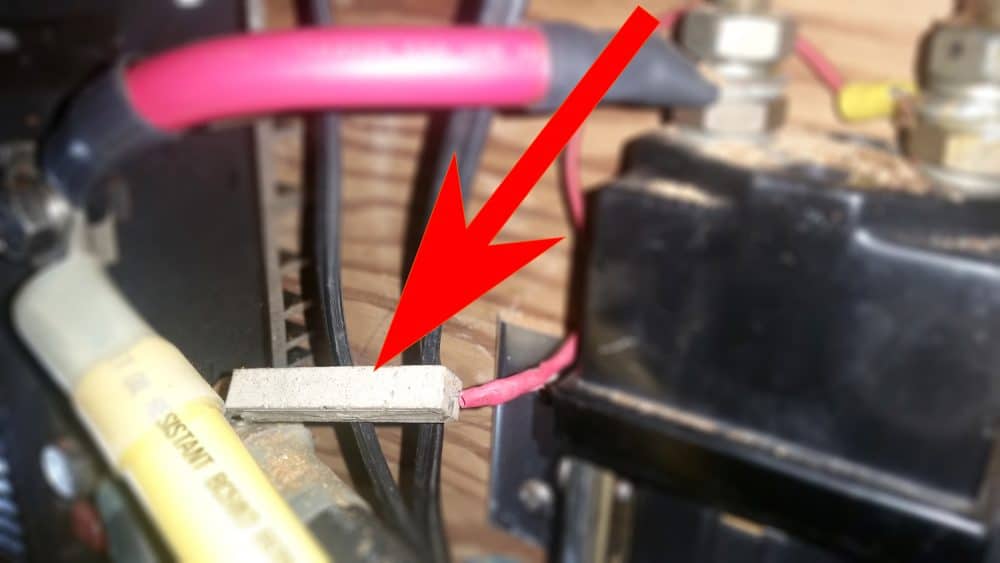
They look like THIS .
There is no specific item to show you here. Each controller and each set up is different. But, I can tell you that the pre-charge resistor is very important. It by-passes the main contactors and supplies the motor controller with the power it needs to pre-charge, so its ready when the main contactor is switched on and all that amperage comes rushing in.
Make sure you check out SV Bianka’s page for another detailed blog about his electric motor installation.For another great article about all the other stuff that goes into a motor installation,
you might want to read “Balance of System” . The article is for an electric motorcycle set up, but the basics are similar enough.

One thing we learned very early on was that . . .
Volts (v) x amps (a) = watts (w) or v x a = w.
At first we thought (please don’t laugh we were total newbies) that if we took 4 – 12V batteries with 125aH, and wired them in series, we would get a 48V bank with 500aH capacity. Obviously we forgot everything we learned in high school algebra. We soon resolved our mistake and learned that this formula is at the heart of everything electrical. As you can see, Watts are the thing you need to pay attention to. Remember high school physics? W=Work. Many appliances in your house, often things that produce heat, are rated in Watts, but marine stuff tends to rate things in Amps. Well, for our sake Watts are king. No matter what boat you have, it requires a certain amount of work (Watts) to push it through the water at any given speed. So, your job is to charge, store and supply to the motor a similar amount of wattage in order for your boat to move. The more watts you can store, the longer you can push your boat.
“The more watts you can store, the longer you can push your boat.”
As mentioned before, our motor is a SEPEX motor. This meant that the field and armature needed 2 separate voltages in order for the motor to spin. The way we solved this problem was with two separate battery banks. The field is powered by the house bank at 12V. This bank consists of two deep cycle batteries wired in parallel giving us about 250Ah at 12V. So far, it has held up great. It powers everything onboard including the inverter and laptops. We use about 30Ah on a slow day at anchor, and around 70Ah when sailing or when we’re both using our laptops all day at anchor. The nice part, is that even on a cloudy day, our 480W solar bank can replenish that before dinnertime. But we’ll talk more about that in the next section, “CHARGING” below.
The motor bank consists of 4 – 12V deep cycle batteries wired in series giving us about 125Ah @ 48V. This may not seem like much, but in the last month of sailing, we have logged over 1000 miles, including sailing 25 miles up the Cape Fear River, and have never depleted the motor bank more than 35%. That works out to drawing only 44Ah used. We’ll talk more about range and testing below in the “TESTING” section.
There are many types of lead acid batteries on the market. Don’t get too invested in brand. Most of the batteries on the market today are made by the same two companies. Trojan seems to be the brand of choice for many. We found batteries for sale locally and for $100 each, including delivery, we couldn’t pass them up. We also knew that the flooded lead acid bank we installed is only temporary. Like we’ve said before, this whole “Electro-Beke” thing is really one big experiment. We have plans to install a LiFePO4 bank soon enough. But we’ll tell you all about that in the “WHAT’S NEXT” section below.
There are many inefficiencies in electrical systems, like heat. However, don’t worry about them too much. If you budget 30% power redundancy into your system, it will more than cover any losses from heat, or mechanical friction and so on.
Check out www.batterystuff.com . They have useful calculators for battery banks and solar, along with great information on different types of batteries and what they are used for.
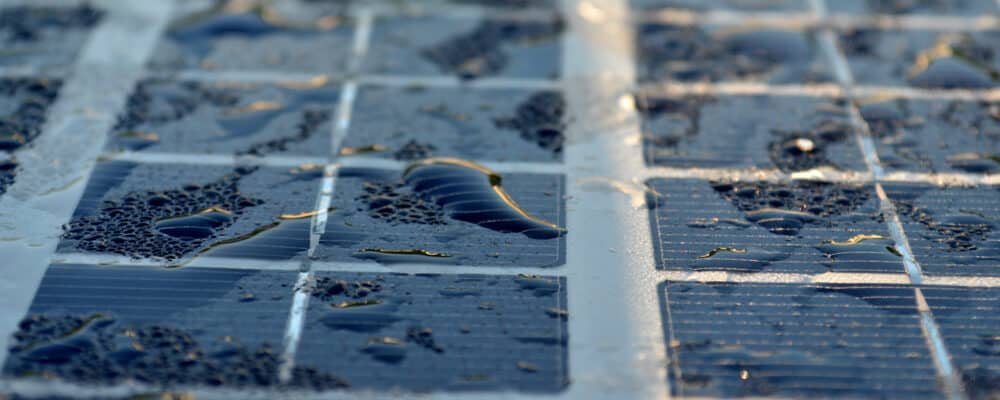
Our Solar System . . .
Also doesn’t include pluto..
We have 480 watts of solar. Broken down into 2 – 240W panels at 24v wired in series to give us a nominal voltage of 48V. Did you get all that? Great! Steven, from Solar EV Systems , gave us a great deal on them, landing him a spot in our Uma Angels Family . There are a several types of solar panels, but as far as we can tell, any modern panel is efficient and well made. None are much more efficient that others, it’s more about the size of your mounting space, and the size of your wallet. The ones we have are made by Trina, They are not expensive, look well made and perform exactly as promised.PV (Photovoltaic, aka solar panel) modules have three different voltage ratings that are handy to understand:
- The nominal voltage of a panel could also be called the “conversational voltage.” When we talk about the voltage of the panels and the other components of the system, we’ll most often use the nominal voltage. Nominal voltage actually refers to the voltage of the battery that the module is best suited to charge; the term is a “leftover” from the days when solar panels were used only to charge batteries. The actual voltage output of the panel changes as lighting and temperature conditions change, so there’s never one specific voltage at which the panel operates. Nominal voltage allows us, at a glance, to make sure the panel is compatible with a given system without having to look at the exact voltage. Our panels have a nominal voltage of 24V. We wired them in series which gives us 48V. It reality, they put out about 75V on a sunny day. But our charge controller allows us to charge a battery bank from 48V all the way down to 12V with the same solar panel set up. We’ll talk more about our charge controller later.
- The second voltage rating is the maximum power voltage (Vmp). This is the highest voltage the panel can produce while connected to a system and operating at peak efficiency. As mentioned above, the max our panels will produce is around 75V, even though we talk about them as a 48V panel system.
- The third voltage is open circuit voltage (Voc). This is the maximum voltage that the panel can produce when not connected to an electrical circuit or system. Voc can be measured with a meter directly contacting the panel’s terminals or the ends of its built-in cables.
Panels also have two different current ratings: current at maximum power (Imp) and short circuit current (Isc), both listed in Amps. The maximum power current is similar to Vmp: it’s the maximum current available when the panel is operating at peak efficiency in a circuit. Ours can produce 35Amps at max efficiency, They consistently produce 30A on a sunny day and we’ve seen as much as 32A. Similar to Voc, the short circuit current is the current measurement your meter would show when in contact with the positive and negative terminals of the panel while not connected to a system or load.All these voltage ratings and current ratings are often found on the back of a panel. Use them to estimate how much power they will be able to produce.
Two rules of thumb:
- 1kW or solar will produce 4kWh/day
- Rated Watts / 3 will get you approximate Ah/d @ 12V.
So, according to this, our 480W panels should give us 160aH on an average day, which we’ve found to be quit accurate. Although, we’ve only ever needed more that 100Ah of charge on one occasion. So usually, our batteries are charged back up before lunch, and we spend the rest of the day on “float” charge.
Types of Panels
Monocrystalline.
These are single silicon cells grown into larger crystals, then cross-section cut into small wafers to form individual cells that are later joined together to form a solar panel. This cell type has high conversion efficiency which means it takes up less space on deck. These cells are generally not shadow protected and are often more expensive per watt.
Multicrystalline (Polycrystalline)
These cells are also single silicon cells constructed by utilizing multiple amounts of smaller crystals to form a cell. This cell type has very high conversion efficiency but is also not shadow protected. Although, you should really be installing any panel so it doesn’t get blocked by shadows throughout the day. It will drastically increase the output if you install them in a proper location.
Amorphous silicon
These are the most inexpensive to manufacture. They are produced by depositing an active silicon material on various substrates like stainless steel sheet. The conversion efficiency is not as good as the single crystal type, but Uni-Solar panels are this type of panel and are shadow protected. Shadow protected means that a panel continues to charge when part of the cells are in a shadow, like a stay, which is a great advantage on a sailboat.
Our Charge Controller . . .
Is at the heart of it all..
The next, and possibly most important component in our charging circuit, is our Midnite Solar KID charge controller. This thing is amazing. Midnite also joined our Uma Angels Family when we asked them to send us a controller and they agreed. We spent a lot of time researching solar charge controllers and learning all about PWM vs MPPT. Bottom line is, if you can afford it, get the MPPT controller. We chose the Kid because it’s just the most efficient at collecting power from your panels. It is also easy to program and understand. We currently run it at 12V and just rewire our motor bank to 12V when we need to charge it. However, we will soon be adding a smaller, simple 12V charger to the “load” circuit of the Kid. This will allow the Kid to be permanently charging the 48V house bank. But, when it is full, switch over to the “load” circuit and charge our house bank through the smaller controller. It may all sound too complicated now, but once it’s installed and working, we’ll be sure to share everything with you in more detail.
“We have never gone 24hrs without fully charged batteries.”
On a boat, where space is at a premium, you need all the efficiency you can get. Right now, I’m sitting on the boat, it is overcast and raining outside, it’s noon and we’re getting around 100W of power in from our panels (about 8-9A @ 12V). Our house bank will be charged back up by dinnertime, same as the last few days, and we haven’t seen the sun all week. When it is sunny, our house bank is usually charged back up before we wake up in the morning. No we don’t wake up THAT early, usually around 10am, but seriously, if it’s sunny in the morning, we put 30+aH into our batteries before 10am. The charge controller runs silently, however it makes a tiny click when it switches from “resting” to “BulkMPPT”. Since on a boat, we’re attuned to every tiny sound, we usually here it click on and off a few times before the sun even rises. Mind you, it’s only putting in 0.5aH then, but still, the sun isn’t even over the horizon yet and we’re already charging our batteries.
Check out “Step 26” when we install our solar panels and charge controller.
The rule of thumb we used when designing our system is that 1 – 100W panel can charge a single deep cycle battery from 50% discharged in a single sunny day. So we have 6 batteries, so ideally we would have 600W of solar. Now, that just wasn’t practical for us, so we settled for 480W and it keeps up just fine. However, if we discharged our motor and house bank down 80% we would need about two sunny days to get them both topped back up fully. Or, about 4 rainy days. For us, this isn’t an issue since we typically use the motor for very short periods of time right before anchoring or when setting off for a multi day passage. So, by the time we need them again, their both fully charged and ready to go. If not, we’ll just hang out and drink a beer. So far it’s never been an issue or even come close to it. We have never gone 24hrs without fully charged batteries.
Many have suggested we have a small generator on board as a back up, just incase there is no sun for many days and our batteries are dead. So far, we have gone a full week without sun and our solar has kept up just fine. Although, we may design a system with the ability to be hooked up to a genset for extending motoring, like say the Panama Canal, so that if we ever needed to, we could just set a generator on deck for a few days and then get rid of it as soon as we’re done. But, for now the whole point was to get away from petrol dependance.
So far, solar is our only means of power production. We do have plans to get working regeneration from the prop while sailing. The possibility is definitely there, and we have tested for voltage while sailing. But as of today, we haven’t hooked up a charge controller to it. Mainly because we just don’t need it…yet. Our power requirements are so minimal and we use the motor so little, that we haven’t bothered to hook it up yet. But, it is on our short to-do list. So stay tuned for future updates.
HERE is a link to a great forum talking about solar systems, battery banks and how to balance them.

How far can you motor?
Maybe the most asked question we receive..
It’s a valid question for sure, and one that many have asked us. But, we have yet to find out. We are still early on in our testing phase of the experiment. We’ve used the motor many times but rarely for more than 10-15 min and never more than 30. It is also hard to find “ideal conditions” to test in. There either isn’t enough space, time or light. Or the tide and wind aren’t in our favor. Sounds like excuses we know, but it’s the truth.
“We are in no hurry to go anywhere, ever.”
From what we have done, we can tell you this. Our max speed has been right at 4kts. but it was against a slight current, maybe 1kt max. So, that would mean our theoretical top speed is closer to 5kts.
Here again, we haven’t actually found out. Mostly because without a tow boat right beside us, it would be dangerous to run out of power in the middle of a channel or bay where there are “calm conditions”. But, we’ve motored for 2 nautical miles at 3kts (with a 1kt tide in our favor) and it drained our batteries down to 70%. So, that would mean that in “ideal conditions” we could motor at 2kts for 6 nautical miles. Doesn’t sound like much, we know. But, with a favorable tide and even a slight favorable wind, we can extend that tremendously. We also wait for the wind and tide to be favorable and then just sail to where ever we need to go.
With limited area to mount solar panels and without a genset, we knew if we used more power that we could generate, we would always have dead batteries. So, from the beginning, we focused more on how much power we could consistently generate, and base our system off of that. To us, the meant using less, not necessarily making more. Our solar has kept up great so far, but our power needs have also been minimal. We have autopilot and a chart plotter that are always on when sailing. We also use our laptops constantly and run a small inverter for tools and small cooking appliances like blenders. We have all LED lights too. We don’t have a refrigerator yet or windlass. But they are on the short list. We also have yet to capture any power from the prop while sailing. So there is still room to capture more power if we need it.
As we continue to sail further and upgrade and modify our system, we will also continue to update you on how it all works here. So keep a look out for updates on our Facebook page and in future videos.
WHAT’S NEXT

We may have a spinning Motor . . .
But the fun has just begun..
Well, our motor works. It pushes our boat reliably. The Electro-Beke experiment is a success, at least in our eyes. Now the real fun begins. We’ve proven to ourselves that we can sail further that we thought and use the motor less than we originally planned. So, what’s next?
“We have a few more project on the list of upgrades and modifications.”
We have a few more projects on the list of upgrades and modifications. The first thing on the list is to rewire our system and remove the redundant components left over from the direct drive phase. After that, installing some better gauges and monitoring systems would be really nice. There is a “fuel gauge ” we would like to install for the motor bank and house bank. It is simple and relatively smart. It will give us an accurate state of charge in a quick glance.
Next on the list will be installing a charge controller or developing a similar system to allow us to capture power from the spinning prop while under sail. Technically our motor is capable of it, and early tests have augmented this theory. We are currently working with a few companies to figure out what the best system will be.
We also need to install a larger heat sink for our motor controller. The one that came with it is designed for air movement across its fins and is therefore undersized for our needs. However, we may be upgrading to a true SEPEX motor controller before long, so it will handle regeneration and would require a different heat sink anyway.
The big ticket item on the list is to install a large LiFePO4 battery bank. We have our eyes out for a salvaged Nissan Leaf or Chevy Volt that still has its battery bank intact. We’ve seen them for sale before and would love to get our hands on one. LiFePO4s are much more stable than other types of Lithium Ion batteries. But, we’ll talk about that if and when we actually get our hands on some.

The Best Outboard Motor for a Sailboat

Last Updated by
Daniel Wade
June 15, 2022
The technology of sailing has remained mostly unchanged for centuries. Since learning to harness the power of wind, sailors have been transiting the world’s oceans, expanding trade routes and exploring new cultures. Although nothing more than a renewable natural resource and a single sail is needed to move a sailboat along the water, there are times when it’s important (and in our modern age, convenient) to leverage off a motor to get you where you need to go.
Like any unique piece of equipment in the world of sailing, outboard motors come in a variety of sizes with features and options to fit any owner’s needs. But of course, one size doesn’t fit all. Every boat is different – even those that come off the production line at the same time – and every owner is looking for something specific when it comes to their sailboat. From the purpose of owning the boat (blue water sailing vs. racing) to the location and impact on maintenance (cold weather vs. tropical weather), an outboard motor is just one of the many elements that will define a sailboat’s function and performance.
Whether you’re a new owner, or a veteran sailor, it’s important to know the basic components of any outboard motor . You should also have an idea of what you want your outboard motor to do for your size and model sailboat.
Table of contents
Outboard Motor Size
A larger boat doesn’t necessarily mean a larger motor. Although there are different ratings for different classes of boats, a small power plant can be more effective than a larger one. Conversely, an outboard motor can easily overpower a small boat and create unsafe conditions at high speeds. Guidelines and requirements differ between motorboats and sailboats. And while there is some overlap, these considerations apply directly to sailboats.
Engine power has to do with how much water a boat displaces. For sailboats, smaller is better. If you’re a bit of a math geek, the exact formula is 4 horsepower for every 2200lb of weight. Coupled with a propeller size, which can be determined using a propeller calculator , you’ll get a rough estimate to use as a guideline to start shopping. This is a good first step, since size is essentially a fixed variable. Though it’s worth noting for those who are buying a sailboat directly from the manufacturer, that actual weight will increase after delivery – once all other rigging and outfitting has been completed.
Physical size of your outboard motor is an important consideration and is directly related to the design of your sailboat. An outboard motor is made up of three parts from top to bottom:
- The Powerhead – Houses the engine. The bulbous part of the motor.
- The Midsection – Houses the exhaust system. Varies in length and design.
- The Lower Unit – Propellers attach to the gearbox. Submerged when operational.
Shaft length is an important design element and should be considered when purchasing a motor. A shaft that is too short will obviously prevent the propeller from being submerged in water, while a shaft that is too long will extend the propellers too far. Not only will it decrease the efficiency of your engine, it will create unnecessary drag. Know your transom length when looking at different models.
When an outboard motor is not being used, it should be stowed in its upright position. Some of the larger motors have an automated switch that will raise it out of the water, but some must be secured manually. Make sure everyone who sails with you is capable of lifting and securing the motor out of the water in case of an emergency.
Outboard Motor Power
Any kind of motor installed on a sailboat (inboard or outboard) should be viewed as a tool to help with maneuvering. Although there are some very skilled sailors out there who can sail into their slip without the aid of a motor, many harbors have restrictions that either don’t allow for the use of full sails, or there simply isn’t enough room to maneuver. A motor with both forward and reverse gears helps tremendously with docking.
While there is no exact correlation between boat length and total weight, the following is a rough guideline:
- 1-4 HP for boats up to 20’ (approximately 1000-2000lbs)
- 4-18 HP for boats between 20-30’ (approximately 2,000-10,000lbs)
- 18-34 HP for boats between 30-40’ (10,000lbs or more)
There are some things to consider when deciding how much horsepower you need or want. Location and the type of conditions you expect you’ll be sailing in is one of the biggest factors. Heavy seas and high winds typically associated with open ocean sailing will put more strain on your engine, and in some cases overpower it, whereas an engine that is heavier than needed will add unnecessary weight when racing. If you plan on motoring for long distances, consider purchasing an engine that will stand up to a lot of use.
Less HP is required for:
- Boat Design – Single hull boats made out of fiberglass require less power.
- 2-Stroke Engines – This is due to an overall lighter weight engine and higher torque.
- Diesel Engines – Diesel delivers more torque because the rate of compression is greater.
- Bigger Propellers – More surface area means more water displacement.
- Location – Motoring on lakes and rivers requires less power than open ocean.
- Distance – A smaller engine is suitable for shorter distances.
More HP is required for:
- Boat Design – Catamarans and heavier boats (regardless of size) require more power.
- 4-Stroke Engine – Engine weight and an extra step of compression yields less power.
- Gas Engines – The rate of compression for gas engines is much lower than diesel.
- Smaller Propeller – A smaller propeller displaces less water.
- Location – Open ocean, with tides and currents, will strain a smaller engine.
- Distance – Cover more distance when wind conditions are poor requires a larger engine.
Outboard Motor Cost
There is no way to quantify how much you will pay for any given motor. But there are several costs associated with owning an outboard motor that are definitely worth considering when making your purchase.
Certainly, a lager, more-powerful engine is going to be costlier than a smaller engine with lower horsepower. But as mentioned earlier, size is not necessarily a guarantee of performance and efficiency. At the same time, there’s only so much you can get out of an engine before you exceed its capability. Larger engines tend to help with resale value should you choose to sell your boat at some point, but a boat outfitted with right motor to begin with will always perform better than a motor that’s large just for the sake of it.
Factor in maintenance costs and fuel when looking at models. You want to run your engine at around 90% of its max RPMs to balance proper fuel usage and with wear and tear. Making a few calls to marine mechanics to inquire about an engine you’re interested in will give you a lot of information a sales person won’t be able to give you. The good news about outboard motors is that most of them are portable, which means you won’t have the added cost of either paying a mechanic to come to you, or having to get your boat to the yard, which usually requires help from a very good friend willing to spend all day driving and sailing back and forth.
Owning a boat requires constant care and maintenance, so a little knowledge goes a long way. While an outboard motor is not required for sailing, it’s a convenient addition that can greatly increase your enjoyment out on the water. Being patient and spending time researching engines will not only help you make the correct purchase but will help you take advantage of a great deal when it presents itself. Whether you sail the Caribbean, or race off the coast of California in a catamaran, there is an outboard motor that’s just right for you.
Related Articles
I've personally had thousands of questions about sailing and sailboats over the years. As I learn and experience sailing, and the community, I share the answers that work and make sense to me, here on Life of Sailing.
by this author
Sailboat Upgrades
Most Recent

What Does "Sailing By The Lee" Mean?
October 3, 2023

The Best Sailing Schools And Programs: Reviews & Ratings
September 26, 2023
Important Legal Info
Lifeofsailing.com is a participant in the Amazon Services LLC Associates Program, an affiliate advertising program designed to provide a means for sites to earn advertising fees by advertising and linking to Amazon. This site also participates in other affiliate programs and is compensated for referring traffic and business to these companies.
Similar Posts

How To Choose The Right Sailing Instructor
August 16, 2023

Cost To Sail Around The World
May 16, 2023

Small Sailboat Sizes: A Complete Guide
October 30, 2022
Popular Posts

Best Liveaboard Catamaran Sailboats
December 28, 2023

Can a Novice Sail Around the World?
Elizabeth O'Malley

4 Best Electric Outboard Motors

How Long Did It Take The Vikings To Sail To England?

10 Best Sailboat Brands (And Why)
December 20, 2023

7 Best Places To Liveaboard A Sailboat
Get the best sailing content.
Top Rated Posts
Lifeofsailing.com is a participant in the Amazon Services LLC Associates Program, an affiliate advertising program designed to provide a means for sites to earn advertising fees by advertising and linking to Amazon. This site also participates in other affiliate programs and is compensated for referring traffic and business to these companies. (866) 342-SAIL
© 2024 Life of Sailing Email: [email protected] Address: 11816 Inwood Rd #3024 Dallas, TX 75244 Disclaimer Privacy Policy
- 2024 BOAT BUYERS GUIDE
- Email Newsletters
- Boat of the Year
- 2024 Freshwater Boat and Gear Buyers Guide
- 2024 Boat Buyers Guide
- 2024 Water Sports Boat Buyers Guide
- 2023 Pontoon Boat Buyers Guide
- Cruising Boats
- Pontoon Boats
- Fishing Boats
- Personal Watercraft
- Water Sports
- Boat Walkthroughs
- What To Look For
- Best Marine Electronics & Technology
- Watersports Favorites Spring 2022
- Boating Lab
- Boating Safety

Things to Consider When Repowering With Electric Motors
- By Capt. Vincent Daniello
- August 7, 2023
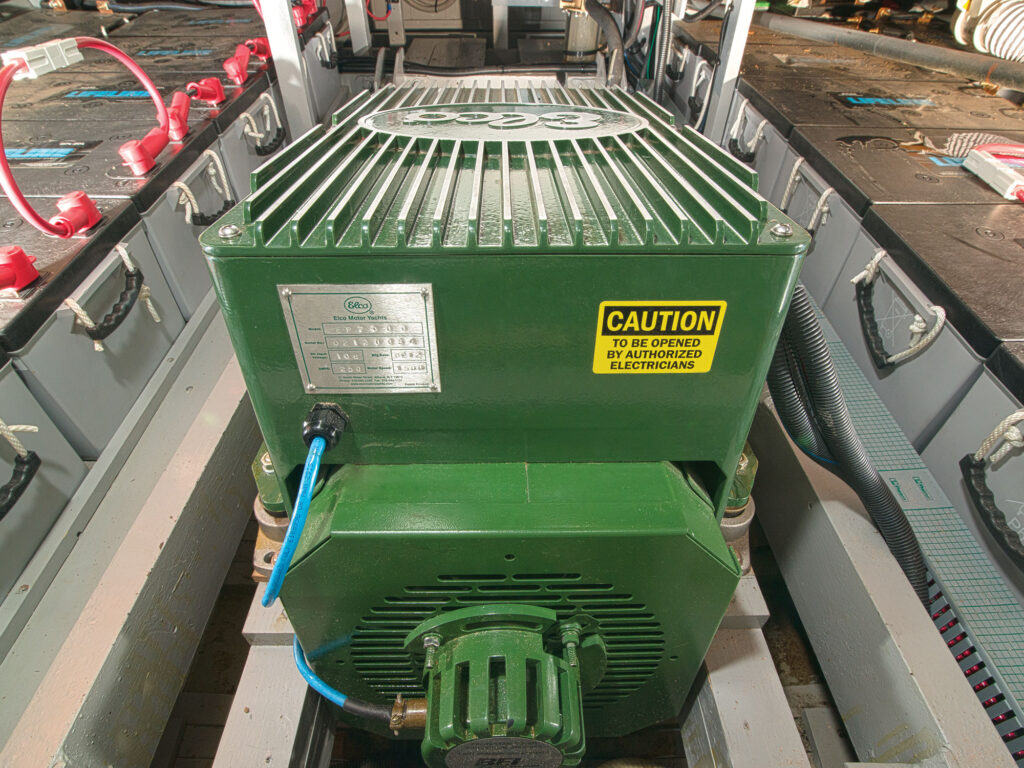
Much reporting focuses on reasons why one might choose electric marine power. The issues of range, speed, noise levels, winterizing and ethanol challenges, lake restrictions, environmental concerns and more all must be resolved on an individual basis. Little gets said about how a boater choosing to repower with electric actually gets that accomplished. Is it DIY? And if not, how does it get done?
Are you considering repowering with electric? Here’s a look at what it takes to cut the fuel line and plug in.
How Fast, How Far and How Long?
Electric propulsion can provide speed, range and runtime, but not all at once. An electric boat, motor and battery combination might top 25 mph for an hour. The same boat can also travel more than 50 miles at 6 mph, or longer still at slower speed. That makes the first step in going electric determining how far, in miles, you want to go fast, and how long, in hours, you need to go slow. Then match a motor and batteries to suit.
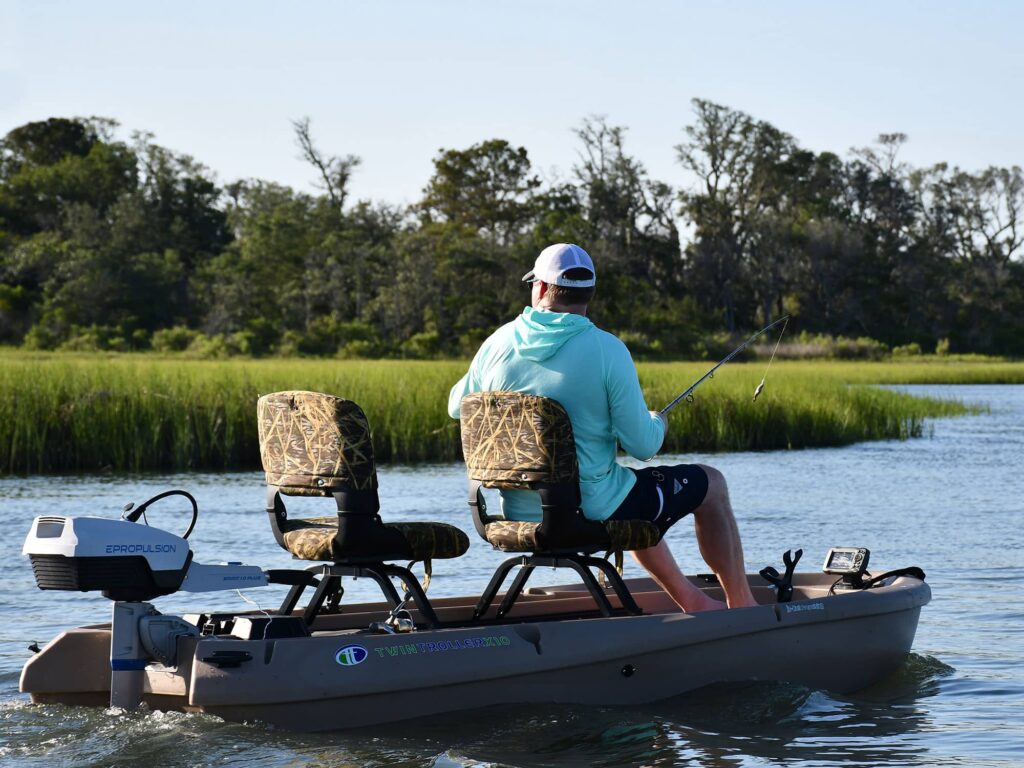
Portable Propulsion (DIY)
For small boats pushed to modest speeds, small, light options from ePropulsion , Torqeedo and Elco —equivalent to 3 hp gas outboards—easily clamp onto a transom yet store within a lazarette without worry of spilled gas. Most go for about an hour at full throttle, or 90 minutes at cruising speed, from one integrated or small external battery. These range from $2,500 to $3,500 for the motor, battery and charger.
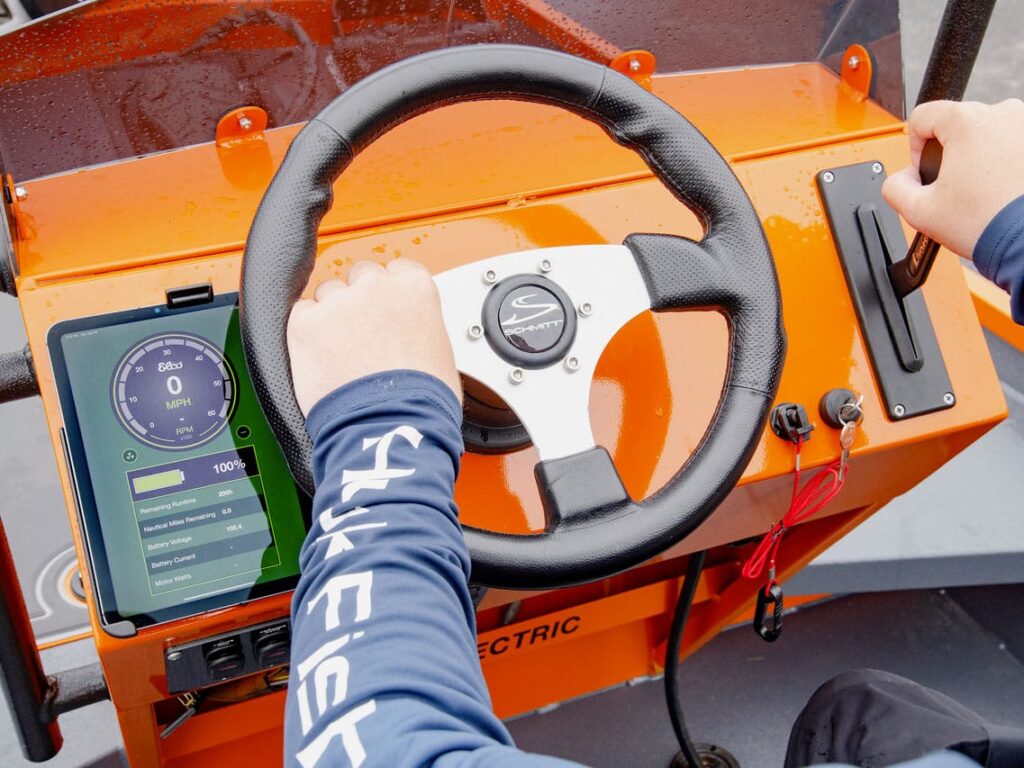
Hardwired Horsepower (DIY or Dealer)
Elco, Torqeedo, ePropulsion and Flux offer motors equivalent to gas outboards from 5 hp to 25 hp. These typically connect to fixed battery banks mounted aboard. Most companies offer self-installation packages that call upon basic mechanical skills. All facilitate turnkey installation through dealer networks. Flux eliminates DIY installation, partly because its outboards utilize higher voltages than others in this horsepower range.
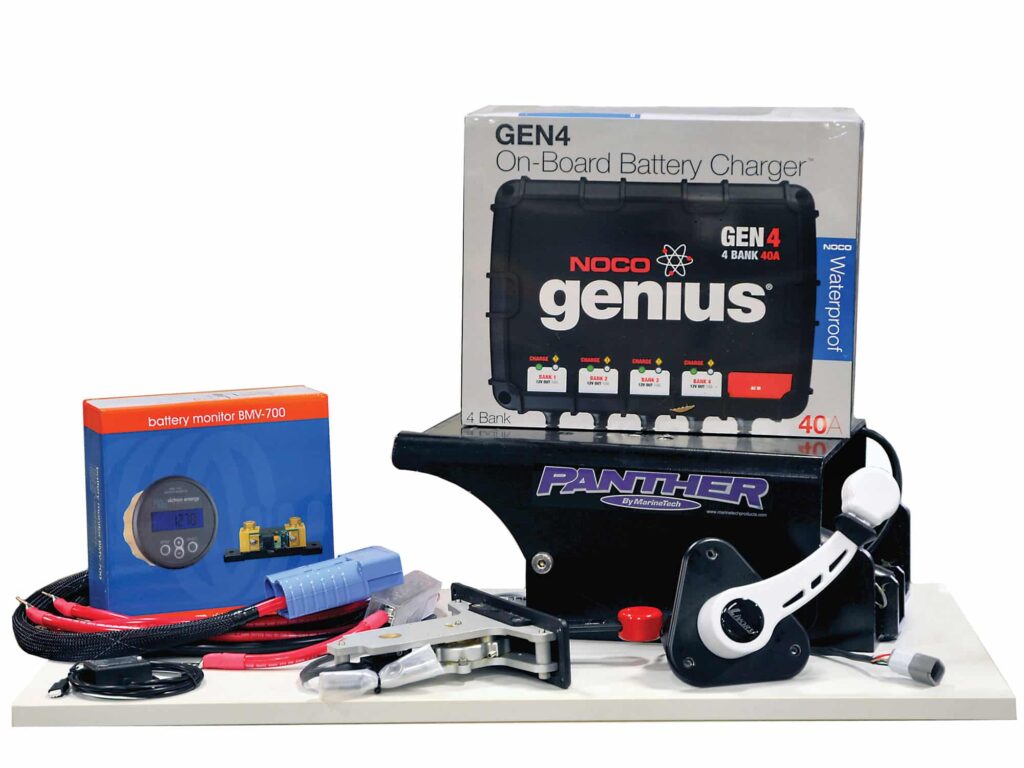
These midsize motors tend to work best for bigger boats at slower speeds. Elco, for example, says its EP-20 can push a 24-foot pontoon boat about 8 mph for two hours, while the same charge provides more than 10 hours of battery life at 5 mph; the cost is around $11,500. Just be sure to choose adequate power to dock in a breeze and then back off the throttle to extend range.
Planing Power (Dealer, Some DIY)
Elco, Torqeedo and Flux offer motors comparable to ICE outboards from 30 hp through 100 hp. Most utilize twice the operating volts compared to companies’ smaller outboards, with those added volts providing more short-term power, which is needed for the few high-load moments while boats climb fully onto plane. Only Elco facilitates DIY installation within this power range, even offering pre-made cables, equipment and accessories. The complete package propelling Rock Proof’s ePro 1760R , a boat we tested in Boating ’s March 2023 issue, utilizes Elco’s EP-50 and 20 kWh of lithium batteries; it sells for about $22,500.
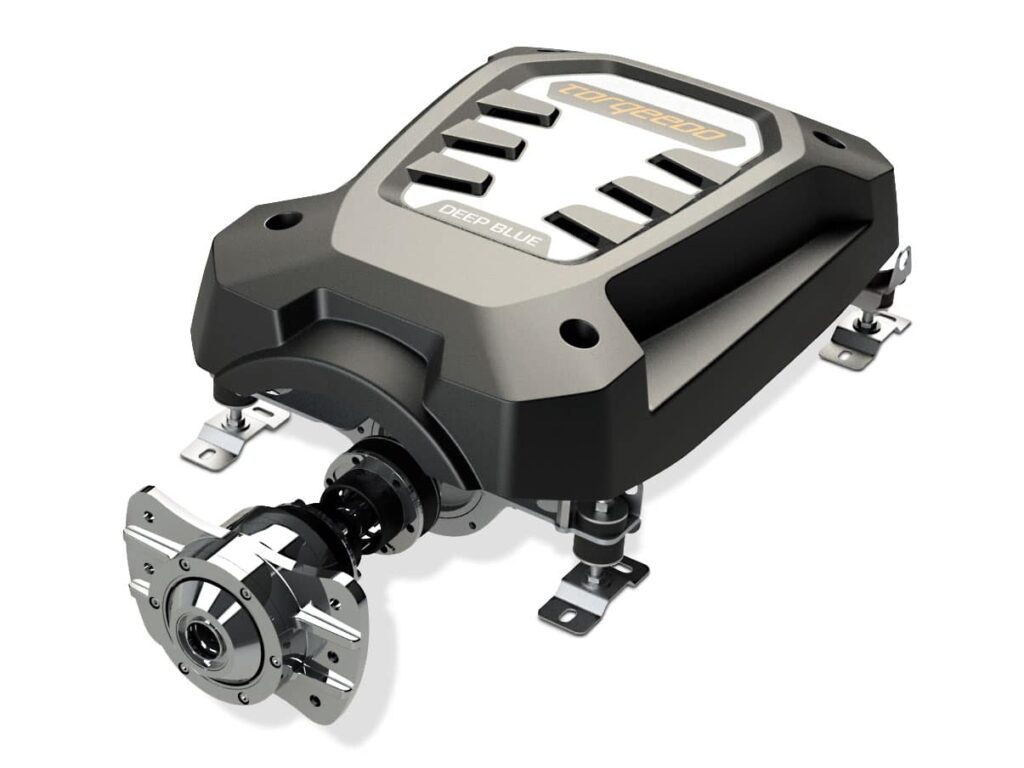
Inboard Options (Dealer, Some DIY)
While Elco has offered modern electric-propelled launches since 1987 and inboard repower options since 2009, its newest inboard motors are one-third smaller and half the weight of previous models, illustrating industry trends. Torqeedo and, recently, ePropulsion also offer powerful, light inboard motors for either repower or OEM installation. Most are intended to operate at modest speed, although Torqeedo offers three models operating at higher rpm for planing boats—its largest replaces 135 hp ICE engines while weighing one-third of a comparable ICE inboard motor and transmission (195 pounds plus batteries versus 567 pounds for a 135 hp MerCruiser 3.0 bobtail). A complete system with batteries that can run 50 minutes at full throttle costs about $120,000.
Read Next: Going Electric to Repower an Antique Boat
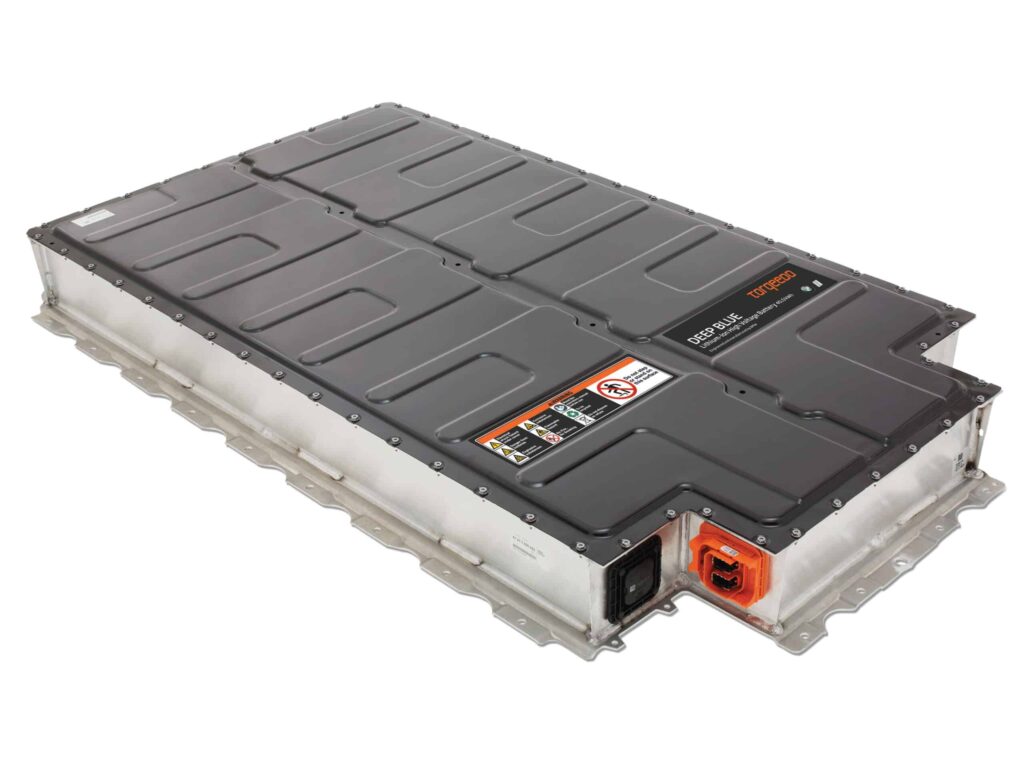
Electric motors ranging from 5 hp to 25 hp typically operate at 24 or 48 volts. This provides the broadest battery choices to balance size, weight, range and cost. All Elco and many Torqeedo motors accommodate any brand or battery type that meets specifications, adding flexibility. Absorbed glass mat (AGM) batteries , for instance, save considerable dollars compared to lithium for slow-speed boats. Larger motors, particularly when boats approach planing speed, require lithium batteries, which are half the weight yet provide higher continuous output compared to AGM.
- More: August/September 2023 , Boats , elco , electric boats , Engines , torqeedo
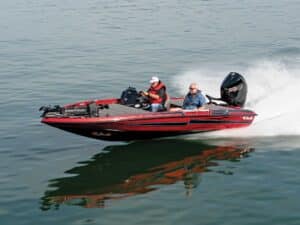
Boat Test: 2024 Bass Cat Caracal STS
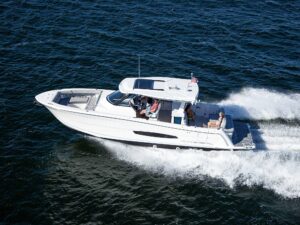
Boat Test: 2024 Regal 38 Surf
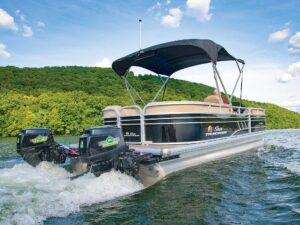
Using Hydrofoils to Improve Boat Performance
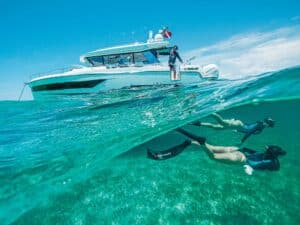
Six Boats Built for Adventure
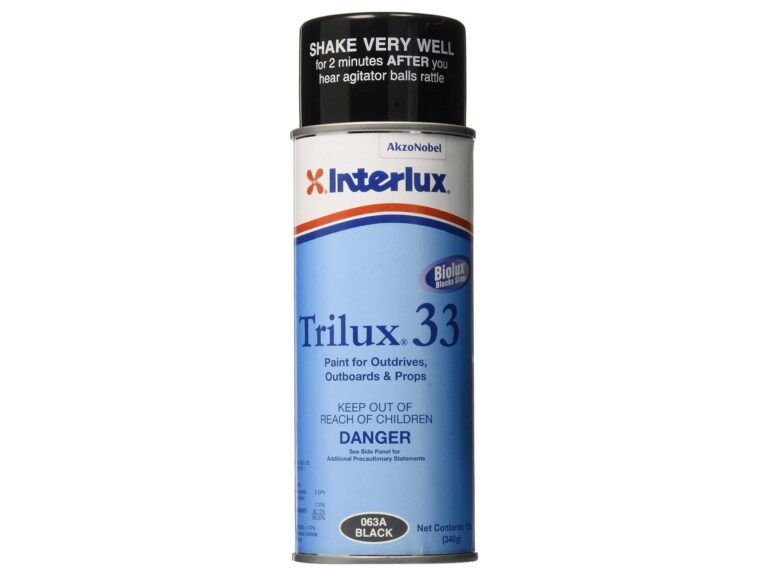
We Test Interlux Trilux 33 Aerosol Antifouling Paint

Boating Shoes for Spring and Summer

MasterCraft Celebrates International Women’s Day With Fourth Annual ‘Let Her Rip’ Campaign
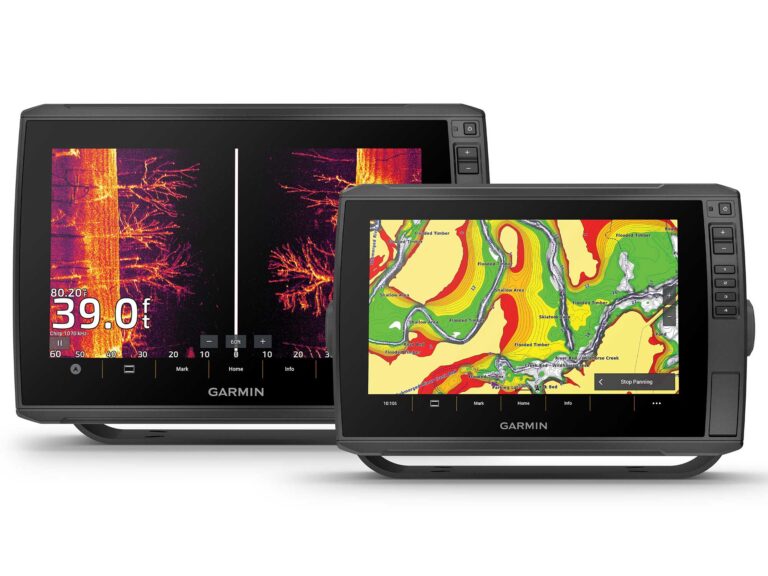
Garmin EchoMap Ultra 2 Series

- Digital Edition
- Customer Service
- Privacy Policy
- Terms of Use
- Cruising World
- Florida Travel + Life
- Sailing World
- Salt Water Sportsman
- Sport Fishing
- Wakeboarding
Many products featured on this site were editorially chosen. Boating may receive financial compensation for products purchased through this site.
Copyright © 2024 Boating Firecrown . All rights reserved. Reproduction in whole or in part without permission is prohibited.

What Size Electric Motor Do I Need for My Boat?
If you’re planning to buy an electric motor for your boat, one of the most important things to consider is the size of the motor. The size of the electric motor you need depends on several factors, such as the weight of your boat, the type of water you’ll be sailing in, and the speed you want to achieve. In this article, we’ll discuss how to determine what size electric motor you need for your boat.
Weight of Your Boat
The weight of your boat is one of the most important factors when it comes to choosing an electric motor. A heavier boat will require a more powerful motor to propel it through the water. To determine the weight of your boat, you can use a scale or check with the manufacturer.
Type of Water
The type of water you’ll be sailing in is another factor that affects what size electric motor you need. If you plan on sailing in calm waters, such as lakes and rivers, a smaller motor may be sufficient. However, if you plan on sailing in rough waters, such as oceans or large lakes with heavy currents, a larger motor will be necessary.
The speed at which you want to sail also affects what size electric motor you need. If you’re looking for a leisurely cruise around calm waters, a smaller motor will suffice. However, if speed is a priority for you and your boat has a higher weight capacity, then a larger motor may be necessary.
How to Calculate Motor Size
To calculate what size electric motor your boat needs, there are some general guidelines that can help:
- If your boat weighs between 1,500 and 3,000 pounds and will sail in calm waters at speeds up to 5 mph – choose an electric trolling motor with at least 30 pounds thrust.
- If your boat weighs between 1,500 and 3,000 pounds and will sail in rough waters at speeds up to 5 mph – choose an electric trolling motor with at least 50 pounds thrust.
- If your boat weighs between 3,000 and 4,000 pounds and will sail in calm waters at speeds up to 5 mph – choose an electric trolling motor with at least 40 pounds thrust.
- If your boat weighs between 3,000 and 4,000 pounds and will sail in rough waters at speeds up to 5 mph – choose an electric trolling motor with at least 80 pounds thrust.
10 Related Question Answers Found
How big of an electric motor do i need for my boat, what size motor do i need for my boat, what size motor should i put on my boat, what size boat motor do i need, how do i know what size motor for my boat, what size motor do i need for a 14 foot boat, what size trolling motor do i need for my boat, what size motor do i need for a 14 foot aluminum boat, what size generator do i need for my boat, how big of a motor can you put on a 14ft boat.

Emma Gibson

- Gear Directory
- Multihull Sailor
- Boats for Sale
- Real Estate
- Maintenance & Hardware
- Water Sports
What Size Trolling Motor Do I Need? A Guide To Sizing, Voltage, and Power
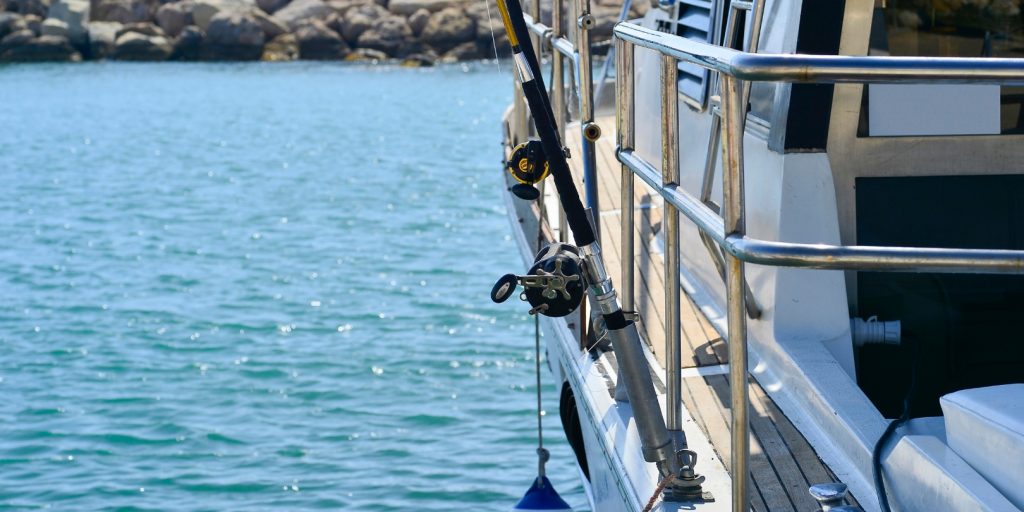
- 1 Types of Trolling Motors
- 2 Determining What Size Trolling Motor You Need
- 3 Voltage Considerations
- 4 Power Considerations
- 5 Other Factors To Consider
- 6 Conclusion
Are you looking to purchase a trolling motor for your boat? It can be an intimidating process, as there are many factors you will need to consider. What size trolling motor do you need? What type of battery do you need? What type of power output will suit your boat?
If you’re looking for a new trolling motor, you’re in the right place. This comprehensive guide will take you through everything you need about sizing, voltage, and power for your trolling motor. We’ll also offer tips on properly caring for your motor and extending its life. With this knowledge, you can choose the best motor for your boat.
Types of Trolling Motors
Selecting the proper trolling motor for your boat can be challenging due to the variety available, each with its advantages. Gas-powered trolling motors suit larger boats, offering more power, longer run times, and faster speeds. They tend to be noisy and require regular maintenance.
Electric trolling motors are suitable for smaller boats, kayaks, and bass or panfish boats. They are quieter and more cost-effective to maintain than gas-powered models. Electric motors come in various sizes, determined by voltage based on the boat’s power requirements and the terrain it will navigate. The thrust of the electric motor should match the weight of the boat and the motor combination used.
Determining What Size Trolling Motor You Need
Selecting the right size trolling motor for your boat requires careful consideration of several factors. First and foremost, you should consider the type of boat you’ll be using. Boat size and weight are crucial in determining the appropriate trolling motor, as different boats demand varying thrust levels and power to move efficiently.
After identifying a suitable trolling motor based on your boat size, the next step is to calculate the combined weight of your motor and the boat. This calculation will help you determine the amount of thrust and power you need to navigate the water effectively.
Consider how your boat handles the water and the specific activities you plan to engage in, such as fishing or cruising. Understanding these aspects will help you decide whether a higher voltage or greater thrust is necessary to suit your specific needs and preferences.
Voltage Considerations
Selecting the appropriate trolling motor requires careful consideration of voltage requirements based on boat size and the specific terrain you’ll be navigating. For smaller boats like canoes or jon boats that frequent shallow and calm waters, a 12-volt motor is typically sufficient. These motors are suitable for leisurely activities like fishing or relaxed cruising near shorelines, where high-speed performance is not a priority.
For mid-sized boats, such as bass boats that venture into slightly deeper waters with moderate currents, a 24-volt motor offers the appropriate balance of power and maneuverability. It caters to activities that demand increased speed or handle heavier loads without overstraining the battery with unnecessary amps, thus ensuring longer battery life.
Larger boats, like pontoon boats, navigating deeper waters with strong currents, benefit from the power of a 36-volt motor. This setup allows for faster speeds over longer distances and is particularly useful for activities like wake surfing, skiing, or wakeboarding , where quick maneuverability and sustained high speeds are required.
Power Considerations
After determining the suitable voltage for your boat, the next step is to assess the required thrust or power. Different boat sizes demand varying amounts of thrust depending on their weight. Smaller vessels generally need lower thrust, while larger ones require higher power to accommodate the heavier weight displacement that could otherwise slow down progress.
To accurately calculate the required power, consider the total weight of your boat and motor combination. Add 10% as a buffer to account for potential challenges or upgrades, such as adding live wells or anchors. This overage ensures you can consistently meet your desired speed specifications without straining or draining the trolling motor battery too quickly, providing proper power delivery throughout your voyages.
Other Factors To Consider
When purchasing a trolling motor, there are several important considerations to remember. The shaft length is crucial in determining the propeller’s depth underwater, affecting maneuverability in tight spaces and shallow waters to avoid potential damage. Research the maximum compatible speeds based on the motor’s design capabilities, ensuring the right power levels for various activities without drastic modifications when circumstances change.
Many electric trolling motors have features like LED lights for easier night fishing and variable speed control knobs that offer precise control, eliminating costly upgrades. When coupled with proper trolling motor batteries, these features allow for optimal performance ratios, making them ideal choices for achieving goals without overspending. Considering these factors, you can confidently select the best trolling motor that aligns perfectly with your boating needs, ensuring a satisfying and efficient experience on the water.
Selecting the proper trolling motor for your boat can be daunting. With so many types of trolling motors available, it can be difficult to know which one is best for your boat. By following this guide, you can make an informed decision and choose the appropriate motor for your boat. With the proper motor, you can enjoy many hours of fishing, cruising, or whatever other activities you may have planned with the peace of mind that your boat will have the power to get you there.
Article Contributors
Sail magazine review team.
SAIL Magazine Review Team reports on best-selling products in sailing and boating. The SAIL Magazine editorial staff is not involved in the creation of this content. SAIL Magazine is reader-supported: When you buy through links on our site, we may earn an affiliate commission. The SAIL Review Team is composed of authors, editors, and sailors. Artificial Intelligence (large language models) may have been used in the research and creation of the content.
To ensure questions about product testing or a specific article are addressed, please contact [email protected]
Related Reads

How To Size A Trolling Motor Correctly For Your Boat (Detailed Guide)
UPDATED 17 MAY 2023
by Eric Bartlett
When buying an electric trolling motor, it’s essential to get the right size for your boat.
Trolling motor size has two main components: thrust (or motor power), and shaft length.
Table of Contents
Both of these need to be correctly matched with your boat, and getting it wrong can result in major headaches on the water.
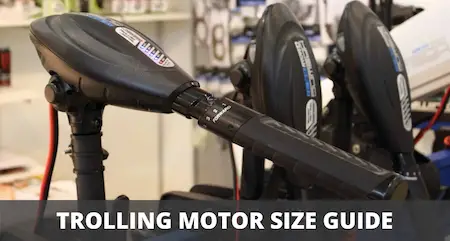
In this article we’ll walk you through how to choose trolling motor size, thrust and shaft length to match your boat size.
What size trolling motor do you need?
As a rule of thumb, a trolling motor should provide about 2 pounds thrust for every 100 pounds of fully loaded boat weight.
However, if you expect to encounter strong winds or currents, you’ll need more power.
In a case like that, it’s necessary to add about 10 to 20% additional thrust in order for the motor to perform adequately.
But keep in mind that boats with a deep draught provide more resistance to a water current than boats with a shallow draught, and thus require a larger trolling motor.
Also, boats with a large deck height above water (such as pontoon boats), provide a lot of surface for the wind to push against, and therefore require additional thrust to deal with strong winds.
So the specific amount of thrust you’ll need for your specific situation could require more thrust than you expected.
When in doubt, it’s usually best to get an overpowered trolling motor, since that’s easier to compensate for than an underpowered one.
Trolling motor size chart
The table above shows the average pound trolling motor thrust required for different boat weights and lengths. Column 3 shows the minimum thrust you need for each boat size, while column 4 shows the higher thrust levels required for dealing with strong wind or current.
In general it’s better to err on the side of having too much thrust, rather than too little, as that gives you more flexibility to deal with unexpected circumstances.
But keep in mind that the table above is an approximation for an average boat, and in addition to wind and current, your boat type may require different amounts of thrust (more on that below).
If you’re currently in the market for a new trolling motor, check out our article on the cheapest spot lock trolling motors reviewed .
Trolling motor thrust guide for different boat types
Let’s look at the thrust required for some of the most common recreational boat types, to help you choose the right trolling motor size for your boat.
What size trolling motor do you need for a bass boat?
The table above shows the recommended thrust for different bass boat sizes.
While bass boats are usually lighter than other boat types of comparable length, most bass anglers prefer to use bigger trolling motor sizes, from 80 lbs all the way up to 120 lbs thrust.
The reason for using high-powered trolling motors for bass boats is that it enables you to fish anywhere, including spillways, river currents, or wind swept flats.
Also, bigger trolling motor sizes come with 24V or 36V batteries , which have a longer lifetime, and thus work well for bass fishing tournaments.
What size trolling motor do you need for a jon boat?
The table above shows the recommended thrust for different jon boat sizes. Jon boats are usually very lightweight, which means you’ll be fine with a 45 to 55 lbs thrust trolling motor.
The main exception to this is if you plan to take a lot of passengers on board larger sized jon boats . In that case it’s better to use a bigger 70 to 80 lbs thrust motor.
What size trolling motor do you need for a pontoon boat?
The table above shows the recommended thrust for different pontoon boat sizes. Since pontoon boats have a very shallow draught, they won’t have a lot of problems with a strong current.
However, since pontoon boats usually have a large deck height above water, strong winds do pose a problem, especially if you’re using a spot lock trolling motor to keep your pontoon boat in a specific location. In that case, it’s better to go with a bigger trolling motor size.
What size trolling motor do you need for a canoe?
Since canoes rarely exceed 500 lbs in fully loaded weight, a 30 lb thrust trolling motor is strong enough for most situations without much current, while a 40 to 55 lb thrust is a better choice if you are expecting to encounter a stronger current (on a river, for example) or wind.
What size trolling motor do you need for a kayak?
A 30 lb thrust trolling motor is plenty strong enough to power a kayak, which rarely exceeds 300 to 400 lbs in fully loaded weight.
The main exception to this is ocean kayaking, where you can expect to encounter a strong current. In that case, a 40 to 55 lb thrust trolling motor is the best choice.
Trolling motor shaft length
It’s important to choose the right shaft length for your trolling motor, to ensure the prop is submerged deep enough in the water to function properly.
But the problem with this is that different boats have different deck heights above water, and in addition there are different mounting locations for a trolling motor , the most common of which are bow mount and transom mount.
As a rule of thumb, the prop of your trolling motor should be submerged 15 to 20 inches below the water.
So you need to measure the distance between the deck and the water, and then add 15 to 20 inches to that to calculate the ideal shaft length for your trolling motor.
Shaft length for a bow mount trolling motor
The table above shows the recommended shaft length for bow mount trolling motors, depending on the height of the bow above the waterline.
Since the height of the bow above the waterline varies a lot from boat to boat, it’s important to measure this before you buy a trolling motor.
Also, keep in mind that the bow can be much higher above the waterline than the transom, and so often requires a longer shaft length.
Shaft length for a transom mount trolling motor
The table above shows the recommended shaft length for transom mount trolling motors, depending on the height of the transom above the waterline.
Since most boat transoms are usually quite close to the waterline, you need to choose a shorter shaft length for transom mounted trolling motors than for bow mounted ones.
This also means that you can’t switch a trolling back and forth between bow or transom.
Once you’ve chosen your new trolling motor, you may also be interested in our guide on where should you mount a trolling motor?
How is trolling motor shaft length measured?
The length of a trolling motor shaft is measured from the bottom of the motor head down to the top of the motor housing (which is the part with the propeller on it).
This can be a little confusing, because some trolling motors (especially transom mounted ones), have their mount positioned in the middle of the shaft.
Can a trolling motor shaft be too long?
Yes, a trolling motor shaft is too long if the prop protrudes significantly below the deepest point of the hull. If the shaft is too long for your vessel, the prop will tend to churn up mud and weeds in shallow water, so it’s important to choose the right shaft length.
Trolling motor battery size
The table above shows the required battery voltage for different trolling motors, depending on their thrust rating. If you’re not sure which thrust rating is right for you, check out our article: is it better to use a 12v or 24v trolling motor?
Once you’ve chosen the right trolling motor size for your boat, you also need to get the right battery for it. Depending on the thrust rating of the trolling motor, you’ll need either a 12v, 24v, or 36v battery system for it.
You can wire two 12 volt batteries together in series to generate 24 volts, and 3 in series will generate 36 volts. However, keep in mind that a single 24v or 36v battery weighs less, and occupies less space, than 2 or 3 12v batteries wired together.
And finally, a few trolling motors (including the Lowrance Ghost and Garmin Force), are compatible with either 24v or 36v.
The nice thing about this is that you can adjust the thrust of these trolling motors up or down by changing your battery voltage from 24 to 36, and vice versa.
Another factor that’s worth mentioning is that a battery system with higher voltage has a longer runtime than a system with lower voltage, which means you get a longer runtime.
- Spirit 1.0 Plus
- Spirit 1.0 Evo
- Pod Drive Evo
- E-Series Battery
- G102-100 Battery
- Find a Dealer
- Have a Dealer Contact Me
- Product Registration
- Support Center: FAQ & Guide
- Video Tutorial
- Download Center
- Performance Bulletins

Electric Outboard Motors: All You Need to Know (Best Picks in 2023)
Electric outboard motors have got a lot of attention these days: It is silent, clean, and maintenance-free with NO fuel or exhaust smells.
With the hype of high power electric outboard motors, it seems that the electric outboard motors now offer a viable alternative to combustion motors, making it a great option for many boats including kayaks, dinghies, canoe, inflatables, and sailboats.
But the electric outboard price might again put you in a dilemma.
Is the electric outboard motor worth the upfront investment? What’s the range and runtime of electric outboards? What’s the most powerful electric outboard motor available and affordable today?
In this post, we are going to walk through all information about the electric outboard motors for boats and help you select the best electric outboard that fits your needs.
Table of content:
- Electric Outboards Motors Are Not Trolling Motors
- Electric Outboard Motors for Boat: What You Need to Know
Reasons to Go for Electric Outboard Motors
- Best Electric Outboard Motors (Reviews & Videos)
Hottest FAQs About Electric Outboard Motors
- Final Thoughts About Electric Outboard Motors
Editor’s Note: Electric outboard motors as well as other electric vehicles are measured by W (watts) instead of hp (horsepower). So if you are looking for a 3 HP electric outboard motor, it should be a 1000 W outboard that has an equivalent power of a 3 HP petrol motor.
In order to help you better understand the power range of electric outboard motors especially for those who are new to the electric motors, we will just use HP to describe the power of electric outboards in this post.

Electric Outboard Motors Are Not Trolling Motors
Before we get into depth, let’s make it clear that here we are talking about electric outboard motors. Not trolling motors or electric start combustion outboards.
Unlike the trolling motors (measured in static thrust) that can only go at slow trolling speed, true electric outboard motors can provide much higher power: They are designed to be used as the primary power source.
Even small electric outboards, for example, the popular 3hp electric outboard motor, would be enough to power boats weighing up to 1.5 tons including dinghy boats, inflatables, and small sailboats, at a speed of 5 knots (conditions apply).
If you have no idea which one to choose between electric outboard motor and trolling motor (like the Minn Kota motors), check out our previous post for a detailed comparison.

Electric Outboard Motor for Boat: What You Need to Know
The electric outboard motor is definitely appealing but the flooded information on the Internet could be overwhelming and get you lost especially if you are new to electric boating.
Here I have rounded up the top 5 frequently asked questions (with quick answers) so that you can easily decide whether to get an electric outboard motor for your boat.
Electric Outboard Motor Runtime & Range
Curious to know what sort of battery life and range the electric outboard motors get in a marine environment. “I don’t want to run out of charge on the water.”
This is the proverbial piece of string question.
The electric outboard motor runtime and range depend on how fast you run it, how heavy the boat is, how much tide is running in which direction, the battery charge state, the temperature… and more factors still.
Generally speaking, with the Spirit 1.0 Plus 3 hp electric outboard at half power you should get 13.3 miles or 21.3 km.
Most electric boat motors will allow you to adjust it to a slower speed for extra range and runtime. Plus you can always read the battery level/estimated range left on the screen, so you’ll never get stuck.
Here is a table that shows the estimated range and runtime of the 9.9 hp electric outboard at different speed levels with a single charge of one battery.
Electric Outboard Motors Range, Runtime & Speed
*Data collected from ePropulsion Navy 6.0 Evo electric outboard motor on a 12 ft aluminum boat (with exclusive ePropulsion E175 battery that’s 8960 Wh) with one person on boat in calm lake water.
Check the full test report of the Navy 6.0 electric outboard motor.
Electric Outboard Motor Speed
So how fast are electric boat motors?
The max speed of electric outboard motors varies greatly between different boats and working environments. The higher power, the higher speed.
Below you will find a selection of real-world test reports using the ePropulsion Spirit 1.0 electric outboard motor in a selection of different styles of the boat.
Want a higher power electric outboard to keep your boat at a higher speed?
It’s still a great challenge for today’s technology. Just as I mentioned above, the electric outboard motors need a large battery capacity to keep a high speed.
The amount of battery power needed to move a boat is like 10x more than a motor vehicle.
Let’s say you can go at 5 knots with a 10 hp electric outboard motor. And if you want to speed up to 15 knots, you will probably need a 100 hp electric outboard, and that requires much more energy and battery than we can imagine and will cost a fortune.
That’s why the electric outboard motors under 20hp (3hp/4hp/5hp/10hp motors) are still the mainstream in the consumer market.

Electric Outboard Motor Price
Electric outboards are interesting but I don’t understand why they cost more than a petrol outboard.
Think about the challenges of battery size vs range in electric outboard motors:
The electric outboard boat motor needs a large battery capacity especially if you are planning for a long trip.
Given that the batteries have lower energy density compared to petrol and a boat is around 5 to 10 times less efficient in energy economy compared to a similar weight car, you’ll need a lot of energy (i.e. batteries) stored on the electric outboard motor to push the boat along.
And the batteries are expensive.
Another reason is that the economies of scale have not kicked in yet within the industry although the electric outboard motors are getting more and more popular these days.
An exception:
Actually the 3 hp electric outboard motor outperforms the petrol outboard on price (and virtually any functionality you could care about for a boat outboard) if you take the maintenance fee ($180/year, if you dont service it you lose warranty) and fuel/electricity cost into account.
Take ePropulsion Spirit Plus , the 3 hp electric outboard motor with a built-in battery, for example:

That’s to say, with electric outboard motor Spirit 1.0 Plus, it’s only 3 years before the saving start. And as the service time increases, you could even save more.
So actually the electric outboard motors are a cost-effective option within a few years of use.
Notice: You might be in the market of the used electric outboard motor and looking for one during special sales or on the deals website. But it is not recommended to go this way as those electric outboard motors for sale might not guarantee your full warranty.
Electric Outboard Motor Battery Charging
The good news is that most electric outboard motors can be fully charged overnight. So it’s convenient and won’t impede your schedule.
Some reputable electric outboard motor manufacturers like ePropulsion also feature quick charging that can cut down the charging time in half.
Solar charging is also possible, you can discharge and charge the battery at the same time meaning you can extend the range of your boat on sunny days
Extra tip: If you are a sailing enthusiast, be sure to check out the electric outboard motors that come with hydrogeneration, like the ePropulsion Evo Series . It takes advantage of the wind energy to charge its batteries while sailing, so you can have extra power for an extended range of sailing or charging other facilities on board.
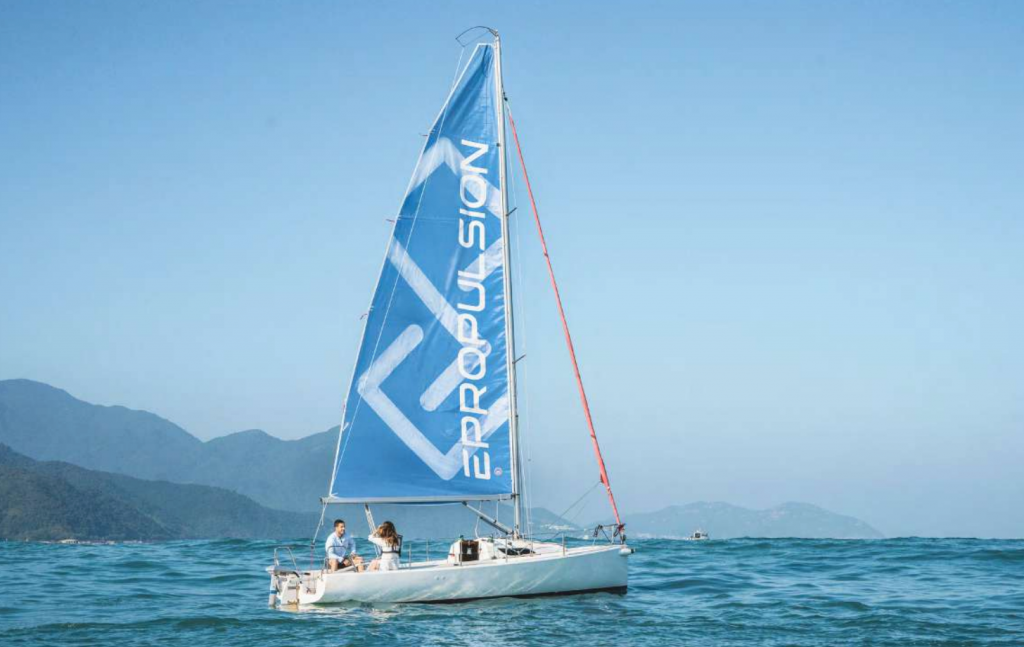
Check out how the hydrogeneration works on sailing with Captain Rick Moore (starting from 7:48).
Electric Outboard Motor Weight
The electric outboard motor and battery weight could be a concern, especially for the elderly. Boating is enjoyable, but lugging the heavy batteries over boggy ground to get to a boat in remote areas is definitely not tempting.
If you are looking for a portable electric outboard motor, consider the one with a built-in battery. The electric outboard motor with battery is easy to transport and could save you a lot of trouble.
Some electric outboard motor batteries can even float in the water so there is no need to worry about dropping it while installing the outboard.
Looking for a higher power electric outboard motor?
It will need standalone batteries to power the electric outboard. If you are going this way, we’d recommend looking at the E-Series LiFePO4 battery range.
The E-series electric outboard motor batteries offer a modular system from 2048 Wh to 8960 Wh. They are very affordable marine-grade batteries with a long lifespan.
Are electric outboard motors any good?
The benefit of electric outboard motors is obvious to anglers and almost overwhelming to those who are looking for a premium boating experience.
Check out the top 4 reasons why hundreds of thousands of people go for electric outboards.
- Silent. You will hear virtually nothing on board. There will be no disturbing noise to spook the fish. It’s only you and nature.
- Clean. There will be no greasy dirt to stain your hands, clothes, deck, and trunk during use and transportation if you get an electric outboard motor for the boat.
- Less Maintenance. Thanks to direct-drive technology, the electric outboard motor has less moving parts, reducing the time and cost of regular maintenance.
- Exhaust-free. There are no fuel or exhaust smells, so it protects the health of you and the families.
With more regions and lakes banning the use of combustion motors, electric outboard motors have become the only option for some anglers and boating enthusiasts. It is a new trend and could be the future of boating.
Electric outboard motors could also work as a secondary engine (kicker, auxiliary engine). A lot of users also find it helpful in emergencies if the main motor breaks.
Best Electric Outboard Motors in 2022
Having been toying with buying an electric outboard motor for a while but had no idea which outboard motor is the most reliable? What’s the best electric outboard motor?
Here are top 2 recommendations trusted by dozens of thousands of users worldwide.
#1. 3 HP Electric Outboard Motor: ePropulsion Spirit 1.0 Plus
If you are looking for a reliable, affordable, and portable electric outboard motor for the dinghy, inflatable and fishing boats, sailboats, and tenders, the Spirit 1.0 Plus is your best choice.

This electric outboard motor with a built-in battery provides 3 hp equivalent horsepower and can go up to 22 miles at 4.5 mph, or keep running all day long at trolling speed.
Highlights:
- Direct-drive motor, maintenance-free
- 1276Wh capacity for 4-hour economical speed runtime
- Floating battery, you’ll never lose it if it drops into the water
- 180W solar charging for extra charging
- Lightweight (42lbs including the battery)
- Folding tiller, easy to pack and carry the motor
- Digital display, you’ll always know the battery level, remaining runtime, etc
- 3 hours full recharge with quick charger
- Designed for freshwater and saltwater
As an electric outboard motor for saltwater and freshwater, the Spirit is durable and efficient to be used in the lake, marine, and simply any kind of environment.
Check out how the Spirit performs in the water on this genuine electric outboard motor review:
For advanced hydrogeneration capacity, check out the Spirit 1.0 Evo . You will love it on sailing.
#2. 9.9 HP Electric Outboard Motor: ePropulsion Navy 6.0 Evo
If you want a higher power electric outboard motor for dinghies, aluminum fishing boats, daysailers, and cruising sailboats, be sure to check out the ePropulsion Navy 6.0 outboard.

With this 6kw 9.9 (10) HP electric outboard motor, you can easily go 40 miles within one charge, or go fishing all day at trolling speed.
- Customized E-Series electric outboard motor batteries
- Compatible with 3rd party battery
- Wireless control
- The digital display informs you of the real-time operation status
- Kill stop switch to keep you safe on board
- Propeller collision emergency stop
Check out what users have to say about the Navy 6.0 electric outboard motor:
Want to learn more about the product and get advice on purchase? Fill in this quick form within 3 minutes, and we will get in touch shortly.
A single post could not answer all questions about the electric outboards. We’ve picked out the most frequently asked ones below with short answers.
If you have any further confusion about the electric outboard motors, leave them in the comment and we’ll get back to you asap and add yours to the list.
#1. How rock proof are electric outboards?
The electric outboard motor blade is usually made of solid materials and ePropulsion motors feature propeller collision emergency stop
However, the rock or oyster bed could still possibly cause damage to the motor. If you are worried, you can always protect the outboard with some propeller guard.
#2. What is the most powerful electric outboard motor?
The most powerful electric outboard motor by far is 80 hp rated, and it is mostly for commercial use due to the high initial cost.
#3. What size electric outboard do I need?
To get the right size electric outboard motor, you need to consider the boat size (weight/length), boatload, your desired speed, and the boating environment, etc.
Generally speaking, a 1kw3hp electric outboard motor is enough to provide a satisfying speed and range for tenders, dinghies, and daysailers up to 1.5 tons, and 6kw10 hp electric outboard motor is for RIBs, fishing boats, and cruising sailboats up to 6 tons.
Electric Outboard Motor for Boat: Final Thoughts
With the unbeatable advantages like quietness, clean, exhaust-free, and the lower overall cost with a few years of use, electric outboard motors are gaining more popularity over time.
You will see more and more electric outboard motors for sailboats, kayak, canoe, and dinghy boats on sale and in use for the upcoming years, especially with the push of the government.
If you’re interested but not sure what type and size of electric outboard motor suits you best, leave us a message on the comments and we’ll try our best to help you find the best pick.
If you are looking for an electric outboard motor in the UK, US, NZ, Canada, Australia, or any other regions worldwide, and want a quick delivery, you may check out the local dealers and order directly from them with solid support if there is an issue coming up.
Recent Posts

ePropulsion Sustainably Mobilizes Hundreds of Sightseeing Bamboo Rafts on the Guilin Li River

Bass Boat Motors: The Only Guide You Need in 2024

ePropulsion’s Revolutionary eLite Electric Outboard Motor Wins Innovation Award in Miami
What recommendations can you make to lock the motor, especially the battery since it’s easy to remove when docked?
Hi delanovr, you can use a motor lock to secure the outboard. As for the battery, it’s lightweight making it easy to uninstall and remove when not in use.
A chain and padlock through battery handle and around the lock would also help to secure both. Feel free to let me know if you have any further question.
I have a 16′ pontoon (Tahoe) with Minnkota e-drive. 4-4.5 mph. Would like a bit more speed. 7-8 mph. What would you suggest?
Hi Bob, you may take a look at the Navy 6.0 Evo for your application https://www.epropulsion.com/navy/
What electric motor would be best for a 12′ Aluminum boat?
Hello dsrtcrttr, it’s actually depends on many factors including your desired speed, boat load (gear and passengers), and the boating environment. Could you offer more details about your application of the aluminum boat?
You may also check out our test data with similar sized aluminum boat and see if the performance meets your needs on this page https://www.epropulsion.com/performance-bulletins
Hope the information helps!
I have a 10 foot Bass buster or a 2 person Pelican . Do have a trolling motor . Question is what size of electric outboard motor do I need ? Have read your information on this site but still need help . New on boat . Would like a 3.5 electric but still need your advice . Will appreciate all the help you can give me Thank you ,
Hello Fermin, the 3 hp Spirit 1.0 Plus is a great choice for your situation. Check out our test date with Spirit motor on a smiliar boat here:
https://0220afca-6e42-4f45-a99f0362b314126d.filesusr.com/ugd/77b59c_c8de34d4bc7e4077b1865462e7a614d7.pdf
Please feel free to let me know if you have any further question
I have a 16 ft 4 person skiff to cruise around the river. Will the 3 hp electric motor push us for 4 hours of cruising? The whole river is “slow no wake”
Hi Neil, the actual running time is largely depend on your speed requirement and the boat load. Could you provide more information on that?
According to our test, our 3hp electric motor Spirit 1.0 can run for 4 hours at 4.4mph on a 14ft boat. And if you reduce the speed to 3.5mph, it can last for 8 hours.
I have a 14’ speed type boat with 50hp but was thinking electric for emergency back up?
Hi John, yes, the electric outboard can be great backup for your speed boat.
Happy new year!!!
could i use a small gas generator with a convertor to 12 v ?
Hi Tom, you may use our Spirit 12 V charger ( https://www.epropulsion.com/product-page/spirit-1-0-dc-charger-12v-24v/ ) to charge the Spirit battery directly from 12 v power source.
The bigger the wave, the more support you need from your beginner surfboard. Be sure to check out the trucks to see if you want a set that has wider and deeper “tubes” for the “wave” you’re planning on riding.
I have a 13′ Saturn kaboat (inflatable). Is the outboard or pod option better for us? The boat can hold about 900 lbs and we take up 550 of that.
Hi Barb, it would be better to use an outboard for inflatable boats as it’s easier to install and doesn’t require drilling a hole on the boat. Feel free to let me know if you have any additional questions.
Hi – I’ve got a 2500pound (1.25t) multihull sailboat. Don’t have a lot of room and want to keep the weight down. Which outboard would you recomend? Thanks!
The ePropulsion Pod Drive Series ( https://www.epropulsion.com/pod-drive/ ) is a better fit for you since it is designed for space-saving applications.
As for the horsepower recommendation, if you are using it as auxiliary power source like entering and existing a marina, the 1 kw Pod Drive 3.0 would be enough for you. And if you are looking for a more powerful motor, check out the 3 kw Pod Drive 6.0 Evo.
Hope the information helps and feel free to let me know if you have any furthur questions 🙂
I have read that the ESpirit 1.0 can be charged from a 12v source or solar panels. I cannot find any technical details about the 12V DC/solar control charger. Does the charger run off mains voltage supply? I have two 240v/12v 20A multistage chargers. Is it possible to charge the motor from those chargers connected in parallel (i.e. 40A maximum charge rate)? Do I also need the Eprop charger?
Hi Crispy, you will need the ePropulsion 12V charger due to the different connector and configured charging parameters.
I have 3 x 100W solar panels producing 57V. Does the charger also run off solar input at 57V?
Hi Crispy, the input voltage of solar panel should be ≤ 35V for the Spirit solar charger controller.
For more information about the ePropulsion solar charging, you can check out our ePropulsion Solar Charger Manual that’s available for download at our download center.
Hope this helps and let me know if you have any other questions.
I got wilderness atak 140. I make custom e motor and battery for it from cheap 360Wt trolling motor. Now i got about 5knots speed at 13V. Wanna chage it to get at least 8knots at full speed and need very low speed for fishing about 0.2knots. have u any modofications for intalling motor on kayaks?
Need electric outboard shot shaft with peddle control or rote
Hi Jack, did you mean the short shaft outboard with peddle or remote control? If yes, I would like to recommende the Spirit 1.0 Evo Remote which can be controlled remotely with a top mount or side mount control and allows for helm steering. It couldn’t be easier 🙂 Please feel free to let me know if you have further questions.
Hi Friends! What motor is recommended for a wood canoe that weight near 1 ton and full loaded 2.5 tons, normally we use 40-48hp, our daily tour is 8 hours roundtrip full power, important 1.30hours of rapids, waiting for a prompt answer, regards..
Hi there, ePropulsion’s outboard motor range is between 3-9.9HP, do you have any speed requirements? If we solely consider weights, Navy 3.0 or 6.0 Evo would be the choice of 2.5 full-loaded canoes. 8 hours of run time requirement should depend on the battery capacity and running speed.
Ment short shaft ….10 ft boat with steering wheel
Hi Jack, you may want to check out the Spirit 1.0 Remote short shaft version. It has 24.6 inches short shaft length and allows remote helm steering. For more information, please visit https://www.epropulsion.com/spirit-evo/
How many charge cycles can the battery take before it starts to lose capacity? What is the battery chemistry? What safety features are incorporated? Is it safe to use in hot climates (ex: the Mediterranean in Summer)?
For the ePropulsion Spirit Evo model, the cycle life of its Lithium-Polymer type of battery is ≥500 cycles (80% of Rated Capacity), and it’s recommended to be used at temperatures under 40 ℃. You may find more information on the user manual at our download center https://www.epropulsion.com/download-center/
Is it possible to have an idea of the prices of the various models please? In my country the “closest dealer” is a yacht-focused business and since I only have a small wooden boat I would prefer to have an idea of the price so I can at least check if the dealer has applied a fair mark-up. I have a small (but heavy) 14 foot wooden (plywood) boat that does not plane since it is based on a sailing boat design (with a small keel and a transom that leans back but has a place to mount the motor perpendicular to the sea). My main interest would therefore be the 3HP equivalent model. Thanks.
Hello John, may I know where you are located please?
I have a 40’ power boat that I use for trolling for salmon. It’s a 30,000 lb twin diesel boat. The problem is it trolls too fast even with one engine and I have an inflatable boat on the swim grid that takes up space. I was wondering if I used an electric outboard to move my boat 2-3mph would be excellent. I have large battery capacity and generator if needed. Are the electric outboards as heavy as gas powered? Compact? Thx
Hi Lee, the 9.9HP Navy 6.0 should be able to move your boat at desired speed. However there are many other factors come into play that may affect its performances. You may fill up this form and schedule a test ride with your local dealer to see whether it can satisfy your needs: https://epropulsion.typeform.com/dealer-contact Thanks!
Are there solar/wind charger options for the Navy 3.0/6.0? I see that it is mentioned on the Spirit (keenly interested).
Kindest regards,
Hi Donner, it depends on the batteries you are using together with the Navy 3.0/6.0. The ePropulsion E-Series battery can be charged with 3rd party solar panels. And the new Navy Evo models allow hydrogeneration.
To charge the ePropulsion E-Series Battery with only 3rd party solar panels, users need to set the solar charger float voltage to 57.6V. Meanwhile, the solar charger maximum discharge current needs to be less than 20A/40A/75A for the E40/E80/E175 battery collectively. Otherwise, the E-Series Battery would not be charged.
For more information about hydrogeneration and solar charging, you may visit our FAQ center https://www.epropulsion.com/support-center/
Hi i have a 21feet fast cruiser boat, with no engine,and wondering,if i can use the navy 6,as my very main propulsion.Will it be strong enough to move my boat happily ??Thanks
Will the navy 6 kw 10hp,move my 21feet fast hull power boat, their is no engines inside, Will like to use the navy 6 as my very MAIN PROPULSION.THANKS
Hi Achilleas, may I know what speed you are looking for with the Navy 6.0?
Hi have a 26ft 1800kg racing sail boat only sail on a large lake so no tides or big waves I was wondering if the 3hp would suffice in just getting us out of the marina with a speed limit of 3kts with a run time of about 40mins .
Hi, 3HP can only pushes boats up to 1.5 metric tonnes… we would recommend a 6HP like Navy 3.0 Evo.
I have a Stealth Stalker 10 , 10’ long &78#, that I would like to use in the San Pablo Bay which has winds and tides. The boat can use up to 4.5 hp. Any plans for an electric that size in the near future? Do you think the Spirit 1.0 would push this boat in the tides well enough? I read about the solar, but can you use an additional wet cell battery as a backup? Thanks.
Hi, the static thrust of the Spirit 1.0 is 316 N / 71 lbs, which is sufficient for pushing the Stealth Stalker 10 in the tides. However, we recommend ePropulsion brand dry cells batteries to have smooth and accurate access to the battery status.
Great Article! Have a question…I am considering buying an Elco 14 long shaft to put on my 18 ft pontoon boat. Just want to putt around a small lake, Elco says I need to wire 4 Deep cycle batteries in series to produce th required 48 volts to power the motor. They sell deep cycle batteries but they are very expensive. Can you use just regular old marine deep cycle batteries in series or do you have to use the special expensive ones?
Hi, for selecting the battery please refer to the user manual on page 12. https://www.epropulsion.com/wp-content/uploads/2021/08/NAVY-Evo-User-Manual-V1.2.pdf
I have a Com Pac 19 sailboat with a 6HP Mercury long shaft that I am going to replace. I’m thinking of an electric outboard. The boat weighs 2,000 pounds and will be used on an inland central Florida lake. I would primarily use the motor to get in and out of the marina. If the wind dies down I might need it to power me back 6 to 10 miles at most. What kind of motor would you recommend?
Hi, Spirit 1.0 Evo can pushes boats up to 1.5 metric tonnes, which would be alright for going in and out of the marina. While the operating range widely depends on the speed and the battery capacity, so we recommend a bigger battery like E40 for the a long-range. Here are the references https://www.epropulsion.com/performance-bulletins/
Can I use my epropulsion motor as a side attachment on my 16 foot Old Town canoe?
thanks alot of information
Hello I recently got delivery of my EPROPULSION motor and battery. I noticed in the video’s what appeared to be a carrying case for both engine and battery. Can you advise me where I can purchase these item(s). I did not see them in the accessory section. Thank you
Hi. Is there an adjustable transom height model available? I have a 10′ tender/muck-around Alum dinghy, short shaft transom, and 14′ long shaft Alum I use for fishing. Seriously considering the Navy 6. So motor dual fit transom height would be absolute magic.
Hi Da, I’m afraid the adjustable transom height model is not available currently. However you may possibly try to modify the current model to suit your needs and you are very welcome share with us if it works : )
Hi Flora. Looking for an electric outboard long shaft for my aluminium boat of 17 ,5 feet which weighs 650lbs and 1000lbs loaded up. Looking to do 20knots and 20 miles per trip. You have a great product, keep pushing it, thanks, Tom
Hi Tom, thanks for your comment. We’ve run some test ride with detailed reports so you can learn how our products perform in real-life. Hope the information helps https://www.epropulsion.com/performance-bulletins/ Thanks!
I purchased a Spirt 1 3Hp this past summer and have it on a 10 ft hard bottom dingy. It is fantastic. I want use it on my pontoon boat as a silent kicker to quietly cruise on our northern lake. Do you have any kicker mount information or suggestions how to make this work. I need to keep the 115 hp outboard to get places and take the kids for ski and tube rides.
Hello David, our current installation is based on the instructions, as long as it fits the transom height, then is good, thanks!
Do you know of a Prop guard that fits the spirit 1.0?
Hello Matt, sorry that we don’t have prop guard for spirit 1.0, thanks!
I have a 17’ Grumman Square Stern Canoe that is rated for a 5HP gas outboard engine.
What Electric Outboard engine do you recommend that would be equivalent ?
Thanks, MikeL
Hello Mike, I’ll recommend you the navy 3.0 evo motor,which has 6 HP; and if you want a faster motor, we have navy 6.0 which has 9.9 HP for you to choose, thanks!
Thanks! Can you tell me the weight of each engine ?
Hello Mike, the navy 3.0 evo is 24.3kg, and the navy 6.0 evo is 36kg, thanks!
Can electric outboards be dual use for primary propulsion and as a trolling motor? Or is the minimum thrust too high?
Hello Derek, of course the eletric motor can be dual used for primary propulsion and as a trolling motor, but it also depends on the size of the boat, the heavier the boat is, the less speed it will improve, vice versa, thanks!
i have a 6 ton sports cruiser. I want to use the Navy 6.0 for trolling with 60v battery setup. Then use navy 6.0 with maybe 24V of battery on my inflateable dingy thoughts?
Hello Phill, to ensure the navy 6.0 evo can work at its full power continually, the batteries are required to possess over 125A of continuous discharge current; And to ensure at least one hour of duration, the battery capacity should reach 6000Wh or above, thanks!
We have a 16 ft. aluminum that gets intermittently heavy use – carrying supplies and 2 to 4 people to a water access cottage about 3 miles away, running to the landing empty for a few things, one or two people going a mile or two to fish, two or more people going out to the reefs for a picnic. The longest trip is usually the supply run. The boat currently has a 4 cycle 30 hp on it. Is there something available that could handle this? Thanks.
Hello Bill, our current maximum HP motor is navy 6.0 evo, which has 6KW and 9.9 HP, you can contact the local dealer for further information, and here is the website: https://www.epropulsion.com/find-a-dealer/ , thanks!
The dinghy for our 37′ sailboat is a 10′ RIB. We have been using a 5HP propane outboard motor, but want to replace that with electric. Would the 3HP feel underpowered after being used to the previous outboard? Should we step up to the 6HP?
Hello Ed, given your circumstance, we do recommend you the 6HP navy 3.0 evo, or a bigger 9.9HP navy 6.0 evo, thanks!
I’m interested in an electric outboard primarily to get back and forth across a river in a small jon boat — occasionally in high current conditions. I will be hauling the motor up and down the bank myself on a long set of stairs. The weight of the Spirit 1.0 (42.6 pounds with battery) is appealing, but I think I may require the power of the Navy 3.0 for high current situations. What is the lightest battery configuration for the Navy 3.0 if my typical round trip use case is only a few minutes (I need power but am not concerned with long run times)?
Hello David, the lightest battery for navy 3.0 evo is E80, which weight in 53kg, you can contact the local dealer for further informations: https://www.epropulsion.com/find-a-dealer/ , thanks!
I’m considering an eProlusion Spirit outboard for my 17′ O’Day Daysailer. The stated ranges seem ok for what I want to do, but my concern is that there are very high currents occasionally in my coastal Maine area. If I’m motoring against current, will I use up battery life significantly faster?
Hello Mark, it will have no significant effect whether when it’s in high current area or smooth area, thanks!
Where can I purchase a Navy 6.0 model.? I live in the Portland, Oregon area. Thank you.
Hello John, you can contact the local dealer fore further informations: https://www.epropulsion.com/find-a-dealer/ , thanks!
I recently purchased a Takacat 8’6” catamaran inflatable. It has much less wetted surface than a basic inflatable. What can I expect from an Spirit 1.0 in the way of performance and range? The Spirit 1.0 is the motor I am strongly considering. Thanks
Hello Bill, the spirit 1.0 plus can up to maximum 7-8km/h, and the range is about 7km, you can see our performance bulletins to make a reference: https://www.epropulsion.com/performance-bulletins/ , thanks!
I am considering the Spirit 1.0 as a ‘get-you-home’ motor for my 19′ Grand RIB. If the battery became depleted, can I cable directly to the main engine starter battery for any extra power that I might require?
Hello Neil, you can wait like half hour then restart the motor to drive back slowly, thanks!
I really want to put an electric kicker on my pontoon boat. I think the remote control would work fine but not sure if a modification for steering is practical. It would be primarily to cruise quietly around our small lake instead of listening to our outboard bubble away. Any thoughts?
Hello David, you can contact the local dealer about the remote kit and steering system, thanks!
I have a 15” sailing dinghy and I am comfortable with the power of an electric outboard. My question is could I take spare batteries?
Hi Paul, of course you can take a spare battery, you can contact the nearest dealer for further informations: https://www.epropulsion.com/find-a-dealer/ , thanks!
I have a Sonar sailboat (23 ft, 2500 lbs + 4 people) in Florida brackish inter coastal water. Used primarily for racing. I need a small motor with a long shaft for moving from dock to racing area, about 2 miles. Other identical boats use 2.5hp gas motors. Weight is important. Which model is recommended? I am also wondering if the batter can be detached after reaching the course to move weight to the center of the boat. I am concerned about reports stating HP equivalent ratings are often overstated in the electric industry. I am looking to purchase in the next few weeks. Thanks.
Dear customer, A high-powered motor is needed.(23 ft, 2500 lbs + 4 people) Navy 6.0 Evo (9.9HP)is recommended. And if you wants to move weight to the center of the boat. A Pod motor is recommended. You can refer to these cases: https://www.epropulsion.com/performance-bulletins/ For the more information of the product, you can contact the local dealer to obtain it. https://www.epropulsion.com/find-a-dealer/ thanks!
can I use my Honda generator/inverter to provide the 110V power for the epropulsion 20amp charger instead of shore power?
Hi, If you mean E battery 20A Charger, that’s ok. Note, the Max input current (110V): 12A
I have a Hobie Outback (12’6″) Fishing kayak – 125# to 160# total weight fully rigged Plus myself approx 140# for total weight of 300#. I fish in the Gulf of Mexico near shore and in shore in bays, sounds and rivers. Average current is probably .75 to 1.75 mph with winds of 5 to 12mph on days I fish. Sea state is typically a 1′ to 2′ swell at 4 to 7 second interval. Any guesses on the range and speed I would get at 75% and at full throttle?
Dear Mark, for 1kW motor and the information provided. At 75%, it is about 4-4.3mph. And at full throttle, it is abour 4.2-4.5mph. You can refer to the case on this page for more information https://www.epropulsion.com/performance-bulletins/
Hello, I already have solar panels to charge my 12v battery onboard. If I use the same panels to charge the Epropulsion Spirit 1.0 Plus battery, can I use a 48v charger directly? What connection should be used to connect with the panels?
Hi Jack, it can be used. And we recommend using ePropulsion’s Plus Solar Charger.
i have a 25 feet seaswirl model 250 cuddy, 5000lb. I am interested in an electric outboard trolling motor for fishing and in case i have an engine trouble in the middle of the lake. what type of electric motor do you suggest? thanks
Hi george, Navy 6.0 Evo (9.9HP)is recommended. You can refer to these cases: https://www.epropulsion.com/performance-bulletins/ For the more information of the product, you can contact the local dealer to obtain it. https://www.epropulsion.com/find-a-dealer/
We have a cottage in Canada, cold in the winter, so a gas engine needs to be put into & out of storage for $100 x 2 per season. Does the electric motor require any maintenance to store? Probably would put the battery to basement to keep warm enough. Are there any other maintenance issues?
Dear Jensen, As you said, put the motor and battery in the right temperature environment. It should be noted that the motor is cleaned before storage. To ensure battery performance, we recommend recharging the battery every 3 months.
Join the discussion! Cancel reply
Save my name, email, and website in this browser for the next time I comment.
Notify me via e-mail if anyone answers my comment.
This site uses cookies to personalize your experience and analyze site traffic. By clicking accept or continuing browsing the site, you are agreeing to our use of cookies. See our Privacy Policy here .
View the Serial Number
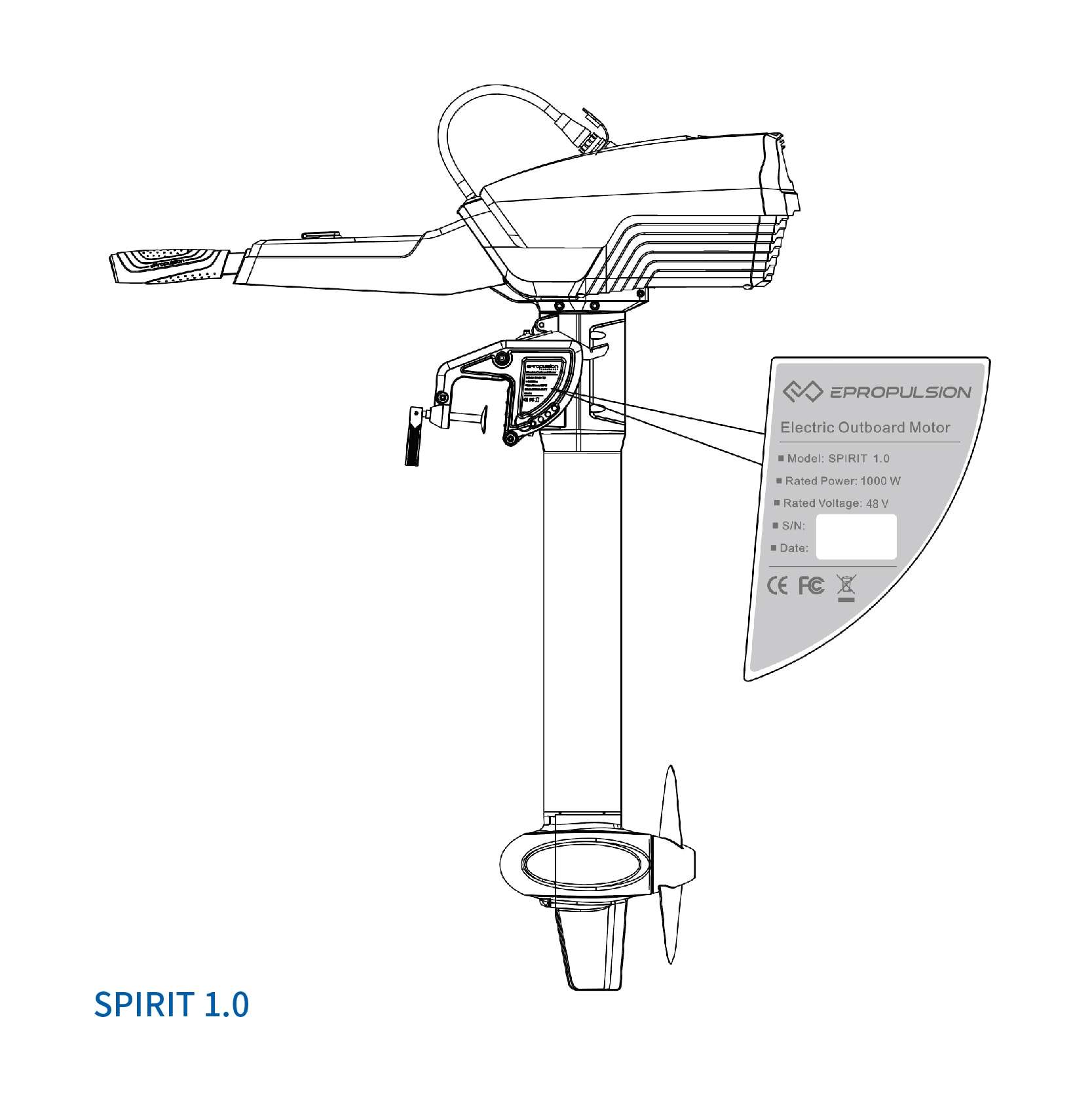

How to Properly Install an Electric Motor on Your Boat

Installing an electric motor on your boat can be a great way to reduce your environmental impact while still enjoying the benefits of boating. However, it’s important to ensure that the motor is installed correctly to avoid any safety hazards or performance issues. In this blog post, we’ll provide a step-by-step guide on how to properly install an electric motor on your boat.
Step 1: Choose the Right Motor
Before you begin the installation process, it’s important to choose the right electric motor for your boat. Consider factors such as the size of your boat, the weight of the motor, and the power output of the motor. Be sure to choose a motor that is appropriate for your boat’s specifications to ensure optimal performance.
Step 2: Prepare the Boat
The next step is to prepare your boat for the motor installation. This may involve removing any existing motor or equipment that will no longer be needed. You may also need to drill new holes for the motor and make any necessary adjustments to the boat’s structure to accommodate the new motor.
Step 3: Install the Motor
Once your boat is prepared, you can begin the installation process. Start by mounting the motor to the boat using the appropriate brackets and hardware. Ensure that the motor is securely attached and that there is no movement or wobbling.
Step 4: Install the batteries
The batteries needed to power the engine must then be installed. Make sure to connect the batteries in the proper sequence and adhere to the manufacturer’s instructions for proper battery installation.
Step 5: Connect the wiring
It’s time to connect the wiring after the motor and batteries have been fitted. This may entail connecting the batteries to the engine as well as any additional electrical devices, such as a controller or charger. To guarantee proper wiring connections, be sure to carefully follow the manufacturer’s instructions.
Step 6: Engine inspection
After installing everything, the engine should be tested. Start the engine and listen for unusual vibrations or noise. Make sure the engine is running efficiently and the electrical system is in good condition.
Step 7: Secure loose ends
Be sure to tie up any loose ends after testing the motor. This includes properly securing all cables, removing debris, and repositioning the motor or battery as needed.
In summary, the correct installation of an electric motor in your boat is an important process that must be performed with care and attention to detail. These procedures will help you install your engine properly and ensure that it operates reliably, effectively and safely.
© 2023 ACEL Power Inc. All rights reserved.
Your survey responses are collected by Acel Power Electronics for analysis, to better serve you. You may refer to the Privacy Notice for more details.
Please proceed only if you accept the terms stated in the Privacy Notice.
Error: This is required.
If so, what specific factor had the biggest impact on your score?
Not listed above (please specify)
please specify
Considering the score and answers you provided earlier, please specify the reason for your score and how we could improve your experience.

- CLASSIFIEDS
- NEWSLETTERS
- SUBMIT NEWS
What size electric sailboat winch do I need?
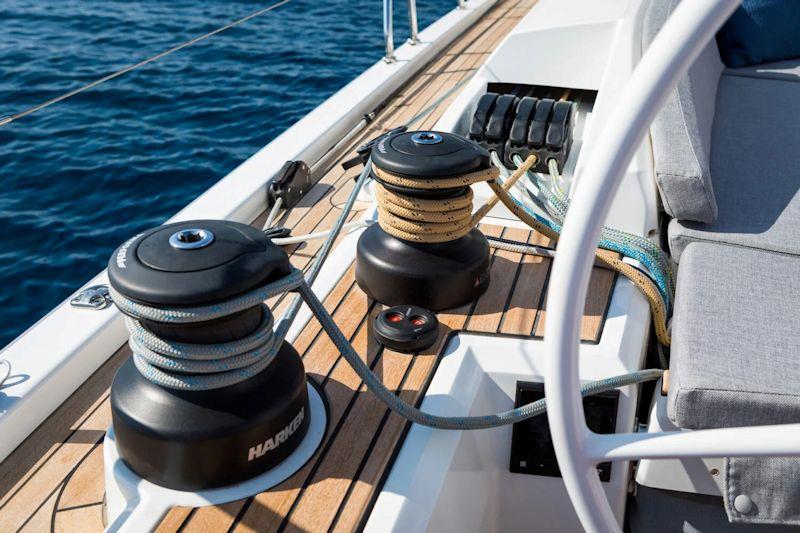
Related Articles
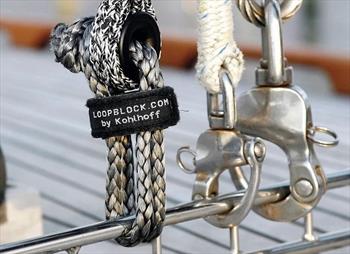

- Subscribe Now
- Digital Editions

Best electric outboard motors: 11 top options for zero-emissions propulsion
- Electric boats
- Top stories
Electric outboard motors seem to be springing up all over the place right now. We round up 11 of the best electric outboards on the market…
Electric outboard motors are nothing new, after all the humble electric trolling motor has been around for decades, but in the past couple of years a new breed of more powerful units has emerged.
Capable of powering everything from a tender to a 50-knot sportsboat, this new generation of electric outboard motors will surely play a big role in the growing trend towards all- electric boats .
We’ve rounded up 11 of the best options available on the market right now to help you track down the right one for cutting down your boat’s carbon footprint.
Compact electric outboard motors for your tender

Torqeedo 603 Travel
Weight: 15.5kg Power: 600W / 0.8hp Battery: 500Wh Range: 11nm Price: £1,499
Torqeedo has been making electric outboard motors for quite a while now, and their latest offering slots into the travel range of electric outboards between the 503 (1.5hp) and the 1103C (3hp).
All the usual Torqeedo refinements are present and correct. IP67 rated as totally waterproof, the 603 Travel has a magnetic kill cord and an onboard computer providing instant readouts of operating range at current RPM and battery-charge status displayed on the tiller arm.
You can link it to an Apple or Android app and gain even more information including a map-based range indicator.
Read more about the Torqeedo 603 Travel

Mercury Avator 7.5e
Weight: 27.1kg Power: 750W / 1hp Battery: 1kWh Range: 34nm Price: $1,500
Announced in early 2022 and launched less than a year later, the Mercury Avator 7.5e is the first electric unit from the world’s biggest builder of outboard engines .
The whole top plate hinges up to reveal the battery, which can be quickly removed from your electric boat or replaced for convenient charging.
It’s by no means the lightest electric outboard motor on the market, but its claimed range at 25% throttle is very impressive – we look forward to putting one to the test.
Not resting on its laurels, Mercury launched the Avator 20e and 35e this summer as well. These units are no bigger than the 7.5e, but need wiring in to an on-board battery bank.
Read more about the Mercury Avator 7.5e
Read more about the Mercury Avator 20e and 35e

Weight: 14.5kg (inc. bracket) Power: 1kW / 3hp Battery: 1,085 Wh Range: 14nm Price: £2,185
The idea behind the Remigo One electric outboard makes perfect sense; rather than mounting the battery on top of the shaft, like the engine on an old-school petrol outboard, the Slovenian company has integrated it into the shaft and shaped it like a rudder to minimise drag and maximise steering effect.
It is backed by a 2-year warranty and has a magnetic key/kill cord. There are some other neat ideas too. The rudder casing is waterproof to IP67 above the water and IP69 below the water so it will survive a dunking, and it’s held in place by a clamp mechanism that allows you to adjust the shaft length to suit your boat with the aid of an allen key.
The transom bracket is separate to the motor so you can leave the bracket attached to the boat and simply slot the motor on and off. The tiller also folds and locks parallel to the blade so you can use it as a perfectly balanced carry handle.
Watch our test drive video of the Remigo One electric outboard

The Kicker is exceptionally light and surprisingly powerful
Thrustme Kicker
Weight: 4.4kg Power: 1kW / 3hp Battery: 259kWh Range: 5nm Price: £1,250
If it’s light weight and value that you prioritise over cruising range, then this Norwegian option is hard to beat.
Launched in 2021, the Kicker boasts enough range and grunt to get one person from ship to shore and back again in calm conditions, as editor Hugo proved in a week-long test.
The only downside is that the battery isn’t removable, which can make charging a little more difficult.
Read more about the Thrustme Kicker

Weight: 15kg Power: 1kW / 3hp Battery: 740Wh Range: Up to 1hr Price: €2,850
A brand new option from France, the TEMO-1000 doesn’t look anything like a traditional outboard motor.
The design doesn’t have any rectangular box on top, just a rudder-shaped shaft with an electric motor at the bottom and a long slim battery that simply slides down into it, connecting automatically to your electric boat without having to plug wires into it.
The tiller arm does the same, meaning it disappears completely when not in use and yet it is never detached and therefore never mislaid.
Read more about the TEMO-1000

Haswing Ultima 3
Weight: 16kg Power: 1kW / 3hp Battery: 1.03kWh Range: 18nm Price: £1,570
A top-of-the-range option from trolling motor stalwarts Haswing, the Ultimate 3 is suitable for boats up to 7m long.
The brushless DC motor produces 3hp (claimed to be equivalent to a 4hp petrol outboard motor), and it’s available in short and long shaft versions as well as the standard length.
Not only is the detachable battery unusually light at 5kg (lightest in class, according to the manufacturer), it also connects to the engine in a single simple operation without the need for connecting cables or other fiddly parts – no bad thing when you’re bobbing about in a tender!
Read more about the Haswing Ultima 3

ePropulsion Spirit 1.0 Plus
Weight: 19.3kg Power: 1kW / 3hp Battery: 1,276Wh Range: 22nm Price: £1,600
The original Spirit 1.0 has actually been in production for six years with over 10,000 units built. Featuring a 1,000W brushless motor, this electric outboard motor is claimed to be equivalent to a 3hp petrol engine, ideal for tender duties or small to medium sized dinghies.
This Plus version, launched in 2020, is the same weight, size and power – the big gain is where it’s needed most, run time. It has been achieved by upgrading the battery from 1,018Wh to 1,276Wh.
At the same time, the power cord has been upgraded for durability and reliability, and the voltage has been changed from 40.7V to 48V, making it compatible with an external 48V battery. The battery will even float if dropped overboard!
Read more about the ePropulsion Spirit 1.0 Plus
Most powerful electric outboard motors for day boats

Yamaha Harmo
Weight: 55kg Power: 3.7kW / 9.9hp Battery: Sold separately Range: Depends on battery Price: £TBC
Announced in 2022 and tested on a 12m Venmar water taxi, the Yamaha Harmo electric boat drivetrain may be a rather modestly powered 3.7kW motor, equivalent to a 9.9hp petrol engine, but it is being seen as a major statement of intent from the Japanese brand synonymous with big, powerful four-stroke outboards.
Intriguingly, the Harmo is neither an outboard engine nor a sterndrive but a new propulsion package that borrows ideas from both camps.
It is mounted on the transom just above the waterline much like a sterndrive leg, but in keeping with the outboard engine ethos it’s an entirely self-contained unit that includes the motor and steering mechanism.
Read more about the Yamaha Harmo electric rim drive

RAD Propulsion RAD40
Weight: 100kg Power: 40kW / 55hp Battery: 20-60kWh Range: 100nm Price: £28,000 (ex. battery)
The RAD40 drive from British start-up RAD Propulsion appears to be far more than just a conventional outboard leg with an electric motor bolted on top.
Every single element of it has been designed from the ground up to maximise the benefits of electric power. The result is a brand new drive system that is not only much cleaner, quieter and more efficient than a petrol outboard engine but also smaller, lighter, cheaper to maintain and even more manoeuvrable.
In its current 40kW guise (equivalent to around 55hp) it’s powerful enough to propel everything from a 25-knot planing RIB to a 10-knot displacement craft but with a larger 160hp RAD120 as well as a portable tiller steered RAD2 already in development, it’s clear that RAD Propulsion has its eyes set on a much wider market.
Read more about the RAD Propulsion RAD40 electric outboard

E-Motion 180E
Weight: 580kg Power: 110kW / 180hp Battery: 70kWh Range: 70nm Price: $78,990
Launched in 2021 by Canadian firm Vision Marine Technologies, the E-Motion 180E looks like a genuine alternative to the 150-200hp petrol outboard motors that power the vast majority of 18-25ft sportsboats and RIBs.
The outboard engine itself weighs around 180kg, compared to 216kg for a 200hp V6 Mercury Verado, but that relatively modest saving pales into comparison next to the 400kg weight of the 70kWh battery pack.
Admittedly, a fair chunk of that will be offset by the lack of fuel tank and starter batteries, but unlike a petrol boat, the battery pack’s weight stays constant whether full or close to empty.
Read more about the E-Motion 180E

The Evoy Storm looks, feels and goes like a well-matched petrol outboard engine
Weight: 350kg Power: 222kW / 300hp Battery: 2x 63kWh Range: 25nm Price: €144,700
Although currently still in development, the Evoy Storm is a working prototype that has already been fitted to a number of partner brands’ boats, including an Iguana amphibious craft and an Axopar 25 that we tested at last year’s Cannes Yachting Festival .
Despite a 450kg weight penalty over a fully fuelled petrol boat, and five passengers, we still recorded a top speed of over 50 knots – vastly quicker than any other electric boat we’ve tested and not far off the world speed record for a production electric boat of 57.7 knots (held by a Goldfish X9 powered by a 400hp Evoy inboard).
The anticipated price for this electric Axopar 25 is €185,000 (ex tax), which looks pretty good value given that the price of the motor alone is €74,900 plus another €69,800 for the batteries. Whether Axopar can maintain, or even reduce, that price once the Evoy Storm enters production in 2024 remains to be seen.
Read more about the Evoy Storm
Tip of the iceberg
If this seems like a lot of choice, there are even more options coming down the pipeline in 2024. MBY understands that several major outboard manufacturers are planning on entering the electric outboard market, so watch this space…
If you enjoyed this…
Be first to all the latest boats, gadgets, cruising ideas, buying advice and readers’ adventures with a subscription to Motor Boat & Yachting . Available in both print and digital formats, our monthly magazine will be sent directly to your home or device at a substantial discount to the usual cover price. See our latest offers and save at least 30% off the cover price.
The world’s biggest electric foiling boat is coming
Galeon 440 fly sea trial: you won’t believe how much they’ve packed in, pardo gt65 first look: 64 footer with expansive foredeck lounge, latest videos, parker sorrento yacht tour: 50-knot cruiser with a killer aft cabin, yamarin 80 dc tour: a new direction for the nordic day cruiser, is this the best compact cruiser money can buy aquador 250 ht tour.
We've detected unusual activity from your computer network
To continue, please click the box below to let us know you're not a robot.
Why did this happen?
Please make sure your browser supports JavaScript and cookies and that you are not blocking them from loading. For more information you can review our Terms of Service and Cookie Policy .
For inquiries related to this message please contact our support team and provide the reference ID below.

IMAGES
VIDEO
COMMENTS
Motor Sizing and Diesel/Gasoline Engine Equivalency. The first step in designing an electric propulsion system is choosing the right motor size. Below is a chart that will provide general guidelines. Contact Electric Yacht, or one of our dealers, for more specific information and assistance in making a selection.
With the Spirit 1.0 Evo electric sailboat motor, you can go 5.5 mph (8.8 kph) at top speed on the 21 ft RS21 sailing boat, or troll for 20 hours continuously at 2.2 mph (3.5 kph) according to our test. This electric sailboat motor with regeneration allows you to recover energy from the prop while under sail.
Boat Size 20'-35' EP-1200 25'-40' EP-2000 32'-48' EP-4000 38'-56' EP-7000 50'-75' EP-10000 Horsepower diesel equivalency Kilowatts (maximum fulll power from batteries) Amps (maximum) Battery voltage DC Batteries (minimum required 12 vdc) Batteries AGM amp/hours 1. Day Sailboat 2. Cruising Sailboat Battery Charger (number and ...
To get the right amount of horsepower needed to efficiently propel a sailboat, divide the displacement of the boat (in lb) by 550. You need approximately 1 HP per 550 lb of displacement or 4 HP per 2200 lb. Most sailboats don't need a motor with more than 30 HP. In this article, I'm talking about small outboard engines for sailboats.
The motor size required for your boat depends on several factors, primarily the vessel's size, weight, and operating conditions (such as currents, open sea, tides). User preference is also a consideration. As a rule of thumb, for displacement vessels, 1kW of electric power can replace approximately 3HP of diesel power.
Recommended Boat Size. Many manufacturers give this as a guide, some don't. We have used the heavier/longer boat size/length. i.e. if an XkW motor is recommended for a 4 ton boat and a 2XkW motor is recommended for a 6 ton boat, we have said that the 2XkW motor is good for all boats up to 6 tons.
Whether your boat is a motor boat or a sailboat, electric or hybrid solutions available nowadays cover a large part of the needs of propulsion energy. ... The storage capacity of the battery pack, for reasons of weight and size but above all for budgetary reasons. The price of the kWh of a good lithium battery with BMS is 800/1000 euross.
Hydrogeneration creates drag of only 0.1 knot at a boat speed of 7.0 knots - so it is barely noticeable. If you can go even faster, the power generation increases exponentially (see GRAPH 1). Buying an electric-powered yacht is still far from an off-the-shelf experience.
MOTOR SIZING, RANGE AND SPEED TIPS: Step 1: Start by selecting motor type, outboard or inboard. Our entire lineup of electric motors power various size boats, plus runtimes and speeds may vary based on variables such as boat size, fully loaded weight, throttle management, types of water currents and battery capacity. Elco's technology is ...
The power necessary to move a boat at a desired speed or to with headwinds depends on many factors : Size and shape of the hull (s) and annexes, Weight, Windage …. theoretical calculations can give you an estimate of resistance/speed. Other factors can significantly influence consumption : Propeller efficiency: 50/55% if you have a good ...
Originally designed as trolling motors for fishing boats, electric outboards are becoming popular for sailboat owners who want clean instant power with less noise and no exhaust fumes. ... "Get the Right Size Trolling Motor", recommends five pounds of thrust for every 200 pounds of a vessel's gross weight 1. Minn Kota says, on their website
OUR BOAT DISPLACES 13,500 POUNDS. SO, 13,500 / 1500 = 9HP ELECTRIC MOTOR. NOW 1HP (OF ELECTRIC) DRAWS ABOUT 750 WATTS. SO, 9HP X 750W = 6.75KW ELECTRIC MOTOR. At 48V, our motor should give us 6.3kW, which is slightly less than what we would need to push our boat to hull speed in calm conditions.
A motor with both forward and reverse gears helps tremendously with docking. While there is no exact correlation between boat length and total weight, the following is a rough guideline: 1-4 HP for boats up to 20' (approximately 1000-2000lbs) 4-18 HP for boats between 20-30' (approximately 2,000-10,000lbs)
35 feet 7.9 knots (9.1mph) With an electric outboard motor, or any kind of auxiliary motor, boat speed depends on the hull type, waterline length, and total displacement weight (including passengers, food, and baggage), as well as the motor thrust. Speed factors also include the waves, current, and wind, relative to your heading.
Electric propulsion can provide speed, range and runtime, but not all at once. An electric boat, motor and battery combination might top 25 mph for an hour. The same boat can also travel more than 50 miles at 6 mph, or longer still at slower speed. That makes the first step in going electric determining how far, in miles, you want to go fast ...
How to Calculate Motor Size. To calculate what size electric motor your boat needs, there are some general guidelines that can help: If your boat weighs between 1,500 and 3,000 pounds and will sail in calm waters at speeds up to 5 mph - choose an electric trolling motor with at least 30 pounds thrust. If your boat weighs between 1,500 and ...
Electric motors come in various sizes, determined by voltage based on the boat's power requirements and the terrain it will navigate. The thrust of the electric motor should match the weight of the boat and the motor combination used. Determining What Size Trolling Motor You Need. Selecting the right size trolling motor for your boat requires ...
30". 10" to 16". 36". 16" to 22". 42". 22"+. 55" (RT Transom) What size trolling motor do you need for your boat? To choose a trolling motor, determine how much power you need (thrust level and voltage) and what size shaft you need.
34" to 44". 72". 44" to 64". 87". The table above shows the recommended shaft length for bow mount trolling motors, depending on the height of the bow above the waterline. Since the height of the bow above the waterline varies a lot from boat to boat, it's important to measure this before you buy a trolling motor.
To get the right size electric outboard motor, you need to consider the boat size (weight/length), boatload, your desired speed, and the boating environment, etc. Generally speaking, a 1kw3hp electric outboard motor is enough to provide a satisfying speed and range for tenders, dinghies, and daysailers up to 1.5 tons, and 6kw10 hp electric ...
Step 1: Choose the Right Motor. Before you begin the installation process, it's important to choose the right electric motor for your boat. Consider factors such as the size of your boat, the weight of the motor, and the power output of the motor. Be sure to choose a motor that is appropriate for your boat's specifications to ensure optimal ...
When choosing an electric winch, there are four main factors to consider: speed (1, 2 or 3), motor placement, drum material and size. In this article, we'll focus on size. Specifying the size of an electric winch is much like specifying a manual winch. The main considerations are application and load. Replacing a manual winch
Specs. Weight: 15.5kg. Power: 600W / 0.8hp. Battery: 500Wh. Range: 11nm. Price: £1,499. Torqeedo has been making electric outboard motors for quite a while now, and their latest offering slots into the travel range of electric outboards between the 503 (1.5hp) and the 1103C (3hp). All the usual Torqeedo refinements are present and correct.
The rear axle has a permanent-magnet synchronous motor exclusive to the Q6 E-Tron, producing 280 kW (375 hp) and 428 lb-ft of torque. It has a two-stage, one-speed transmission.
The indescribable feeling of sitting in an outstanding electric sports car: The new Taycan Turbo GT with Weissach Package takes performance to new heights. The lightweight construction is even more agile. And even faster on the Nordschleife: 7:07.55 minutes.
Audi has unveiled its delayed Q6 e-tron, seeking to restore momentum to the struggling brand with a luxury mid-size SUV as sales of electric vehicles are cooling. The €74,700 ($81,315) vehicle ...